
- High-impact business writing
- Effective email writing
- Bid, tender and sales-proposal writing
- Technical writing
- Writing for customer service

- Customer-service writing
- Effective report writing

Business report writing

How to write an outstanding annual report
Rosie sawicz.
10 minute read

Writing an annual report probably seems like a daunting task, with lots of requirements and rules. And if it’s a task on your to-do list, take heart that you’re not alone: many companies have to produce one at the end of each financial year.
Here’s the good news: an annual report doesn’t have to be a dry, boring list of numbers and corporate jargon. This document offers an excellent opportunity for a company to stand out from their competition.
With the right amount of thought, preparation and good-quality writing, your company’s annual report can (and should) represent what’s great about the place you work and the work you do.
So, where to start? Luckily, we’re here to help.
What is an annual report?
An annual report describes a company’s performance over the previous financial year. It also provides a window into your company’s culture and brand, as well as the people who work there and why the business is special.
Essentially, the document should be a one-stop-shop showcase of the company’s performance and operations. Its core aim is to inform stakeholders and build their trust.
Many companies approach their annual report strategically, aiming to stand out from their competition and win over their target audiences with a compelling narrative. And many employ the latest in digital technology and graphic design to create reports that are innovative in both their design and content.
The information in the report should allow shareholders to assess the company, its current situation and its potential future. There are legal requirements for what should be included and many regulations on financial reporting. A UK-listed company’s report usually includes the following:
- A strategic report , which allows companies to tell their story. Officially, this section shows how the directors performed their duty to promote the company’s success that year. It should include information about a company’s strategy, objectives and business model.
- A corporate governance section , which explains how the company’s operations support the achievement of its objectives. This section includes a directors’ report, corporate governance report and committee reports.
- Financial statements , which include policies and implementation, amounts awarded to directors, and audited financial statements such as balance sheets, income statements and cash flow.
What are the rules?
There are frequent regulatory changes which affect the annual report, and it’s important that you understand the up-to-date requirements for an annual report at your particular company and location. Your company’s legal and accounting teams will be able to guide you on this.
Publicly listed companies in the UK must produce a report for their shareholders at the end of each financial year. There are various rules that must be followed around the content and distribution of a UK annual report, like mandatory sections to include and certain groups who must receive a copy.
These rules are determined by strategic report regulations and the UK corporate governance code, and you can find helpful information on this through the Financial Reporting Council .
Other types of companies and organisations outside of the UK may also have to produce annual reports, depending on their size, location, tax status and local laws, which can vary according to country or state.
Who writes the annual report?
Who writes a company’s annual report varies depending on lots of factors, including the size of the company. There are a few options and each requires planning and project management:
- Outsource: Some companies choose to outsource their annual reports to specialist agencies. In those cases, there’ll often be an in-house project manager to coordinate with the internal teams who’ll be providing the core material, such as the secretarial, finance, legal and investor relations teams.
- Teamwork: Many companies have their own in-house writing and design team(s) who would likely take a big role in content writing. For the more specialist aspects of the report’s content, annual reports are often a team effort. Experts from across a company will provide their unique insights for things like notes on the accounts and the vision for the company’s future.
- One person: In some smaller companies, one person might collate and draft all the content before presenting it to their stakeholders for review.
The UK also has laws which cover the content sign-off process after the report’s content is finished. As noted in section 414(1) of the Companies Act 2006 , ‘[a] company’s annual accounts must be approved by the board of directors and signed on behalf of the board by a director of the company.’
No matter how your company approaches the writing process and how many individuals contribute content, do your best to end up with a unified style and voice.
This will probably mean ensuring that your company has an up-to-date and comprehensive style and tone of voice guide , an eagle-eyed proofreader , and an agreed approach to creating clear, accessible writing throughout.
How to prepare
An annual report can be a huge, complex document which requires input from a wide range of people. Work begins long before the content-gathering phase; often it’s something you’ll be thinking about all year round. Preparation is crucial to do your best work and ensure a well-rounded document.
Overview of the process
To help kick off your planning, here’s a high-level look at the steps you’ll need to follow to create the annual report:
- Work out your timeline and plan content
- Establish your structure and make a page plan
- Write a list of contributors and gather content
- Write and collate
- Check the draft and send for review
- Allow for multiple rounds of feedback
- Finalise content and send for design
- Proofread and check everything
- Get sign-off from the board of directors
And here are some further things you’ll want to do in advance:
Consider imagery: Another element to think about well ahead of writing the report is photography.
Work closely with your communications and/or marketing teams to ensure that the annual report is considered all year round. This can mean something like ensuring that significant events are photographed and the images are collated with information for captions. This will make your life much easier in annual report season.
Assess your competition: Look at what your competitors are doing and find examples of excellent annual reports. This will provide inspiration and enable you to help your company stand out from the competition.
Know your audience: Keeping the audience in mind is a big step in how to make your annual report interesting . Your demographic will depend on the work your company does.
Although an annual report is primarily aimed at existing shareholders, it’s also a useful way to attract new investors, advertise the company’s products or services, and even entice future employees. While you’re preparing and writing your annual report, make sure you focus on the needs of these audiences .
If your company has an international audience, you might want to consider translation into other languages, and printing and distribution to the relevant markets.
Writing the report
Since there are strict regulations around the financial and corporate governance sections, the bulk of your more creative writing work will be in the strategic report . So that’s what we’ll focus on here.
The strategic report reflects the board’s view of the company to the shareholders and provides context for the financial details elsewhere in the annual report. The writing here should be clear, concise, in plain English and presented without bias. The general tone should be forward-looking and in line with your company’s voice.
There are no specific rules on the structure of a strategic report, as it should reflect the company and the content of the report itself. Each company’s requirements may differ depending on size, type and location. However, many companies take an approach like this:
1. Opening statements
An annual report may open with a chairperson’s and/or CEO’s statement. These are written in the voice of the individual (and may be ghostwritten for them) and are often accompanied by a professional photograph of that person.
The written content addresses the shareholders and provides a summary of the details to come: significant headlines from the past year, a brief overview of the financials, challenges and successes, and potential future growth.
Although this section comes at the beginning, you might find it easiest to write it last. By that point, you will have gathered all the strategic report content and can summarise it into the introductory letter. If you’re writing in another person’s voice, it’s doubly important to get their sign-off.
2. Business overview
This section explains what your company does and is key to showcasing the company – your opportunity to tell your company’s story . It should contain an overview of the company, including its vision, culture and mission statement. It should also include information on the company’s:
- products or services
- business model
- directors (details on them and their duties)
- investor profiles
- competitors
- non-financial key performance indicators
- potential risk factors.
And it’s a great idea to include case studies and any highlights from the year here.
This is the section which will hopefully be the easiest to collate and update, as it’s information that should be available in your website, brochures, reports and other public-facing materials.
3. Financial review
The financial section presents a comprehensive analysis of the business’s performance over the financial year and its position at the close. It should refer to and explain the figures included in the financial statements.
This section will be an important focus for your stakeholders, so clarity and honesty are very important. Make sure all data is backed up with sources. And be sure to communicate a strong understanding of your company’s strategy and key performance indicators, and find ways to present data in engaging, visual ways, paired with impactful quotes.
4. Disclosures
There are frequent emerging trends in corporate disclosure. These may come from changes in regulations or simply in the expectations of readers. (And, as before, even actual rules may apply only to certain types or sizes of companies.) What goes into a strategic report will also need to shift to align with these wider changes.
It’s a good idea to investigate and include any newly emerged focus areas in corporate reporting, such as:
- sustainability
- anti-corruption
- anti-bribery
- environmental impact
- gender diversity of employees and directors
- social and community issues
- human rights issues.
Finally, finish with a strong call to action: what do you want your audience to do when they finish reading this report? Consider your audience again, and whether you want them to invest, apply, donate … anything!
Common challenges with writing annual reports
As we’ve noted, writing an annual report can be daunting. It’s a large document with lots of rules and regulations behind it, and it can have a big impact on the future of the company and its shareholders.
Here are some common challenges and how to tackle them:
- Multiple contributors: working with large numbers of contributors is tricky, and it’s important to put your project management hat on. Make sure you identify and alert your contributors ahead of time, issue clear briefs and deadlines, and ensure a consistent style despite lots of authors.
- Version control: multiple authors and rounds of feedback mean multiple versions of the document. It’s important that one person keeps a tight oversight on version control to ensure no work is lost and nothing slips through the net.
- Lots of rules and regulations: this one can be intimidating, especially when you’re faced with technical jargon or even actual laws instead of a simple search result to answer your question. Don’t be afraid to ask the experts: your company’s legal team are there to help.
- Lack of planning: As we’ve said, preparation is key to success. If this year was a bit of a rush or mistakes were made, make sure you debrief and learn from what happened, so you don’t repeat the same problems next year. And if in doubt, start early!
Creating a stand-out annual report
Although some annual reports can be dry documents full of financial tables, yours doesn’t have to be.
Remember this is an opportunity to show shareholders and future colleagues why you care about the work your company does.
Good preparation is your greatest ally here. Beyond that, you’ll need to enlist the help of colleagues across your company, maintain your in-house style and engage your creativity. That way, you can ensure your company’s annual report stands out from the crowd, with excellent writing from start to finish.
We’ve helped both individuals and teams with their annual reports through our one-to-one coaching and in-company training . If you’d like our help with writing your own, just get in touch .
Image credit: SvetaZiO / Shutterstock

Your go-to guide to better writing
Get your own PDF copy of The Write Stuff , the definitive guide for everyone who writes at work.

Rosie is a writer and editor who has worked in corporate communications in a variety of environments, from national libraries and global aviation services to international law firms and renowned research projects. She specialises in facilitating internal comms and in her career has ensured organisations communicate effectively across networks of over 32,000 employees in 34 countries. Rosie is also a published novelist: she writes psychological thrillers under her pen name Rosie Walker . She also provides editorial services (developmental editing, copy editing and proofreading) to fellow authors.
Was this article helpful?
This helps us make better content for you

You might also like

Can you use the first person pronouns ‘I’ and ‘we’ in a report?

Business writing essentials
Plan and research your documents with mind maps

See into your reader’s mind with ChatGPT

Writing corporate communications
A practical guide to creating brand tone of voice guidelines (that people will actually use)
Get expert advice, how-tos and resources for good writing (and great work).
Business growth
Business tips
11 annual report design examples and how to design your own (with template)

But the report isn't just fun and creative—it also tells a story. It says, "Not only are we confident in our performance and our brilliant communication, but we also care deeply about our customers and the world at large." How does it do this? Through bold, colorful statistics about employee benefits and the company's social justice efforts.
The primary purpose of an annual report is to analyze your organization's performance over the year, but it's also an opportunity to share your brand's identity with stakeholders, whether those be customers or investors. After looking through dozens of reports, I unpack my favorites below, as well as how to live up to their caliber.
11 captivating annual report examples
The following organizations have proven that annual reports aren't just a bunch of numbers to nod and smile at.
1. 2022 Everlane Impact Report
For sustainable fashion retailer Everlane, it's just as important to communicate ethical goals and accomplishments as it is to report on financial success.
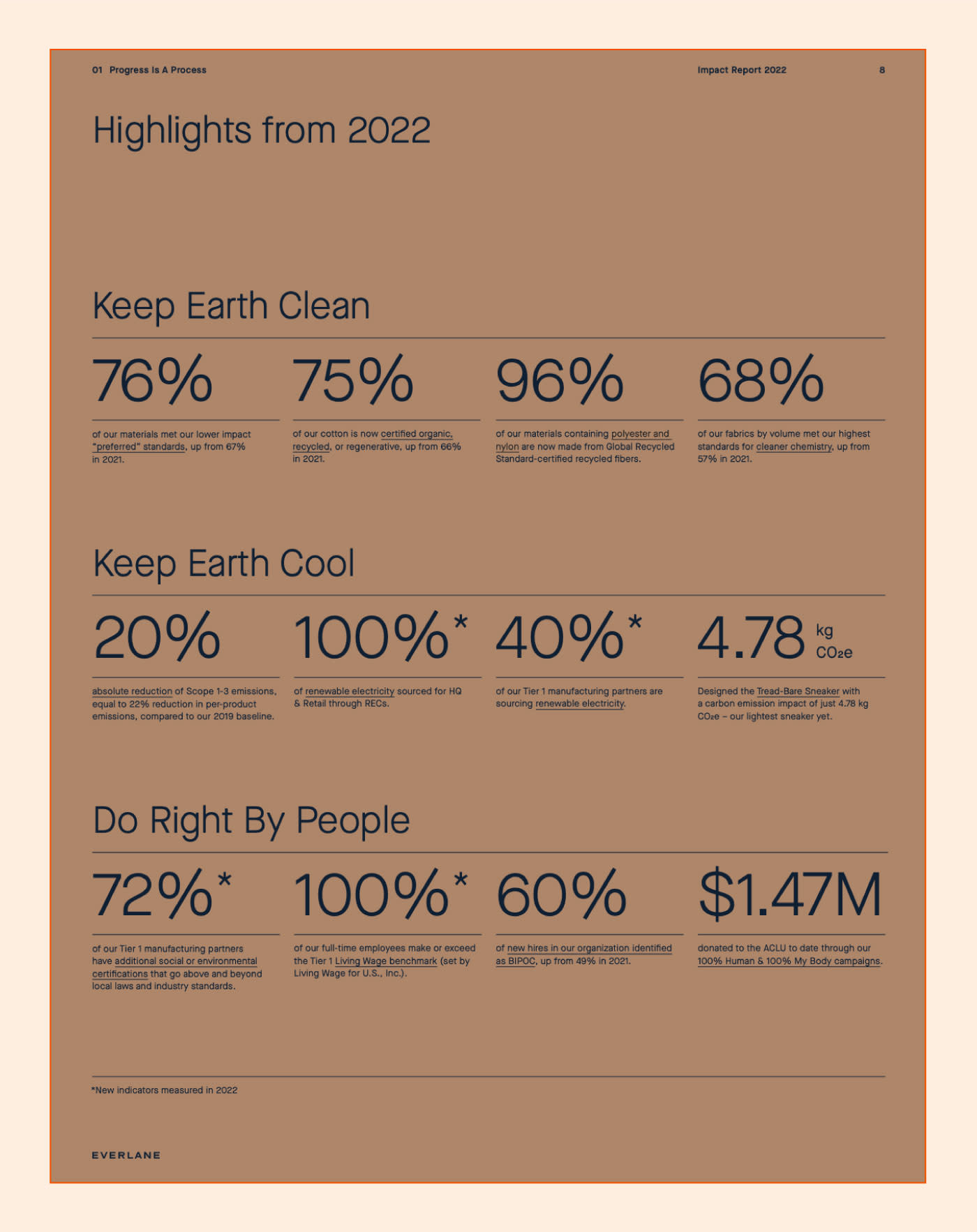
From a design perspective, natural tones dominate the report, echoing the brand's commitment to eco-friendliness. No hot pinks or neon turquoises in sight—just forest greens, deep-sea blues, earthy browns, and other natural tones. Overall, the report successfully models how to use design to communicate brand image.
If your brand is committed to an ethical cause, be transparent about how you're tracking toward that cause.
Keep your color scheme consistent with your brand image.
2. The Trevor Project's 2020 Annual Report
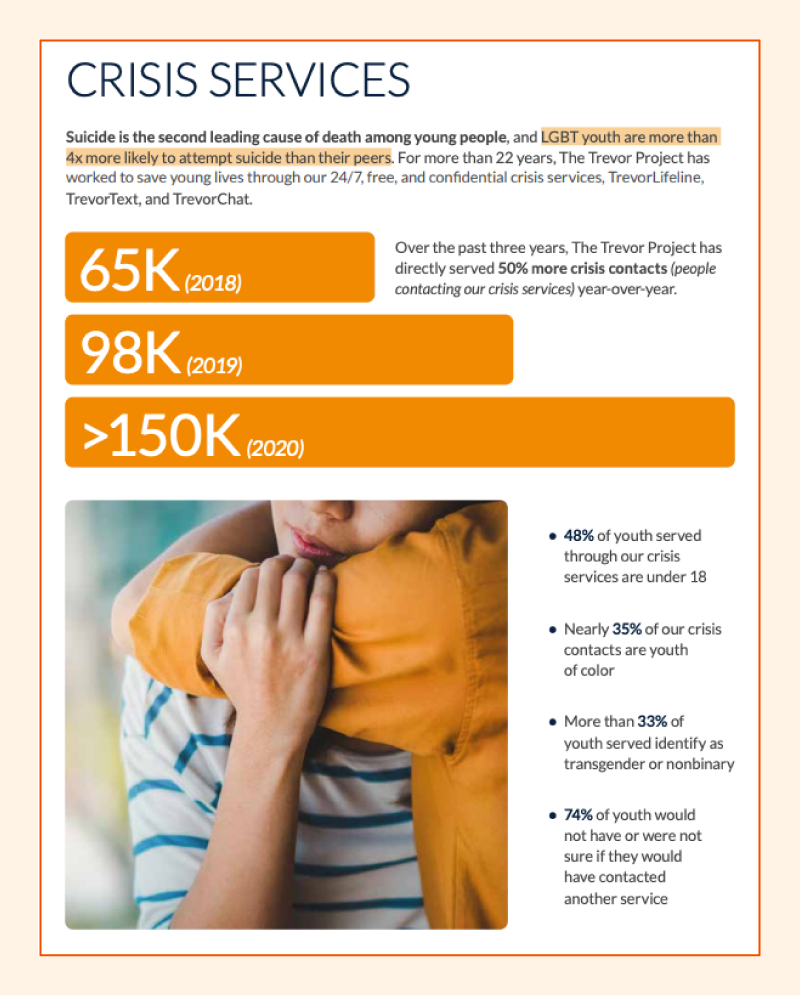
The report uses large headers, bullet points, highlights, and strategic bolding to present how they're working to innovate, educate, and advocate for young members of the LGBTQ+ community.
Not all data evokes sunshine and butterflies, and The Trevor Project's report uses a clean, streamlined design to keep the focus on what matters most to them.
Keep copy light and succinct wherever possible.
Call attention to your most important points through bolding, headers, and bullet points.
3. Mailchimp's 2020 Annual Report

The report highlights the company's success statistics, philanthropic efforts, fun facts, and some customer case studies, creating unique, colorful worlds for each of these sections.
Mailchimp is known for innovative communication solutions, and their annual report design is no exception. Overall, the company reminds us that business and fun don't have to live in totally separate realms.
Implement interactivity to keep your readers engaged.
If doing so aligns with your brand image, creatively convey data using color and animation.
4. USAA's 2021 Annual Report to Members
The report's Business Snapshot page is inspiring and professional, using large text and bolding to communicate some of the organization's must-know stats from the year. Even if you didn't read the text on the page, the color scheme alone makes it clear that USAA is a military-serving institution.

The report also includes a timeline walking through how the organization has grown over a century—a feature that, for obvious reasons, makes an impact. Not too many brands can boast a hundred years of serving their customer base.
The report's imagery evokes an emotional reaction, depicting tender moments between servicemembers in uniform and their families. All in all, the report's endearing photography, bold typography, and use of colors associated with the military (like deep navy blue) effectively communicate USAA's mission.
If your organization has a long history, use that to your advantage with timelines.
5. adidas Annual Report 2020
The user's entire browser transitions with every scroll, each view summarizing a key takeaway and offering a link to additional details. This keeps things simple for the user while still making all important information easily accessible.

a didas is known worldwide for its influence in the athletic footwear and clothing industry, and its report's bold use of red and black, as well as its moving imagery, echo this reputation.
If relevant, include photography of your audience or market.
Get creative with UX both in your report's landing page interface and in any supplemental tools you share.
6. Google Diversity Annual Report 2022
You may think that Google, being one of the most successful tech giants in the world, doesn't have much growing to do. But their report's tone suggests they do—and they're working to improve every day.
Much like adidas, Google summarizes its most important efforts and wins while offering a link to a more extensive PDF report. Through and through, the report is clean and easy to digest.
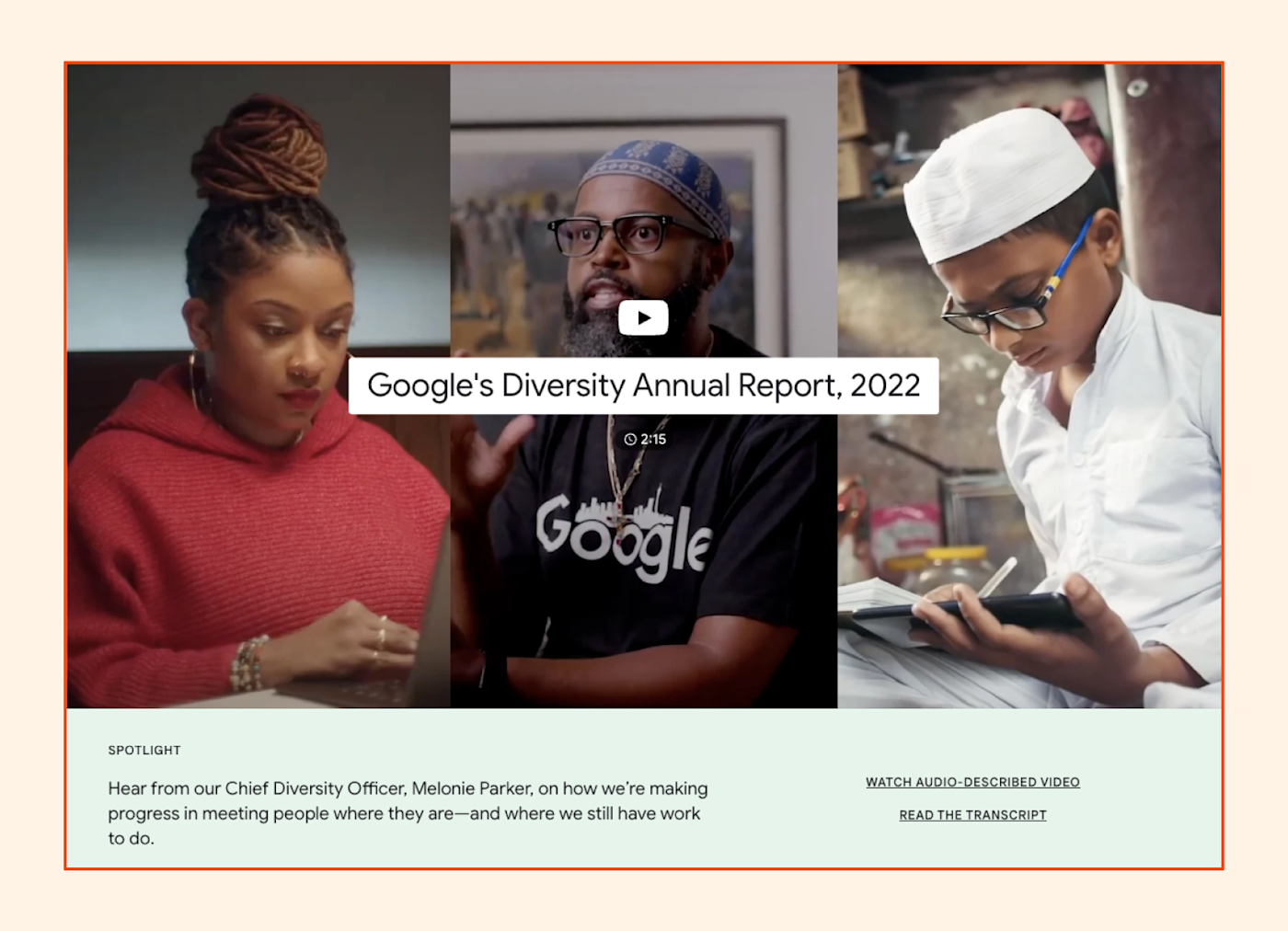
In a unique take on the letter from leadership, Google's report embeds a video in which Chief Diversity Officer Melonie Parker discusses the company's progress in hiring and creating products with diversity in mind.
Overall, the report's clean, clear, and data-driven design speaks to the company's mastery of technological expertise and human communication alike.
Keep your voice and tone consistent with your brand image while aiming to sound human and approachable.
Use creative content formats (like videos) to communicate with your audience.
7. Conservation International's 2021 Annual Report

The report's cover reads: "Not a moment to lose," followed by the deadlines the world has to get its act together. In a brilliant continuation of this theme, the report shows page numbers in a digital stopwatch format, as if each page represents a second in the countdown toward climate disaster.
Anxiety inducing? Yes. Effective? 100%.
The report also incorporates breathtaking photography of nature and wildlife, showcasing what the organization aims to protect.
Design a cover that grabs your readers' attention from the start.
Evoke an emotional response using real-life photography.
8. World Bank's 2023 Annual Report
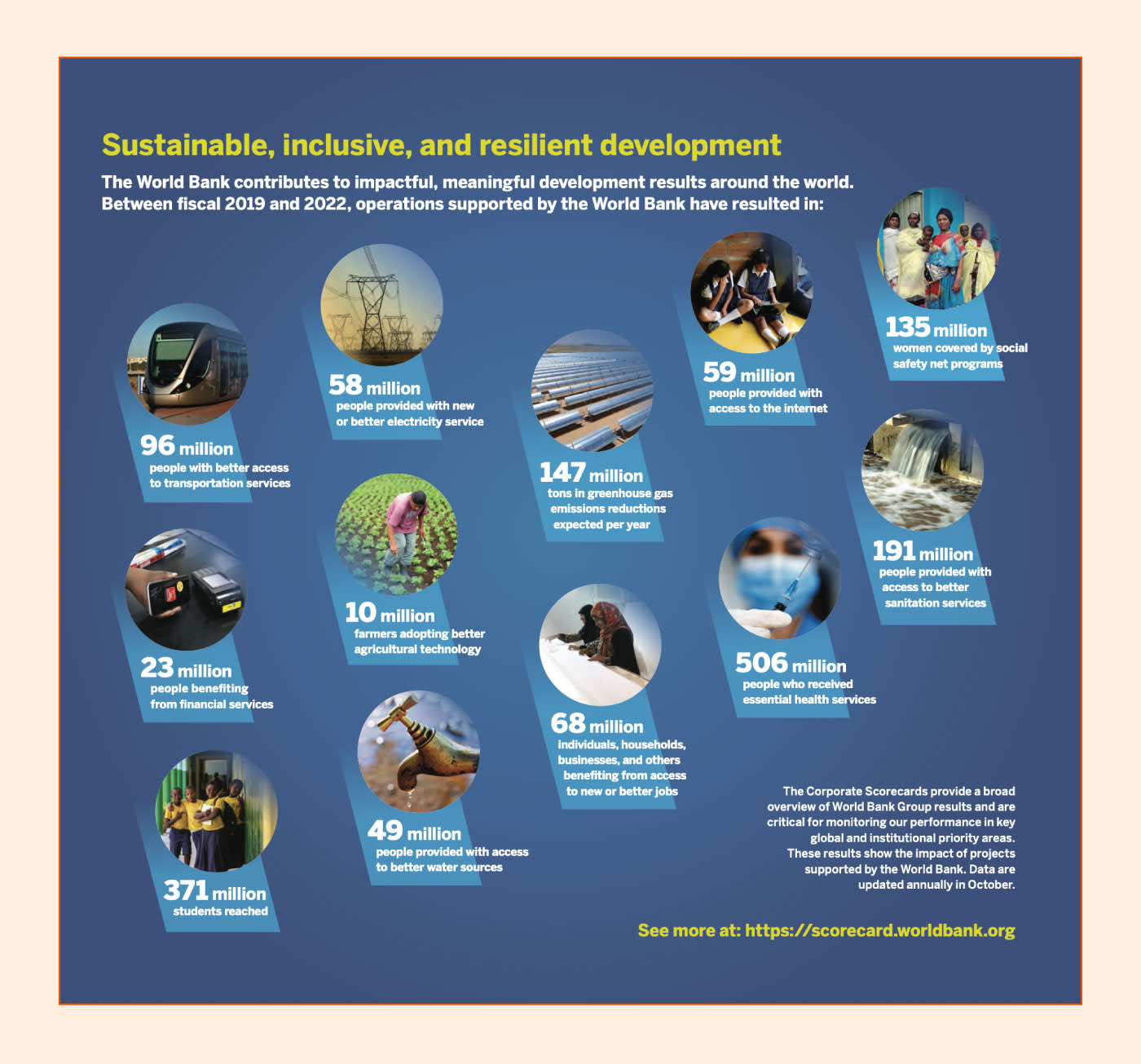
The report leans heavily on storytelling photography that humanizes the brand and the ideas within the report. It does an excellent job presenting its achievements as well as its mission to support countries in times of crisis, help develop their infrastructure, and improve the quality of education and health care worldwide. The cover and the first few pages tell a story that I didn't expect from a government entity. I expected pages oversaturated with charts, a heavy focus on revenue, and very little relatability. Instead, they managed to change my perspective on the organization almost immediately.
When bureaucracy is the name of the game, design and engaging content usually take a backseat. This is a mold that World Bank manages to defy and reshape.
Use your report as an opportunity to debunk any common misconceptions about your brand.
Speak to your achievements as simply and directly as possible.
9. Habitat for Humanity's 2022 Annual Report
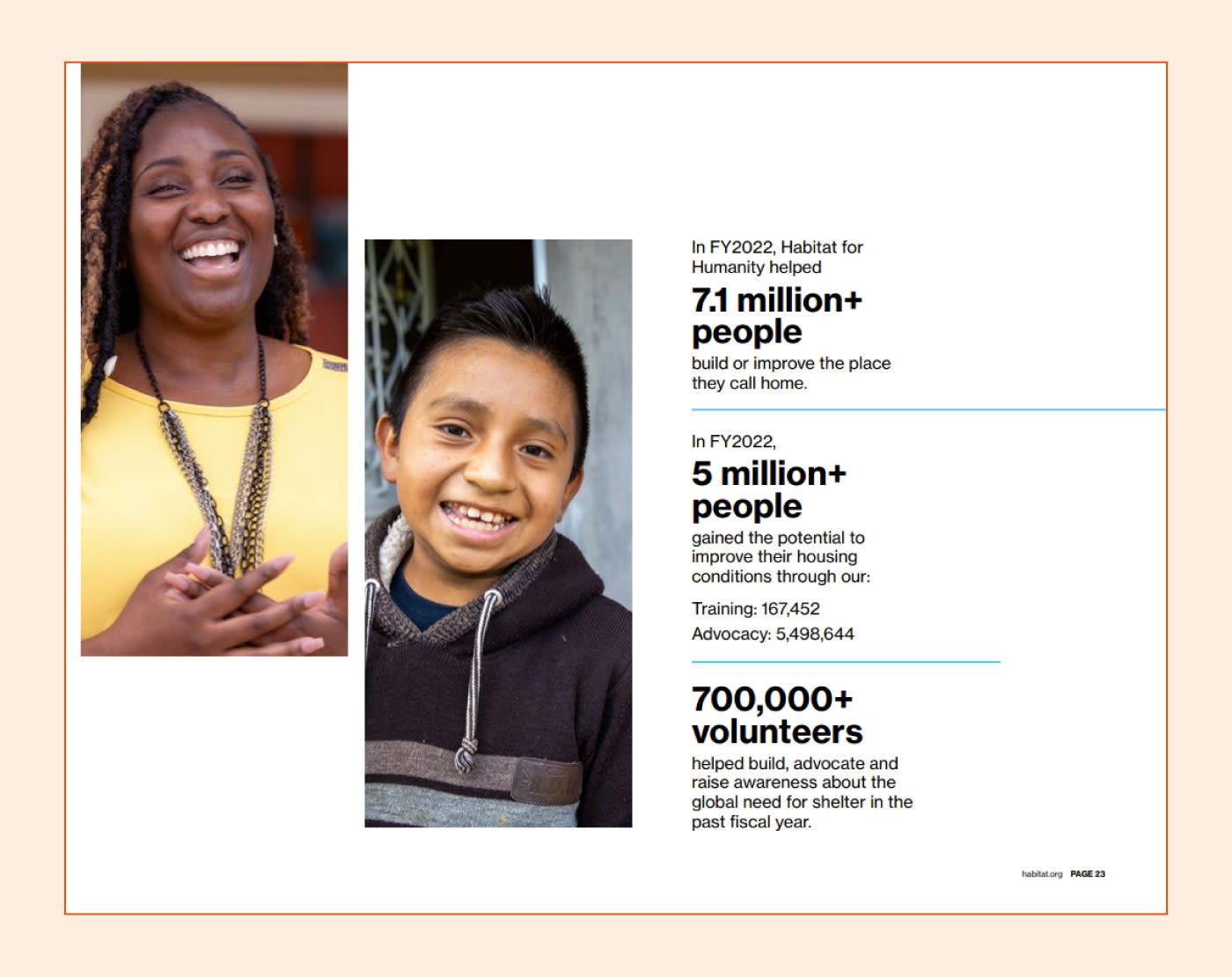
Habitat for Humanity also goes the extra mile with its delivery, providing both a downloadable file and a dynamic webpage that highlights key points from the full report. This gives busy stakeholders access to an overview that they can quickly digest.
Get creative with your report delivery method. Highlight the most important points from the report through interactive or dynamic webpages.
Prioritize real stories and examples, as they create a personal connection with the reader, making your brand more approachable.
10. Salesforce's 2022 Annual Report
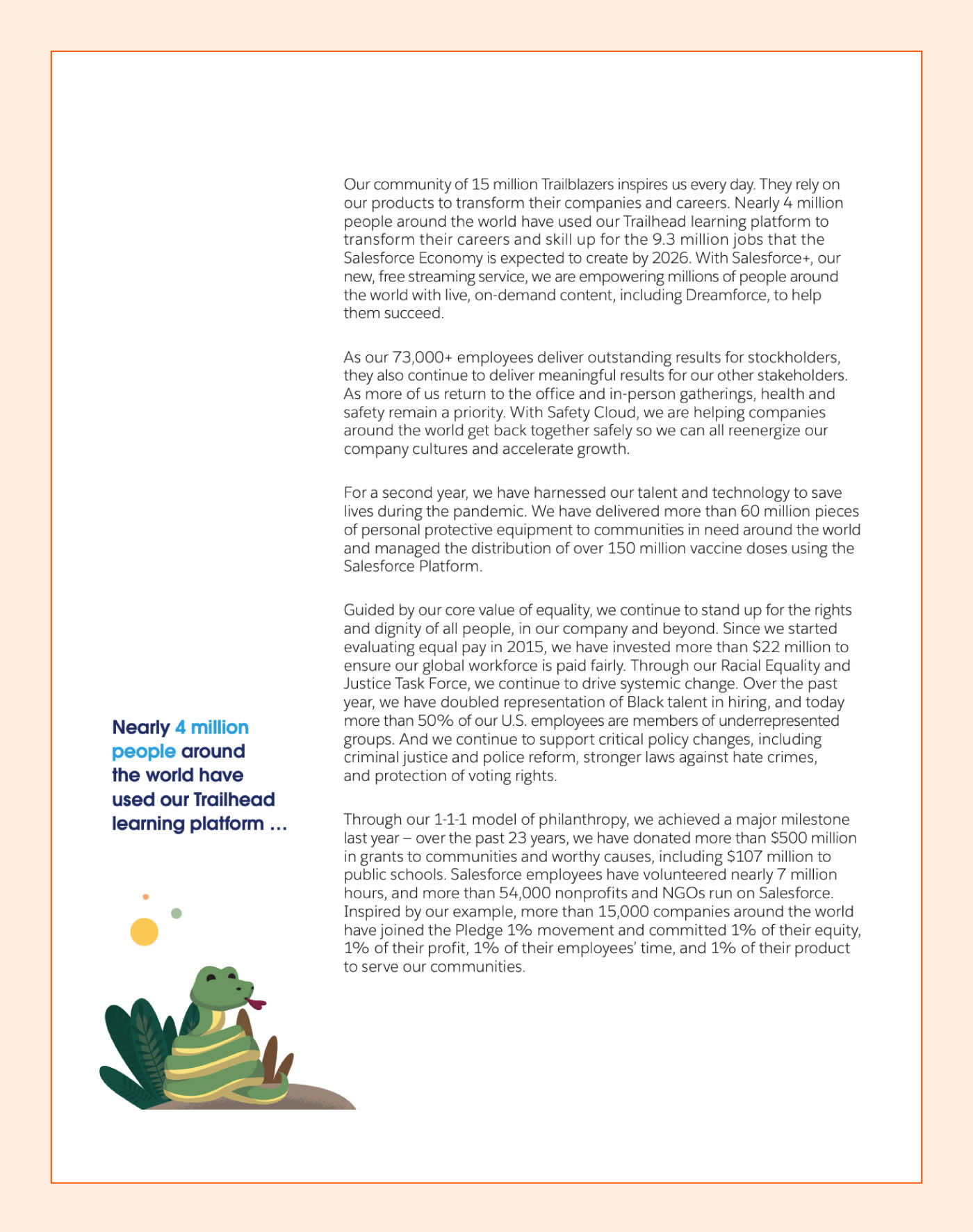
I was particularly impressed with its clever use of margins—instead of filling up the void with colors and shapes that may or may not stimulate the reader, Salesforce filled the space with achievements and stats instead. These little nuggets of information are eye-catching, effectively summarize important contents, and keep the reader engaged.
Keep the report's style and color scheme consistent with your branding and public image.
Make use of otherwise empty space on the page to deliver key information in digestible pieces.
11. Subaru's 2022 Integrated Report
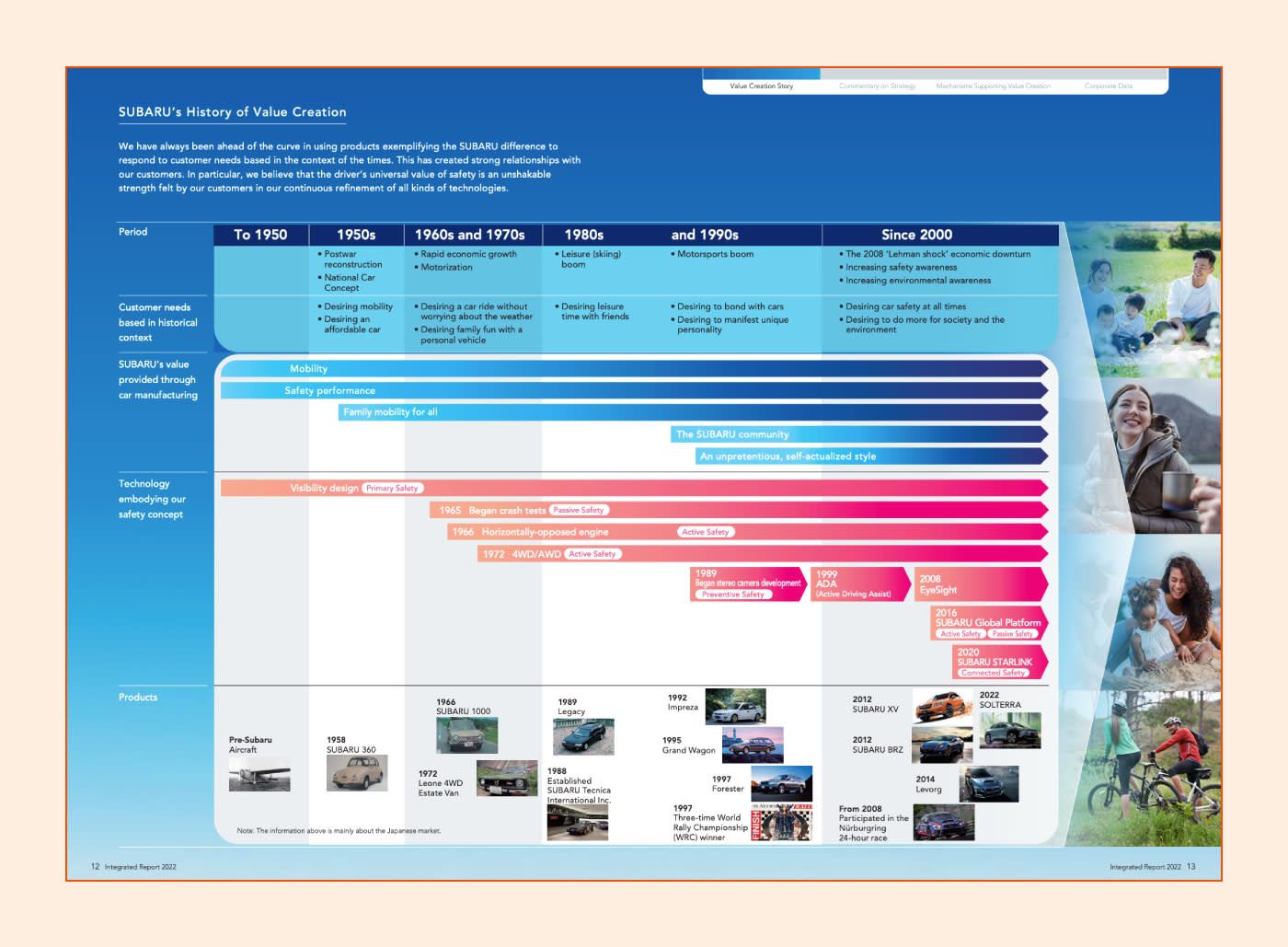
Sure, it's packed to the brim with information, but its presentation, utilizing charts, graphs, and creative roadmaps, keeps stakeholders engaged.
Be flexible in how you communicate information—it doesn't have to be a wall of text.
Annual report template
It's one thing to be impressed by an annual report—it's another thing to create one. I had my designers put together an annual report template that you can use as a foundation to build your own.
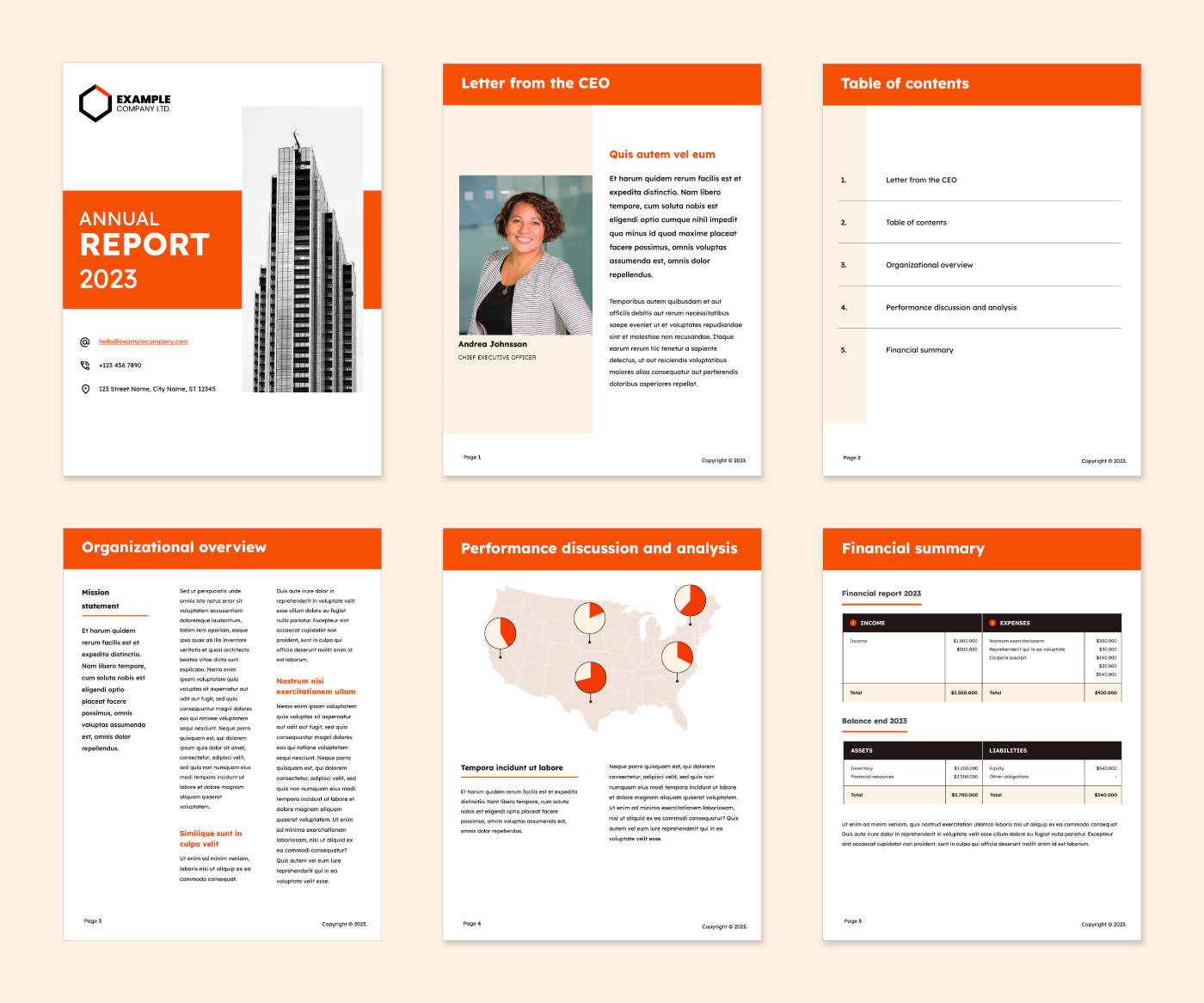
How to design an annual report
If you want to impress your audience with your annual report, you can't cut corners. Here are some tips on how to live up to the above examples.
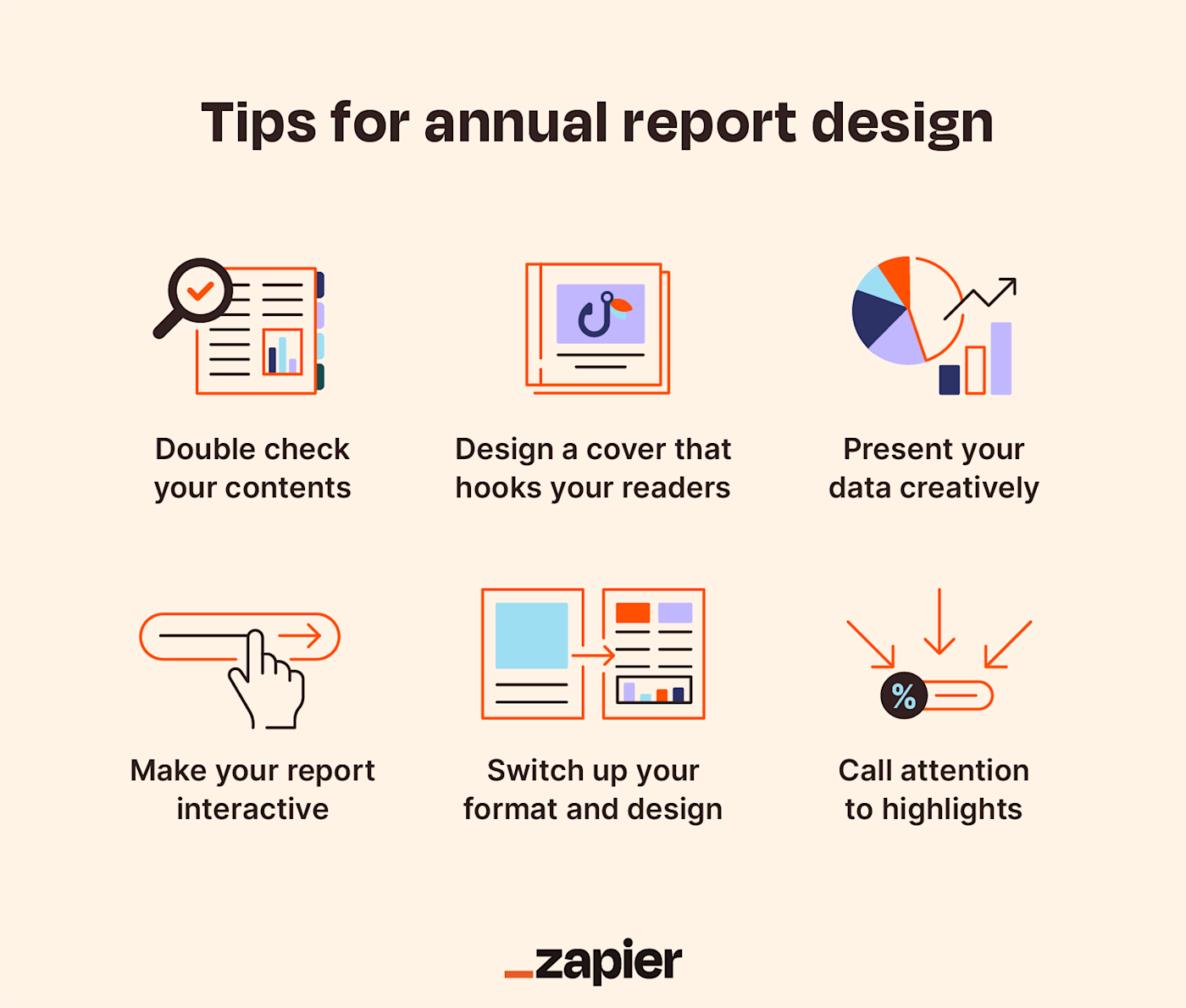
1. Include all relevant sections
Before worrying about your report's look and feel, confirm it contains the following sections:
Letter from the CEO or other leaders: This is leadership's opportunity to briefly tell stakeholders your organization's story and summarize some key wins, as well as what's to come moving forward.
Table of contents: Annual reports tend to be 30+ pages long, but nobody has time to read an entire report from cover to cover. Make things easier for your readers by including navigation like a menu or a table of contents.
Organizational overview: Hopefully, you spent more than five minutes developing your organization's mission statement. Now's your time to share some highlights about who you are and what you do with your stakeholders.
Financial summary: Every annual report should include the organization's financial statements, breaking down your profits or losses over the year for stakeholders and potential investors.
2. Captivate with the cover or landing page
Your report's cover should tell a visual story that grabs the reader's attention and sets the tone for the rest of the report.
While many of the above reports execute this well, I'd argue Conservation International's cover edges out the others. It ropes readers in with nothing short of a stark warning, then proceeds to lay out what they're doing to protect the Earth (and what still needs to be done).
3. Include data visualizations
Even educated professionals and subject matter experts prefer organized, color-coded charts and graphs to numerical data that reaches the nth row of an Excel spreadsheet. This holds especially true for potential investors who may know very little about your industry.
Of course, it's important to implement data visualizations in moderation and to add context to the ones you include, keeping your report readable and accessible to everyone.
4. Implement interactivity
Have you ever listened to a tour guide talk about an exhibit for 20 minutes without asking the audience any questions? I almost have, but I fell asleep after 15.
When something encourages action, it's more likely to hold a user's attention. Mailchimp's report integrates a moving character, pop-ups, clickable elements, and mini-games to keep the user scrolling and engaged.
5. Bring attention to what's important
An annual report's format and structure should call attention to its key points. Your goal shouldn't be to fill every bit of white space with text. Add a summary page before each section highlighting what's to come. Use large fonts, color, and bolding to call attention to your organization's most impressive stats.
6. Surprise your readers
While stylistic consistency is important, don't be afraid to mix up your formatting frequently throughout your report. A sudden color shift, a fresh new data visualization, or a cover page with a lot of empty space can keep readers engaged and wondering what's to come. Nobody likes a boring report—surprising elements can add some excitement while still telling your brand's story.
Corporation vs. non-profit annual report design
Your annual report design should look different if you're a non-profit than if you're a corporation. Non-profits are heavily mission-focused and should aim to fundraise with their annual report design, perhaps using emotional imagery and inspiring goals. Corporations, on the other hand, should center their reports around their progress toward profit goals and should command the attention of investors.
Regardless of what type of organization you are, remember to leverage your strengths in your report. Do you have a long history like USAA does? A timeline of your progress over the years could be a powerful visual. Do you operate in several countries? Consider adding a map that illustrates your expansiveness.
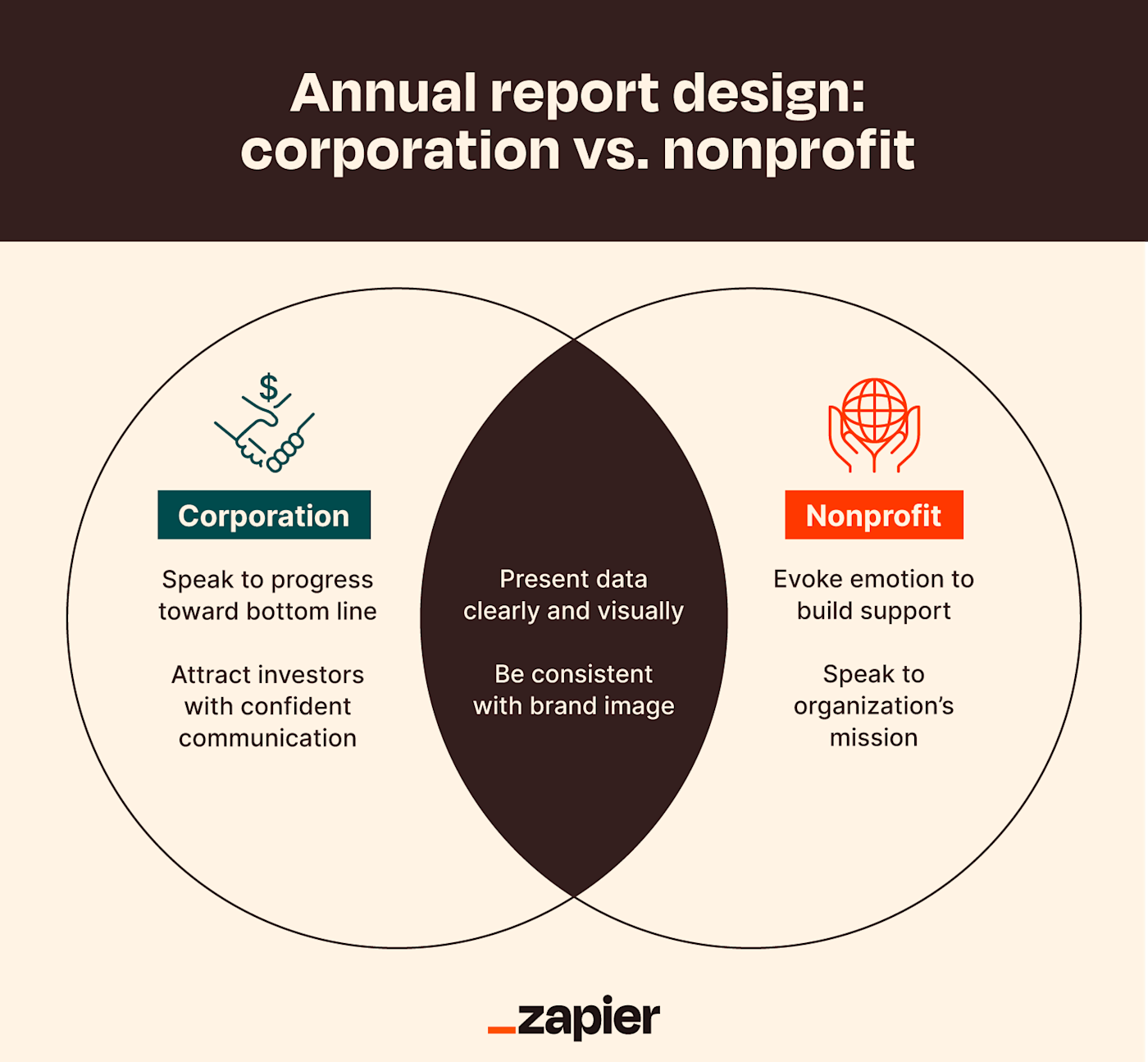
Streamline reporting with automation
Annual reports pose an opportunity to get creative with how you communicate your brand's identity, but they also serve an important purpose: impressing your audience. As you get started, remember to strike a balance between creativity, content, and clarity.
Related reading:
This article was originally published in September 2022 and has since been updated with contributions from Hachem Ramki. The most recent update was in October 2023.
Get productivity tips delivered straight to your inbox
We’ll email you 1-3 times per week—and never share your information.

Luke Strauss
Based in sunny San Diego, Luke is a digital marketer with 3+ years of experience developing and executing content strategy for eCommerce startups and SaaS enterprises alike—Airtable, Zoom, and yes, Zapier—to name a few. When he isn’t diving into a keyword research rabbit hole, you can find him at a music festival, thrifting, or spending time with his friends and family.
- Data & analytics
Related articles

How to start a successful side hustle

11 management styles, plus tips for applying each type
11 management styles, plus tips for applying...

Keep your company adaptable with automation

How to enrich lead data for personalized outreach
How to enrich lead data for personalized...
Improve your productivity automatically. Use Zapier to get your apps working together.

How To Design An Annual Report [+ Template & Examples]
Updated: August 18, 2021
Published: April 08, 2021
An annual report offers a comprehensive overview of your business’s yearly operations. As the content in these reports is heavy-hitting, it’s essential to present it in a way that helps your audience understand and visualize your successes.

These reports also incorporate various design elements that support your metrics and create a unique, creative, and visually appealing story of your business activities.
In this post, we’ll outline annual report design best-practices, provide a template you can use to create your own, and go over examples of annual reports from other businesses that you can use for inspiration.

What is an annual report?
As a refresher, an annual report is a document created by businesses that display yearly performance, including successes and challenges. It gives a big-picture view of operations and strategies while also going in-depth on key performance metrics.
Annual reports differ from weekly reports in that they address anything and everything that has happened over the past year, including content you’ve already mentioned in weekly, monthly, or any other style of report you’ve made.
Designing an annual report is a careful process, as it is crucial to find a balance between powerful graphics and clarity and understanding. Most reports contain data visualizations, like charts and graphs, to enhance the experience and really call attention to heavy-hitting metrics.
Below we'll provide a template that you can use to design an annual report for your business and outline the sections that should be included in every report, regardless of industry.
Annual Report Design Template
The template you choose to use to design your annual report should be based on your individual business needs and the metrics you’re hoping to include.
However, you can adapt most templates to fit your business needs, like this template offered by HubSpot. The image below features two pages from the downloadable template, including a company overview and a yearly performance analysis.
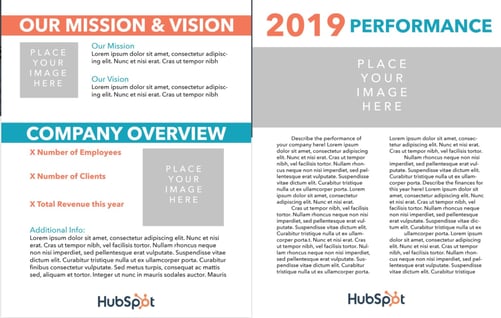
Image Source
The template allows you to go in-depth into aspects of your business that the annual report will discuss, whether it’s marketing campaigns or yearly sales performance. Despite this, there are specific elements that should be included in all annual reports, and we’ll discuss those below.
1. Summarize your yearly goals and strategies.
The first section of your annual report should summarize your yearly goals and strategies. This provides your audience with an overview of your annual focus and gives the information necessary to understand and contextualize the rest of your report.
Essentially, it sets the tone for the rest of the report as it explains the intention behind your operations. If you’re a marketing business creating an annual report, this section could outline your marketing goals and the campaigns you created to reach those goals.
2. Outline key performance indicators (KPIs) and objectives.
Another portion of your annual report should outline the KPIs you used to measure successes. This section is truly the heart of your report, as you’re displaying the results of your year-long activities.
Aim to use charts, graphics, and any other creative design elements, as they will increase the impact of your words and truly demonstrate the importance of your data. For example, say one of your overall goals was to increase ROI across all channels. While you can certainly explain that Twitter ROI has increased 15% YoY, a chart that visually displays the difference between the years paints a clearer picture of success.
A strong annual report is a well-rounded annual report, so this section can also include an analysis of challenges and expected outcomes, where you explain areas that you may have fallen short in terms of achieving your goals.
3. Explain key takeaways and make future recommendations.
While the section above will go into specific detail, it will also be helpful to include an overarching summary of the most important elements of your year. You can take this time to focus on the metrics and campaigns that you think are most important for your stakeholders and audience to know.
You should also aim to make recommendations for future business activities based on your findings from the current year, which can be valuable in terms of getting buy-in from stakeholders and the teams you’re hoping to work with in the future.
Below we’ll discuss best practices for designing a visually appealing and informative annual report that contains all of the information mentioned above.
Annual Report Design Best-Practices
Clear and deliberate design will help you create a visually appealing report that captures attention. Let’s go over the best practices for designing your annual report.
Incorporate branding.
As your report is specific to your business, incorporate branding that lets viewers know that it is specifically for your business.
Branding also aids in recognizability and lets viewers know that you’re owning the successes, challenges, and overall metrics explained in the report.
Use powerful visuals.
As mentioned before, a high-quality report incorporates visuals that aid in the understanding of your metrics. Take special consideration to create visuals for the most significant, heavy-hitting content, like yearly revenue.
Leverage color and fonts.
Another way to ensure that your report captures attention and leaves a lasting impression is by using colors and fonts to call attention to important information. The distinction between a regular metric and a great metric called out in color can go far in making a dent in your audience’s memory.
However, it’s essential to find a balance between design and content.
Don’t be too busy.
Although you can (and should) incorporate various design elements into your annual report, be mindful of standard design principles , and don’t overload your report with unnecessary colors and graphics that will distract from and out shadow the metrics you’re outlining.
A report that is busy, crowded, and filled with different fonts and colors will be harder to understand and won’t leave the impact you want it to leave. Make careful decisions and ensure that your choices are centered around showcasing successes, not simply making the report look pretty.
Annual Report Examples
Let’s look at some examples of high-quality annual reports that you can draw on for inspiration.
Google Annual Diversity Report
Google’s 2020 Annual Diversity Report is a high-quality report.
The report begins with a high-level overview of Google’s efforts to increase inclusion at the company, diversity goals, and visuals that prove the outcomes of their efforts and show that they’re committed to the task. The image below is a visual depiction of their diversity hiring efforts YoY.

Ablynx is a pharmaceutical company that took a unique, creative approach to an annual report through 3D charts. The image below is an example of the charts they used to create visual representations of where the largest number of business shareholders are located to display their business’ market growth.
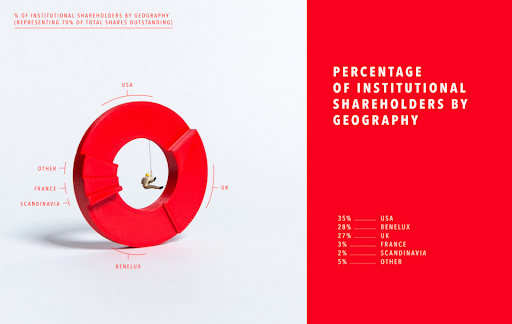
Duni specializes in table-setting and takeaway packaging for restaurants and global businesses. Its annual report is straightforward, clearly organized, and minimalist but still uses color, images, and various design elements to strengthen its words’ impact.
The image below displays their YoY financial target growth that draws in audience attention with large fonts, colors, and line graph visualizations.
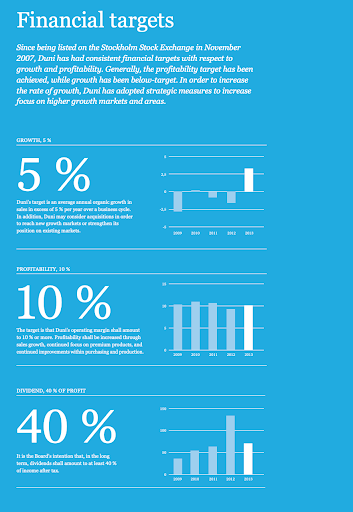
Annual Reports Paint a Picture of Success
It’s essential to understand how to create an annual report that displays your business’s successes and incorporates design elements that emphasize your words’ significance and allow your audience to understand, visualize, and absorb your accomplishments.

Don't forget to share this post!
Related articles.

8 Graphic Design Resume Examples to Land Your Next Job
![how to write a great annual report How to Create an Ebook From Start to Finish [Free Ebook Templates]](https://blog.hubspot.com/hubfs/ebook-template_0.webp)
How to Create an Ebook From Start to Finish [Free Ebook Templates]
24 Best Free Marketing & Sales Icons for Your Website or App

The Ultimate Collection of 200+ Best Free Content Marketing Templates

7 Visual Hierarchy Principles for Every Marketer
![how to write a great annual report 36 Beautiful New Ebook Templates [Free Download]](https://blog.hubspot.com/hubfs/free-ebook-template_7.webp)
36 Beautiful New Ebook Templates [Free Download]

What is Information Design + How It Can Help You as a Marketer
![how to write a great annual report Ultimate Guide to Hero Images [Best Practices + Examples]](https://blog.hubspot.com/hubfs/hero-image_5-1.webp)
Ultimate Guide to Hero Images [Best Practices + Examples]
![how to write a great annual report How to Use the Rule of Thirds in Web Design [Quick Tip]](https://blog.hubspot.com/hubfs/bull%20in%20meadow%20rule%20of%20thirds%20example.jpg)
How to Use the Rule of Thirds in Web Design [Quick Tip]

Outsourcing a Design Project? Here's How to Write a Design Brief
Outline your company's marketing strategy in one simple, coherent plan.
Marketing software that helps you drive revenue, save time and resources, and measure and optimize your investments — all on one easy-to-use platform
How to write an annual report

In this guide, we'll show how the world’s leading non-profits are building immersive annual reports — turning an obligation into an opportunity.
We'll cover:
- What is an annual report?
Why you need to write an annual report
- Why annual reports are a massive opportunity for non-profits
- The rise of immersive annual reports built as visual stories
- What to include in your annual report
- Ten tips for creating an annual report that has real impact for all stakeholders
Before we get started, if you're looking for annual report examples, check out our list of ten stunning annual reports.
What is an annual report?
An annual report is a comprehensive overview of the performance of a non-profit organisation. Annual reports typically include financial statements, statements from the CEO and Board Chair, and key activities and accomplishments.
Generally, annual reports are intended to offer a transparent view of an organisation's activities over the course of a financial year.
As we'll cover in this guide, annual reports are also a major opportunity to promote, market, and advance an non-profit's mission.
Non-profit organisations and public companies produce annual reports for three main reasons.
Meet your legal obligations In many jurisdictions, nonprofits are required to produce annual reports in order to maintain their tax-exempt status. Even where financial disclosure is enough, annual reports are still recommended. The same is true for public companies, who in the US need to file with the Securities and Exchange Commission.
Showcase your impact It's one thing to show your stakeholders what you did; it's another thing to prove your impact. Annual reports are a perfect opportunity to show off your concrete successes, either with qualitative stories — such as case studies and profiles — or with quantitative data.
Celebrate your community Successful non-profits take a village, with donors, leadership, staff, volunteers, and community stakeholders all playing their part. There are many valid reasons why people work with non-profits, and not everyone wants or needs public recognition. But let's face it: plenty of your community will want recognition, and an annual report is a great place to celebrate their contribution.
What do annual reports look like?
This is going to sound like a contradiction in terms, but six months ago I read a beautiful annual report .
The report was published by South African charity mothers2mothers, an Africa-based NGO working to deliver health, hope, and an HIV-free future.

This annual report is unusual for three reasons. First, I actually wanted to read it. Who — apart from employees, board members, and big donors (maybe) — actually reads the annual report of a non-profit?
Second, it was beautiful to look at. It was a delightful and immersive reading experience.
Third, it was published as a responsive webpage — not a PDF. I could read it on my phone. Not once did I pinch and zoom. It didn’t feel like it was made primarily for print.
Looking for more digital storytelling inspiration? Sign up for our newsletter and get the best digital stories in your inbox.
The underwhelming impact of (some) annual reports

Why does this matter?
Annual reports are a statutory requirement. That means that nonprofits have to publish them — otherwise, they risk losing their tax-exempt status.
But they’re not just an obligation — they’re an expensive obligation. Annual reports aren’t easy to produce. They require input from the CEO, the board, finance, comms, design, and staff across the organisation.
To rub salt into the wound, most annual reports barely get opened, let alone read. Mostly published as PDFs (with poor cousin versions occasionally published on a legacy CMS), they’re artefacts of a previous era — an era of desktop printers and email attachments.
Given the underwhelming impact these reports tend to have, most of them are a legally obligated waste of time.
This is a missed opportunity — because, as we saw with mothers2mothers, they could be so much more.
Immersive annual reports

So, what’s the solution?
How do non-profits create an opportunity from an obligation?
Over the last decade, technology has moved on from the PDF. Most people read on multiple devices, including tablets and phones. Nobody wants the irritation of pinching and zooming a PDF on a smartphone.
Web technologies — including more powerful browsers and digital storytelling platforms — are allowing for immersive, interactive, and fully responsive reading experiences that far outstrip what can be achieved with a PDF.
This has led to the rise of immersive annual reports. These reports are building on techniques used by media brands like Sky, BBC, and NBC News to keep the readers' attention.

In stories such as the BBC's report on clean energy, shown above, rich media are integrated with scroll-based animation techniques to capture and keep the attention of the reader.
Leading NGOs are doing the same.
Take, for example, Habitat for Humanity, who have been publishing their annual reports as immersive digital stories for several years. Their annual report design is impressive — and accessible to all.

What to include in your annual report
While annual reports are a hugely flexible format, most reports include many of the following elements.
A letter from the CEO or Board Chair The letter from leadership is a chance to celebrate the year's accomplishments, and chart a course for the year ahead. It should be inspiring, evocative, and written in plain English. It can be difficult to give feedback to leadership, but as this letter often opens the annual report, it's worth spending time crafting a letter that people will actually excite and capture the attention of the reader.
Navigation help, such as a menu or table of contents An annual report is a large piece of content and it's rare that anyone will read the entire report from beginning to end. To help people find what they're interested in, add a menu to the top of your report. For your print copy, add a table of contents. Note: we recommend against distributing a PDF-only annual report.
Your mission statement An annual report is, among with things, an exercise in branding for your non-profit. Make sure you include your mission statement and key messages early in your annual report.
Data showcasing your impact If you have data, use it. There's nothing more powerful than well-executed data visualisations — including charts, graphs, and maps — in an annual report. If you want to get inspired with great examples of data visualisations, check out our guide here .
Testimonials Try to includes stories, case studies, and other testimonials from your stakeholders from the last year. This will humanise your report and make it much more compelling to read.
Profiles Some annual reports go a step further and include profiles of team and community members. This is another great way to showcase the people behind your non-profit.
Donor list Some non-profits like to celebrate their donors with a list in their annual report. This is perfectly acceptable, though make sure the list doesn't take up too much of the report, as it will likely be skimmed by most readers.
Fundraising highlights Your stakeholders want to know that your organisation is resilient and stable. The best way to do this is to present highlights from your fundraising efforts from the past year. This should include infographics and data visualisations — including easily-understood graphs and pie charts — showing your progress.
Multimedia Effective annual reports include a range of media, including photos, videos, illustrations, infographics, animations, and more. While this is impossible to include in a typical PDF, new digital storytelling platforms make it possible to create immersive multimedia reports that can be read on any device. You can read some inspiring examples of annual reports in our guide here .
A call-to-action Annual reports are a great marketing opportunity — but only if you include a call-to-action or CTA. To be clear, your contact details at the end of a PDF does not qualify as a CTA. For your CTA to work, it needs to be immediately actionable, such as a button or a form on your digital annual report.
Financial statements Our final item is not negotiable. In most countries, your nonprofit annual report will need to include your full financial statements from the last financial year. You'll want to work with your accountant to produce this financial information.
Now that we've covered the basics, let's take a look at the actual process of writing an annual report.
If your organisation is ready to build your own immersive annual reports without writing a line of code, get started with Shorthand and publish your first story free.
Start early
An immersive annual report is an opportunity to produce that rare beast: the annual report that actually gets read. But to execute this opportunity, you’re going to need to start early.
This is because immersive digital stories are hungry for high quality media assets. The more assets you have, the more options you’ll have to use immersive visual storytelling techniques. Make a point of producing media assets at events and projects throughout the year, so that you have plenty of options when it comes time to produce.
2 Know your audience
A few years ago, the popular web comic XKCD published a famous Venn diagram on the nature of university websites.

'University Website' by XKCD.
On the right side of the Venn diagram, we see all the information people want to find on the university website, including application forms and an academic calendar. On the other side, we have all the information the university wants people to see, including the letter from the president and a ‘virtual tour.’
Unfortunately, the same diagram could be produced for some nonprofit annual reports — and for similar reasons. Like university websites, annual reports have multiple, somewhat contradictory audiences.
These audiences might include:
- Internal stakeholders, including your Board, senior leadership, and staff.
- Funders — current and future.
- Volunteers and members.
- Your target audience for future volunteers, donors, and members.
- The broader public.
It won’t be easy to target all of these audiences in the same piece of content — but you won’t have a chance unless you’re crystal clear on who they actually are.
Collaborate
To get your annual report published in time, you will need to collaborate with two groups of people.
The first group is colleagues and contractors who are actively contributing to the production of content. It’s obviously a good idea to collaborate with these folks throughout the process.
The second group is a little different, and is made up of people who won’t contribute directly — but who nevertheless have strong opinions about what the report should look like. These opinions can block progress at key steps in the development of your report.
This second group is the trickiest to deal with. The best way to deal with them is to actively solicit their advice and feedback throughout the process. Don’t worry: you don’t have to act on everything they say. But this will ensure that no one feels ambushed or surprised by the final result. It will also reduce the risk of any nasty surprises in the days and weeks leading up to publication.
Build it natively for the web
Many annual reports are produced as PDFs using design software like Indesign.
There are good reasons for this. A PDF ensures that every reader sees the same thing. PDFs are portable – that's the ‘P’ in the acronym – which makes the information easily accessible by people using different operating systems. PDFs can also be read offline and printed, which can be handy at stakeholder events.
But there are many reasons why PDFs are not a great way to publish your annual report.
First, they aren’t responsive. People reading PDFs on mobile devices and small screens often struggle to read the text.
Second, they're difficult for non-designers to edit. This makes the proofing process much more painful and contentious. Multi-stakeholder publications — like annual reports — notoriously require many rounds of editing. Trust me: after round 15, your designer is going to wish you could just do it yourself.
Third, PDFs aren't native to the web. This means they can't take advantage of many of the visual techniques increasingly common in digital stories.
Fourth, you can’t properly SEO a PDF. While Google can index PDF content, it simply won’t perform nearly as well as a structured web page.
Fifth, they’re just no fun to read online. PDFs are great for print — but they are terrible for production, distribution, and consumption on the web.
Read more in our guide on the limits of PDFs .
Earn the attention of the reader
Nonprofits produce annual reports because they have to. As we mentioned above, in most countries annual reports are a statutory obligation.
But no one wants to read a statutory obligation. And annual reports are — once the legal i’s and t’s have been dotted and crossed – a prime opportunity to connect with a much larger audience.
But how to produce an annual report that people actually want to read? The best way is to employ the techniques used by the world’s leading digital storytellers, such as the BBC and NBC News.
These teams employ a range of techniques — including scroll-based animation, rich media, and attention-grabbing transitions — that produce some of the highest engagement rates of any content on the web. An example of this comes from NBC News .

With impressive maps and video, the team at NBC have struck a careful balance between interactive media and immersive text. It’s a piece of content that respects the attention of the reader.
Data visualisation is the secret sauce of every compelling annual report. Most nonprofits collect data on the impact of their activities. Make the most of this data, as it can anchor the broader story you are trying to tell, and make it more likely that your readers stay with you through the less compelling sections.
Using a digital storytelling platform, you can also animate your data natively in the browser, without writing a line of code.
One example of this is from New Zealand media company Stuff, who animated government data on the stark social and economic impact of COVID-19 .
If you're looking for more examples and inspiration of great data visualisation, check out our guide, 8 examples of powerful data stories . We've also published a large collection of data stories .

If your nonprofit works regionally, then consider including a map — or maps, plural — showcasing your work. You might choose to highlight different projects your team has completed over the year, or emphasise problems or crises that your organisation is trying to address.
Embedding a custom webmap — one that readers can pan and zoom — is a compelling option, but usually requires custom development, which can get expensive.
Instead of a webmap, consider using static illustrations to create an interactive map, triggered by the scroll of the reader. This is how The Yemen Peace Project created their map of Yemen’s invisible war , built with digital storytelling platform Shorthand.

Showcase your community
Nonprofits are fundamentally about people, including your staff and supporters.
Too often, annual reports focus on the top of the organisation, without paying enough attention to the people on the ground. But the stories of these people — and the work they do — are typically much more compelling to readers, including funders.
One way to showcase your community is to include a rich gallery of images and video.
Keep it snappy
As we’ve already argued, annual reports take a village. They have many audiences and many creators. The net effect of this ‘village’, though, is that most annual reports are extraordinarily long — far too long for most people to read.
Some of this is necessary. You need a human-readable update from the leadership on the strategic direction of the company. You need to include your financials. You need some data on the work you’ve been doing. And you need human stories.
So, what to do? Rather than exclude any of these sections, we recommend keeping them as concise as possible. If your Executive Director is used to writing 800 words, see if she can get it done in 500. If the essay on that critical project is stretching into multiple pages, try and cut it in half.
Ultimately, if you keep each section slim, readers are much more likely to continue reading.
PDFs are great — for some purposes. But with the rise of digital storytelling platforms, there are simply much stronger, web-native alternatives for producing content that's as critical as your annual report.
Want to try it for yourself? Check out Shorthand's options — and if you decide to subscribe, enjoy a 20% discount for nonprofits and charities.

Publish your first story free with Shorthand
Craft sumptuous content at speed. No code required.
- Search Search Please fill out this field.
What Is an Annual Report?
Understanding annual reports, special considerations, mutual fund annual reports, the bottom line.
- Corporate Finance
- Financial statements: Balance, income, cash flow, and equity
Annual Report Explained: How to Read and Write Them
Adam Hayes, Ph.D., CFA, is a financial writer with 15+ years Wall Street experience as a derivatives trader. Besides his extensive derivative trading expertise, Adam is an expert in economics and behavioral finance. Adam received his master's in economics from The New School for Social Research and his Ph.D. from the University of Wisconsin-Madison in sociology. He is a CFA charterholder as well as holding FINRA Series 7, 55 & 63 licenses. He currently researches and teaches economic sociology and the social studies of finance at the Hebrew University in Jerusalem.
:max_bytes(150000):strip_icc():format(webp)/adam_hayes-5bfc262a46e0fb005118b414.jpg)
An annual report is a document that public corporations must provide annually to shareholders that describes their operations and financial conditions. The front part of the report often contains an impressive combination of graphics, photos, and an accompanying narrative, all of which chronicle the company's activities over the past year and may also make forecasts about the future of the company. The back part of the report contains detailed financial and operational information.
Key Takeaways
- An annual report is a corporate document disseminated to shareholders that spells out the company's financial condition and operations over the previous year.
- It was not until legislation was enacted after the stock market crash of 1929 that the annual report became a regular component of corporate financial reporting.
- Registered mutual funds must also distribute a full annual report to their shareholders each year.
Investopedia / Jake Shi
Annual reports became a regulatory requirement for public companies following the stock market crash of 1929 when lawmakers mandated standardized corporate financial reporting. The intent of the required annual report is to provide public disclosure of a company's operating and financial activities over the past year. The report is typically issued to shareholders and other stakeholders who use it to evaluate the firm's financial performance and to make investment decisions.
Typically, an annual report will contain the following sections:
- General corporate information
- Operating and financial highlights
- Letter to the shareholders from the CEO
- Narrative text, graphics, and photos
- Management's discussion and analysis (MD&A)
- Financial statements, including the balance sheet, income statement, and cash flow statement
- Notes to the financial statements
- Auditor's report
- Summary of financial data
- Accounting policies
Current and prospective investors, employees, creditors, analysts, and any other interested party will analyze a company using its annual report.
In the U.S., a more detailed version of the annual report is referred to as Form 10-K and is submitted to the U.S. Securities and Exchange Commission (SEC). Companies may submit their annual reports electronically through the SEC's EDGAR database . Reporting companies must send annual reports to their shareholders when they hold annual meetings to elect directors. Under the proxy rules, reporting companies are required to post their proxy materials, including their annual reports, on their company websites.
The annual report contains key information on a company's financial position that can be used to measure:
- A company's ability to pay its debts as they come due
- Whether a company made a profit or loss in its previous fiscal year
- A company's growth over a number of years
- How much of earnings are retained by a company to grow its operations
- The proportion of operational expenses to revenue generated
The annual report also determines whether the information conforms to the generally accepted accounting principles (GAAP). This confirmation will be highlighted as an " unqualified opinion " in the auditor's report section.
Fundamental analysts also attempt to understand a company's future direction by analyzing the details provided in its annual report.
In the case of mutual funds, the annual report is a required document that is made available to a fund's shareholders on a fiscal-year basis. It discloses certain aspects of a mutual fund's operations and financial condition. In contrast to corporate annual reports, mutual fund annual reports are best described as "plain vanilla" in terms of their presentation.
A mutual fund annual report, along with a fund's prospectus and statement of additional information, is a source of multi-year fund data and performance, which is made available to fund shareholders as well as to prospective fund investors. Unfortunately, most of the information is quantitative rather than qualitative, which addresses the mandatory accounting disclosures required of mutual funds.
All mutual funds that are registered with the SEC are required to send a full report to all shareholders every year. The report shows how well the fund fared over the fiscal year. Information that can be found in the annual report includes:
- Table, chart, or graph of holdings by category (e.g., type of security, industry sector, geographic region, credit quality, or maturity)
- Audited financial statements, including a complete or summary (top 50) list of holdings
- Condensed financial statements
- Table showing the fund’s returns for one-, five- and 10-year periods
- Management’s discussion of fund performance
- Management information about directors and officers, such as name, age, and tenure
- Remuneration or compensation paid to directors, officers, and others
How Do You Write an Annual Report?
An annual report has a few sections and steps that must convey a certain amount of information, much of which is legally required for public companies. Most public companies hire auditing companies to write their annual reports. An annual report begins with a letter to the shareholders, then a brief description of the business and industry. Following that, the report should include the audited financial statements: balance sheet, income statement, and statement of cash flows. The last part will typically be notes to the financial statements, explaining certain facts and figures.
Is an Annual Report the Same As a 10-K Filing?
In general, an annual report is similar to the 10-K filing in that both report on the company's performance for the year. Both are considered to be the last financial filing of the year and summarize how the company did for that period. Annual reports are much more visually friendly. They are designed well and contain images and graphics. The 10-K filing only reports numbers and other qualitative information without any design elements or additional flair.
What Is a 10-Q Filing?
A 10-Q filing is a form that is filed with the Securities and Exchange Commission (SEC) that reports the quarterly earnings of a company. Most public companies have to file a 10-Q with the SEC to report their financial position for the quarter.
Public companies must produce annual reports to show their current financial conditions and operations. Annual reports can be used to examine a company's financial position and, possibly, understand what direction it will move in the future. These reports function differently for mutual funds; in this case, they are made available each fiscal year and are typically simpler.
U.S. Securities and Exchange Commission. " Speech By SEC Commissioner: Remarks Before the Securities Traders Association ."
U.S. Securities and Exchange Commission. " Annual Report ."
U.S. Securities and Exchange Commission. " How to Read a 10-K/10-Q ."
U.S. Securities and Exchange Commission. " Final Rule: Shareholder Reports and Quarterly Portfolio Disclosure of Registered Management Investment Companies ."
U.S. Securities and Exchange Commission. " Mutual Funds - The Next 75 Years ."
:max_bytes(150000):strip_icc():format(webp)/10-K--f7185a10d5d342c68235646bd3ceefcd.jpg)
- Terms of Service
- Editorial Policy
- Privacy Policy
- Your Privacy Choices
- Google Slides Presentation Design
- Pitch Deck Design
- Powerpoint Redesign
- Other Design Services

- Business Slides
- Design Tips
- Guide & How to's
Annual report design templates and tips: how to tell a great story with financial data in 2023
A memorable annual report needs a lot of time and effort. Do you recall the school report card and its purpose? It served as a reflection. It showed our academic performance during the year. Similarly, a company’s or organization’s performance report has to communicate this. It has to stand out in a clear, easy-to-understand annual report presentation of the company’s values, key business highlights, financial performance, revenue growth goals, and future developments.
Of course, we know how difficult and daunting listing, summarizing, and recording business operations and financial positions can be. That’s why we’ve created an ultimate guide with tips for writing an annual report. So, let’s dive in…
How to write an annual report
The secret to an excellent annual report is simple: just turn the information you include in the presentation into an engaging story utilizing all the available storytelling techniques. From writing content to designing, the tips on how to create an annual report you’ll find in this article will help you increase visibility and bring your annual report game to the next level.
Important steps to take:
Step 1: Decide on the key message
Highlighting your achievements and their impact in an annual report is a great idea. The target audience is interested in learning what you have accomplished so far and why you did it.
In fact, businesses can build credibility and establish lasting relationships with shareholders, investors, and customers by tying their activities and achievements to their mission statements.
Step 2: Structure the report
Choosing what to include and what to omit while creating a yearly report is one of the most challenging aspects of the process. It’s critical to plan the annual report structure and content.
The annual report should include a storyline that establishes the overall framework of the document and organizes the content around a narrative thread, in addition to the fundamental components like the introduction, chairperson’s letter, business profile, and financial statement. This makes it simpler to spot and remove content that does not advance the plot.
Write with clarity, precision, and unambiguity. Keep your tone impartial and professional throughout the entire document.
The annual report’s content must be transparent and truthful, so don’t exaggerate achievements or hide your losses.
Once the writing is done, proofread it for grammar, tone, and spelling.
Step 3: Use a captivating design
A business can utilize a well-designed report as a marketing tool if it is exciting and professional. That’s why readers should be able to scan the document to find the information they require quickly.
Here are some guidelines for an effective annual report design:
- Utilize headers and subheadings.
- Allow room for images, infographics, and other visuals.
- Keep the text brief and simple.
- Use a color palette and fonts that are consistent with your brand.
- Emphasize important areas using colored text bubbles, quotations, and captions.
Pro tip: Prepare in advance
Creating an annual report is a lengthy process requiring an orderly system for logging and tracking information, media clippings, images, and corporate accomplishments. Many businesses craft their annual reports in-house, while others prefer to employ a design agency to ensure their report is structured and designed in a professional way.
What’s included in an annual report?
An annual report is a financial document comprised of four sections covering the critical company’s aspects and appendages. The sections are as follows:
1. Management’s message
Management has a fantastic opportunity to interact with the company’s stakeholders through an annual report. Almost all yearly reports begin with a message from the company’s chairman, primary owner, or CEO, which provides an overview of the company’s challenges, successes, and insights into the growth during the previous year.
Next comes the table of contents.
2. Company profile
The company’s vision and mission statement, information on the directors, officers, registered and corporate offices, investor profiles, the products or services that the company offers, competitor profiles, and risk factors for the company are all included here.
This section can be decorated with team photos and staff testimonials.
3. Management discussion and analysis
The section gives a detailed summary of the company’s three-year performance and includes information about the following:
- Revenue growth
- Changes from past reports
- Profit margins
- Cash flow statement
New product launches, shifts in sales, and marketing can also be covered in this section. The other topics to include are new hires, company acquisitions, and other beneficial information.
4. Financial statements
The financial statements are the most crucial section of the annual report because they show how well the business has performed in the past, its capability to pay off debts, and its future growth plans. The following statements are included:
- Balance sheet
- Current stock prices
- Income statement
- Statement to shareholders
- Comparison as per financial trends (current vs. previous years)
- Grants distributed
The income statement lists the company’s earnings, expenses, and total sales. The balance sheet provides a quick overview of the company’s assets and liabilities. The cash flow statement contains data on cash inflows and outflows.
Additional notes are given regarding each financial component after the financial data. The balance sheet notes include information on capitalized leases and debt insurance. Notes to the cash flow statement usually cover tax payments.
In addition to the financial statements, data about the dividends paid can also be covered in this section.
Other elements to include are as follows:
- Account notes with accounting policy details
- Auditor’s comments on the company’s financials
- Forecasted income and expense disclaimers
- Infographics, photos, and success stories
Now that you know how to write an annual report and its main components, let’s move on to tips on designing an annual report.
Corporate annual report design best practices
1. create a visual hierarchy.
As soon as you get through the content writing phase, you need to consider how you will present the content. Even though chunks of text are unavoidable, given the nature of an annual report, you can separate them with the layout to improve comprehension.
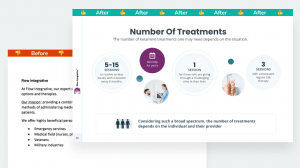
Pro tip: Break up content with white spaces
While the annual report’s design direction prioritizes a minimalist approach, you can employ the same style on specific pages where written content can be condensed and fit inside your visual hierarchy.
2. Choose the right typography
Next, you need to select the appropriate typography based on the report’s context. Despite how insignificant it may seem, the font can have an impact on the readability, design, and even the readers’ mood.
Here’s an example:
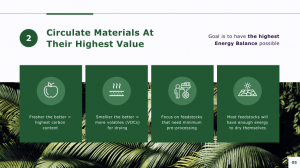
Pro tip: Look at the design of your company annual report PowerPoint presentation. Does it evoke positive emotions? If not, it’s time to change the font.
3. Give section breaks
Before each part, give an overview with critical points and stats (using visuals, of course). Not everyone has the time to go through a lengthy report, and most people only skim through them.
By providing a summary, you make sure that people remember your message.
Pro tip: Remember, less is more. Try to condense data to the essentials, not overcrowd slides, as they will look busy and be difficult to read.
4. Add status marks to lists
The use of a consistent icon set can help express the achievement of goals in the most appealing way.
5. Pay special attention to visuals
The visuals you use to communicate your story and present your financial data are just as important as the written words. Similarly to fonts, your choice of infographics, images, and colors will impact how the reader interprets the content.
Some good examples to follow:
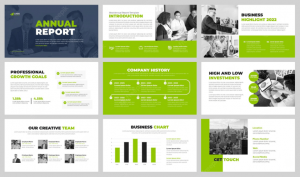
Pro tip: Make sure the design of your annual report ppt is in line with your brand and reflects your visual identity.
6. Replace table content with text in shapes
A PowerPoint shape can help make tables look better and easier to edit as you create annual report.
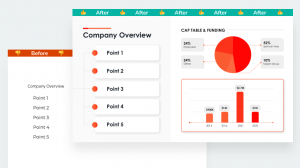
7. Be creative
Experiment with layout, include delightful photos or tidbits, and don’t be shy to move past traditional design boundaries to make your annual report truly memorable.
Some awesome examples to follow:
- Warby Parker’s 2013 annual report
- Flywheel’s 2015 Year in Review
Wrapping up
While that’s quite a lot of information to keep in mind, these content writing and annual report design tips can serve as a reference for you anytime you run into problems with your report’s creation, so don’t hesitate to bookmark this page.
And if you need help bringing your story to life, our creative team will gladly handle it for you. Simply drop us a message or call +1 (347) 464 59 57.
#ezw_tco-2 .ez-toc-widget-container ul.ez-toc-list li.active::before { background-color: #ededed; } Table of contents
Presenting techniques.
- 50 tips on how to improve PowerPoint presentations in 2022-2023 [Updated]
- Keynote VS PowerPoint
- Types of presentations
- Present financial information visually in PowerPoint to drive results

How to start and end a presentation: top tips and tricks from professionals (+ special focus)

How to create weekly status report template
- Why Kindful? Mission Testimonials Comparisons
- Features Fundraising Tools Donor Communications Donor Management Tracking & Reporting View All Features
- Apps & Integrations
- Resources Blog Webinars Kindful Academy eBooks Templates Year-End Giving Nonprofit Glossary Consultant Directory
- Year-End Giving
- Other Resources Academy eBooks Templates Webinars
- Nonprofit Glossary
- Join the Newsletter
Communication
Step-by-Step Guide To Writing An Annual Report For Small & Growing Nonprofits
Kindful • April 19, 2021

Writing an annual report is an important component of doing business as a nonprofit organization. When it is well written and visually pleasing, it can inspire potential donors to jump on board and donate money, initiate major gifts from corporations and foundations, and ensure that those who already donate to your organization keep on giving.
Whether you are new to writing annual reports or would like to improve the reports you already send out each year, we have created a step-by-step guide to help you write an annual report that is full of inspiration and a vision for the future.
- Brainstorm and create an outline
- Compile all of the information for your annual report
- Lay out your annual report so that it’s visually appealing
- Review and edit your annual report
- Distribute your annual report
1. Brainstorm and create an outline.
Before diving in and actually getting to work on writing your organization’s annual report, brainstorm and create an outline so that you and your team can organize all of your thoughts and ideas. Annual reports are packed full of information, and you want to ensure that all of the information flows in a pleasing and logical manner for the reader.
Your annual report should educate potential new donors to give money to your organization for the first time as well as inspire established donors to give more. When creating your outline, be sure to include plenty of feel-good success stories as well as a detailed explanation on how donations benefit the community you’re serving. Your annual report should be full of colorful pictures and pleasing graphics to hold the attention of the reader.
2. Compile all of the information for your annual report.
Now that you have brainstormed and created a basic outline of what to include on your annual report, it’s time to compile all of the data and graphics to include in the document. Gather information about your financials, what projects and initiatives their donations funded, how many people in the community were served, and what the goals and objectives are for the future.
Within your annual report, you should also include data and statistics about specific fundraising events and campaigns, highlighting how successful they were. Also, be sure to include personal stories from community members your nonprofit served.
3. Lay out your annual report so that it is visually appealing.
If your nonprofit doesn’t have a well-established public relations and marketing department with designers who can create a template for you, there are many templates you can download online for free or for a nominal fee. An annual report does not need to be book-length, but should at least contain a few pages, so you have enough space to include all of the pertinent information. Brochures and booklet size publications are ideal for annual reports.
Create a captivating cover page for your annual report so that everyone on your report’s distribution list has a clear understanding of what you are sending them. The first page of the report should be reserved for a letter by the CEO of your organization to donors and community members discussing the achievements, challenges, and visions for the future. The following pages should contain the “meat” of your annual report, which includes photos, stories, statistics, and graphs.
4. Review and edit your annual report.
After drafting your annual report, be sure to look it over with a fine-tooth-comb to ensure all of the data, information, and statistics are accurate. Consider assigning the editing task to someone on your team who did not help write the report for a fresh perspective. The drafted report should also be reviewed by the leadership executives of your nonprofit for approval before the report is distributed to stakeholders and the community. Once the editing process is complete, you can fine-tune the layout and get the report ready for final copy.
5. Distribute your annual report.
The final step of creating your organization’s annual report is to distribute it to your community. You can use your nonprofit’s CRM database to make this an easy and efficient task. First, determine who you are going to directly send the report to, whether it be corporate and major gift donors, donors who contribute “X” amount or more to your organization each year, or if you are going to send it to the entire community.
Distribute your annual report in a multitude of different ways, including by way of email, posting it to your organization’s website, and sending copies via direct mail. Use the bulk email function within your CRM software to send out electronic copies of the report.
Where can I find annual report templates and examples?
You can find plenty of templates and examples online that will help guide you through the process of writing an engaging annual report. For example, the Council of Nonprofits has an entire library of resources and templates to assist you with many topics regarding nonprofit business management.
An annual report is an essential business tool of any nonprofit, and it helps paint a picture of the mission of your organization. Not only does the annual report highlight how donor dollars were utilized throughout the year, but it also showcases your organization’s vision for the future. When done well, it can inspire community members to donate more and help you grow and create more of an impact well into the future.
Schedule a live demo with our partner Bloomerang, and we’ll show you how easy it is to create and automate reports, utilize online and offline fundraising tools, quickly integrate and access all your data, and ultimately create more time to engage your donors.
Filed Under: Communication
Follow us on social
How to Tell a Great Story in Your Annual Report (Plus Examples)
by Katy French

We’ve talked at length about why your annual report is such an important piece of content for your brand. It doesn’t just satisfy a legal requirement; it’s a bold statement about who you are, what you do, and how you are succeeding. The stronger your annual report, the more you can increase your visibility and connect with the community who supports you.
Of course, we know crafting an annual report can feel intimidating or taxing. That’s why we’re giving you a step-by-step guide to help you create an engaging report.


How to Create a Great Annual Report
The key to a great annual report is to turn the information you’re including into an interesting story, using every storytelling tool at your disposal. From copywriting to design, the tips you’ll find here will help you bring your annual report to life on every page.
1) Choose the right format.
Annual reports have evolved over the years (and in the best ways). Whereas they used to be dry, dull print reports, there are all sorts of exciting and engaging ways to tell your brand story, whether it’s on paper or on a screen. How do you know what format is right for you? The whole point of an annual report is to showcase your brand’s achievements in a meaningful way, so the format you choose will probably be influenced by your audience and your brand’s product, service, or mission. If you’re not sure how to decide, here’s a simple rundown of your options.
Print The good old standby, print annual reports are the most user-friendly format. They are usually simple and straight forward, but they can be just as exciting as other formats, depending on your presentation. Example: The Sonae 2012 Annual Report by Ivity Brand Corp. featured colorful gears that readers could manually turn.

Digital If you’re not limited by page count or printing costs, digital can give you more opportunities to be creative. Also, because digital content is so easy to share, it is the easiest way to get more people to engage with your content.
Even if you’re just posting a PDF slideshow to your website, think of ways to promote your report online. An interesting data visualization, pull quote, or statistic can be great visual content for social platforms.
Example: Canadian Hearing Services includes a click-through slideshow of their print report on their site, making the content easy to consume.
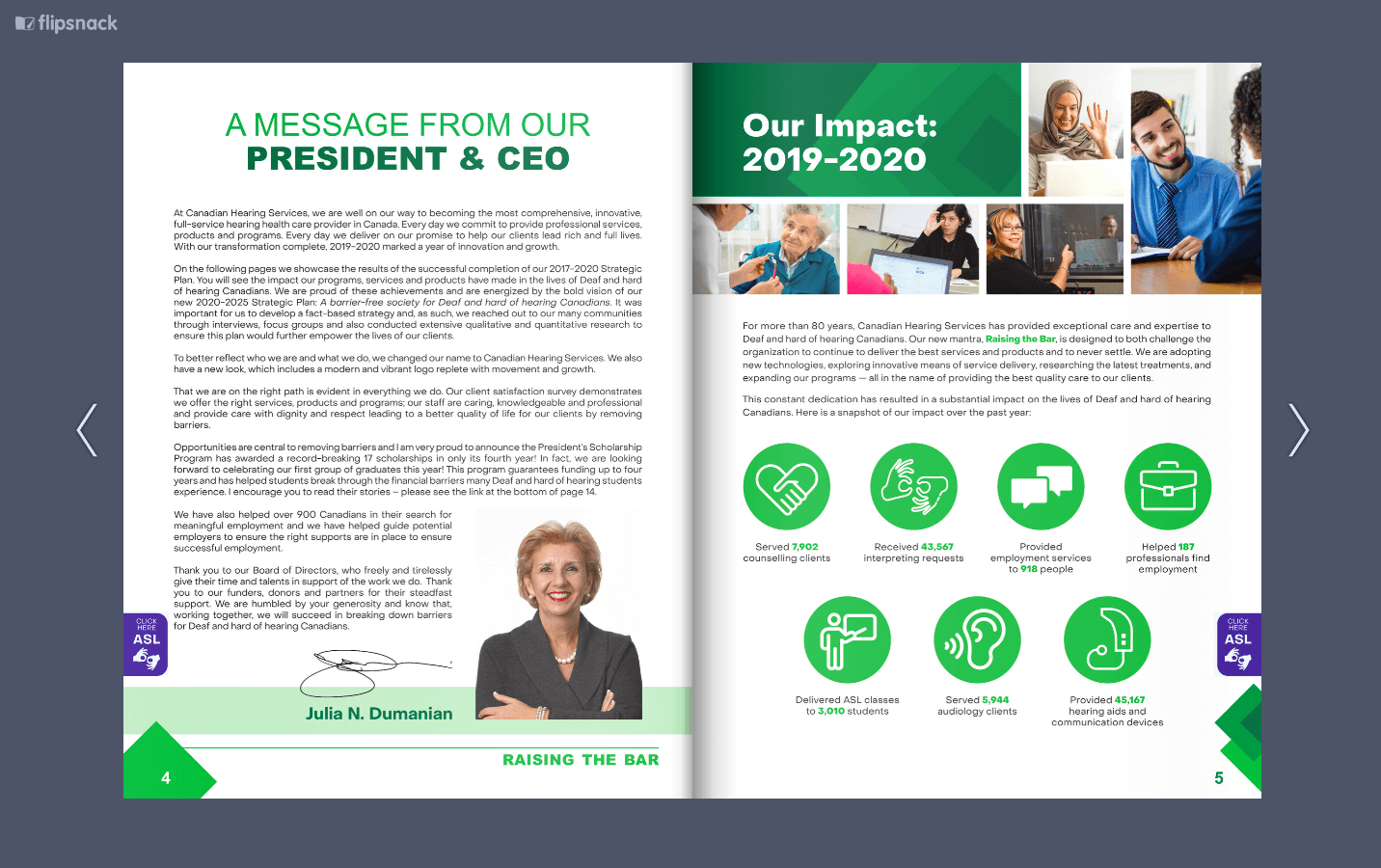
Example: Goodwill of Southern California shares a simple stat about their achievements—a great way to promote their mission on social media.
View this post on Instagram A post shared by Goodwill Southern California (@goodwillsocal)
Interactive Interactive content is a great way to encourage people to engage with your content. Whether you create a structured interactive that guides them through the story, or an exploratory experience that they can poke around on their own, the more time they spend in your content, the more invested they’ll become. Interactive annual reports are especially effective if you have large data sets to explore.
Example: Girls Who Code is a nonprofit that teaches teens girls to code. Since their work is all about professional computer programming, a slick interactive annual report was the perfect way to showcase the value of what they do.
Video People are busy, so offering them quick and succinct information is much appreciated. Video is a great way to deliver your annual report highlights in a short amount of time. It’s also a great way to humanize your brand and let people tell your story.
Example: Juvenile Welfare Board’s video annual report lets families strengthened by JWB’s services share their stories.
Tip: If you really want to make an impression, brainstorm alternate presentations. When it comes to format, you can be as creative as you want to be.
Example: Try something novel like the Banques Alimentaires Québec 2012-2013 Annual Report by LG2 Boutique, which came wrapped around a paint can.

Example: The Well Done 2006 Annual Report by Bruketa & Žinić required readers to bake—yes, bake—a booklet to see images appear inside.

No matter what story you’re telling, make sure that you have the resources and knowledge to produce whatever content format you choose—before you dive into the writing process.
2) Craft a narrative.
It’s a shame when brands just compile their numbers, add a letter from the president, and call it a day. There is a lot of valuable content to be shared in an annual report, but if it isn’t presented appropriately, much of it goes to waste. As a cornerstone piece of content, your annual report should effectively communicate your brand story.
Anchor your annual report around a core narrative. Is there a theme that influenced your work throughout the year? Was there a successful initiative that encapsulates your message? Did your work affect change in a significant way?
Crafting your report with a meaningful through line makes it easier to digest what’s in the report and lets you showcase your brand in its best light. (This core story should also influence your design.)
Tip: Sometimes your strongest story will come from the numbers in your spreadsheets. Follow these 5 steps to find compelling stories in your data .
Example: The National Association of Realtors 2014 Annual Report was crafted around the t heme “You are NAR” to reenforce how important each member is.
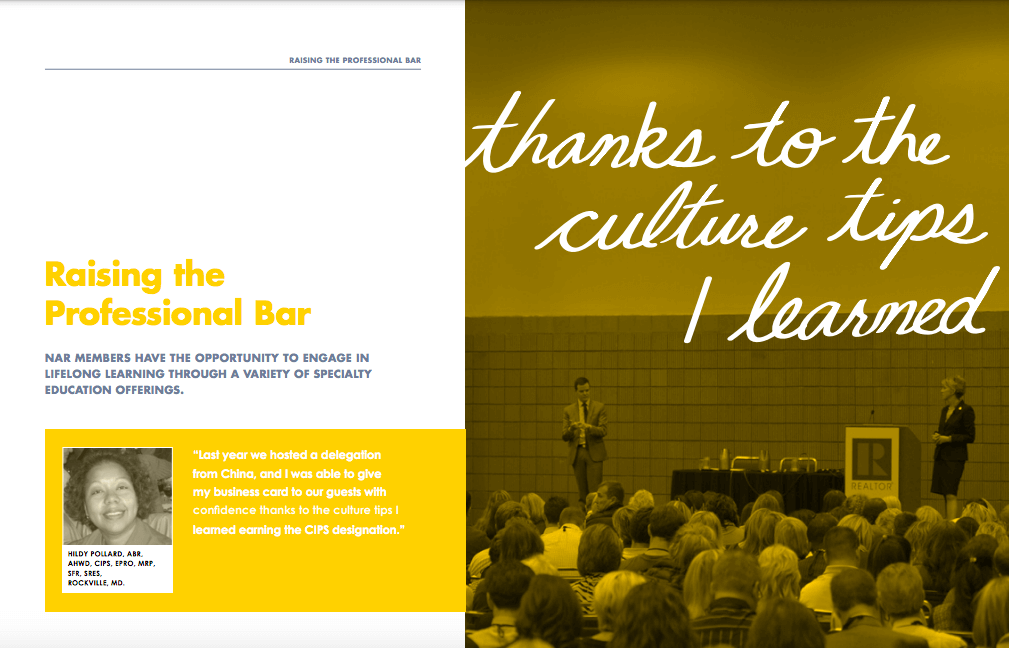
3) Demonstrate your impact.
An annual report is an opportunity to highlight your accomplishments, build trust in your organization, and show your stakeholders your success.
But to really make an impression and help your viewer emotionally invest in your brand, you need to highlight the impact of these accomplishments. How does your work affect individuals, businesses, communities, or even the world?
Tip: Instead of just listing a timeline of highlights from the year, use data, testimonials, quotes, individual stories, or other information to provide context and show the real impact of your efforts.
Example: We collaborated with Goodwill of Orange County to create an annual report that told the story of “The Good Effect,” how the things they do help their larger community and have a lasting effect.

4) Humanize your work.
People want transparency from brands. This applies to your financials, of course, but it also means that people want to know who you really are as a brand. Who works for you? Who do you work with? How do you interact with the world? The more you let people behind the curtain to see these things, the more likely they are to trust you.
As you craft your annual report, look for opportunities to humanize your brand in every way. Write in your brand voice to show off your personality. Use images of people, whether it’s your employees or customers. Include interesting or entertaining anecdotes that showcase who you are. This is one of the best ways to turn a dull report into a lively piece of content.
Tip: See our guide to culture marketing for more ideas to incorporate your company culture into your brand storytelling.
Example: For the Krochet Kids intl. annual report, we put the stories of the women they work with front and center.
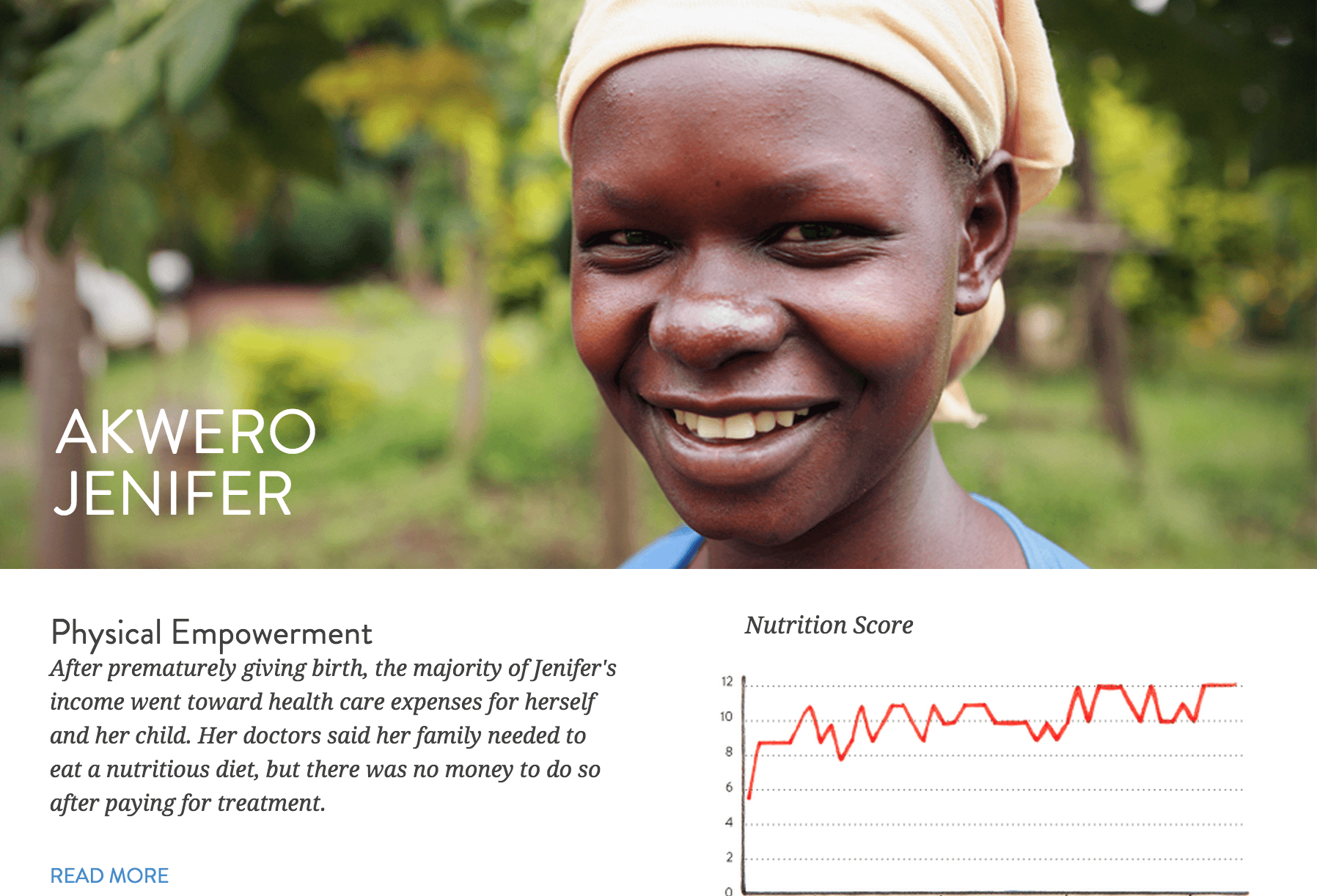
5) Visualize the numbers.
We’re huge proponents of data visualization because it is both aesthetically pleasing and an effective form of visual communication. (Fun fact: Our brains are pre-wired for visual communication, so visualizing data makes the information presented easier to comprehend and recall.)
Of course, presenting data effectively is crucial, so make sure you’re following data design best practices. And if there is particularly pertinent information that supports your story, include callouts or additional context to ensure your reader understands the data’s significance.
Tip: See our data visualization 101 guide for more info on how to design common charts and graphs, and try these 25 tips to improve your data visualizations .
Example: The 2020 EggTrack Interactive Report is an annual report that showcases the progress 100+ companies have made toward using 100% cage-free eggs by 2026. The report features a wealth of data that viewers can explore to see each company’s individual progress.

6) Follow design best practices.
The visuals you include tell your story as much as the words on the page. Your choice of illustrations, photos, colors, and fonts will all affect the viewer’s interpretation of the information.
As you move forward with design, think about how you can use every design element to enhance the experience. Depending on your core narrative, you may want to choose a particular visual theme or metaphor that relates to your story. It may also be influenced by the format you choose.
This is an opportunity to get as creative as you like. However, make sure your annual report design reflects your visual identity.
Tip: To design your report effectively, a void the most common design mistakes , and follow our tips to keep your report on brand .
Example: We designed the Pacific Life 2015 Annual Report around an aquatic theme. It helped present the brand as a living, breathing, energetic entity to remind the reader that Pacific Life is more than a life insurance company.

7) Surprise your readers.
If you challenge yourself, you can really break the mold with your annual report. This extra layer upgrades your readers’ experience, making your annual report truly memorable. Some ways to do that…
- Share a delightful photo, story, or tidbit. Warby Parker’s 2013 annual report mentioned the time their team ordered so many sides of bacon from Seamless that the service was sure there’d been a mistake.
- Include a fun little freebie. Flywheel’s 2015 Year in Review showcased the CEO getting a tattoo of the company’s logo. In honor of the event, they made custom temporary tattoos to send to anyone who requested them.
No matter your budget, you can always come up with something creative. Remember: Your annual report is a huge opportunity to make a bold statement—don’t waste it.
Tip: If you need a little more inspiration, take a look at these 50 examples of truly inspiring annual report design.
Look For More Ways to Tell Your Brand Story
Whether it’s an infographic on social media or an e-book on your website, every piece of content you create is an opportunity to tell a consistent, cohesive brand story that grabs attention and turns people into lifelong customers. If you’re looking for more ways to upgrade your content game…
- Find out what 5 ingredients you need to tell a strong brand story .
- Try these 7 tips to tell your brand story in different ways.
- Mix up your designs by experimenting with these different storytelling formats .
And if you need a little help bringing your story to life, we’d love to chat .
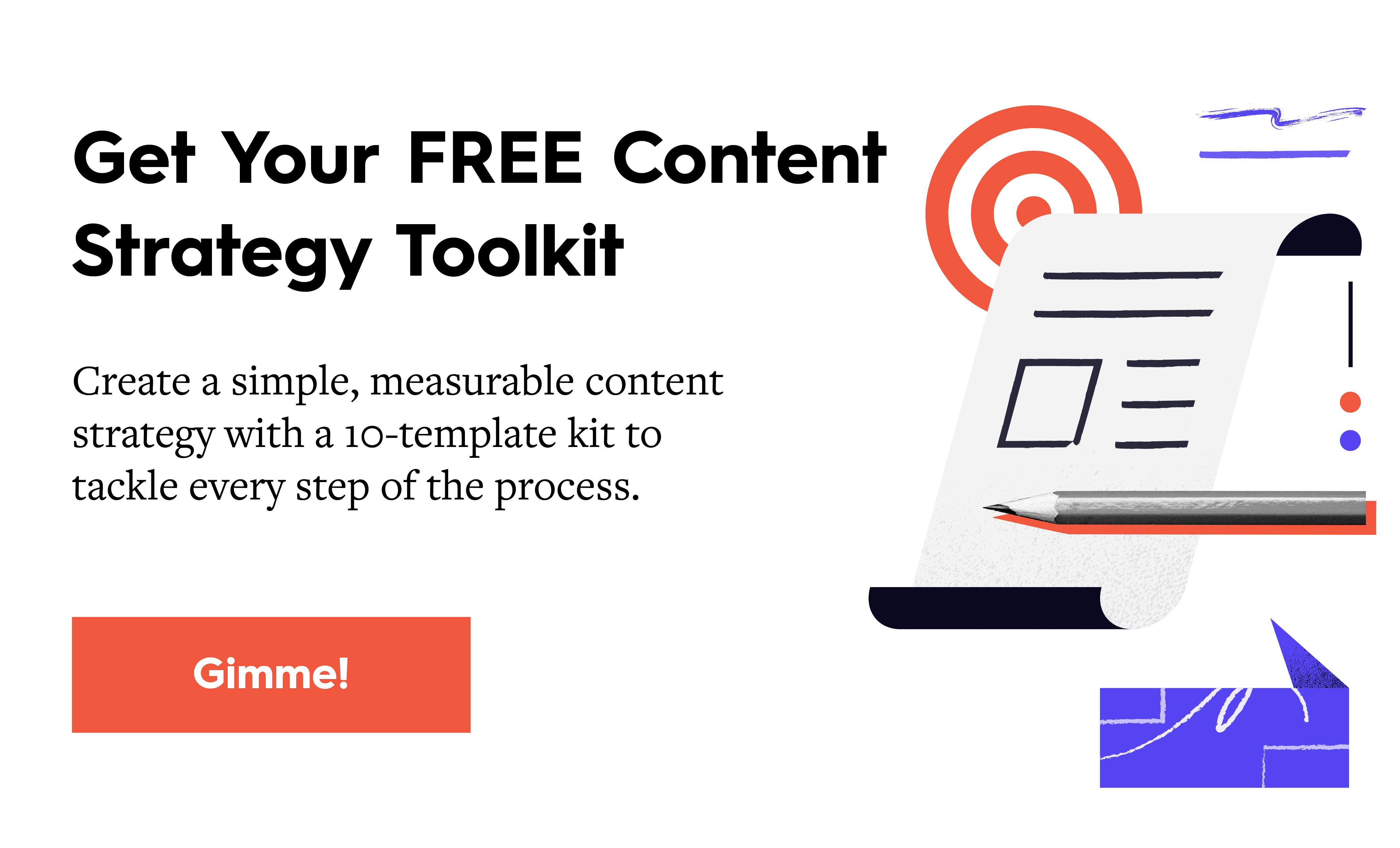
Leave a Reply Cancel reply
Your email address will not be published. Required fields are marked *
Save my name, email, and website in this browser for the next time I comment.
Related Articles
View more articles

How to Win SEO: 5 Tips to Show Off Your Experience Via Content
Agile Content Marketing , AI Marketing , B2B Marketing , Content Creation , Content Marketing , Content Strategy , SaaS Marketing

How to Create Marketing Personas in 4 Steps (With Free Template)
Brand Strategy , Content Marketing , Content Strategy

Do Tech Brands Need to Be Humanized? Not the Way You Think
Agile Content Marketing , B2B Marketing , Brand Storytelling , Content Creation , Content Marketing , Content Strategy , SaaS Marketing , Video Marketing
How To Write The Perfect Annual Report (With Examples)
Many organizations have already started putting together their Year-End Report for their donors, investors, and other stakeholders. Here are 7 steps to writing the perfect annual report that will help your annual report stand out from the crowd:
1. Make it All About Your Donors
One of the biggest newsletter and annual report mistakes that organizations keep repeating in their communications is that they forget to link their donors to the organization’s success.
According to Katya Andresen, non-profit marketeer, a great theme that is showing up lately is putting donors at the center of the report; making them the hero of your story, and the star of your show. Giving donors the credit, says Katya, makes for an incredibly effective annual report, because you show them that their support really matters. This Annual Report from the Austin Children’s Shelter does a really good job at doing just that!
Always remember to link your donors, and their donations, to your accomplishments. It’s nice to read that Ryan was able to attend 10th grade or that 500,000 trees were planted in the rainforest, but who made that happen? Here are some creative examples of how to improve titles and give credit:
- “Jerry from Brooklyn meets Mikey from the Bronx: how Jerry is helping Mikey get through school and how Mikey is teaching Jerry to stay active”
- “Company sustainability takes on a whole new meaning at Prompt Marketing Inc: planting a tree for every deadline met”
Headlines like these create unison and demonstrate alignment between the values of organizations and the people that support the organization.
You may also want to consider including a donor list in your annual report. If you have hundreds of supporters, Network for Good suggests listing donors in alphabetical order or by donation amount bracket.
2. Balance Between Storytelling and Statistics
A balance between storytelling and statistics is a good approach to take when it comes to drafting your annual report.
Statistics like the ones used by Heart to Heart International goes a long way to show impact.
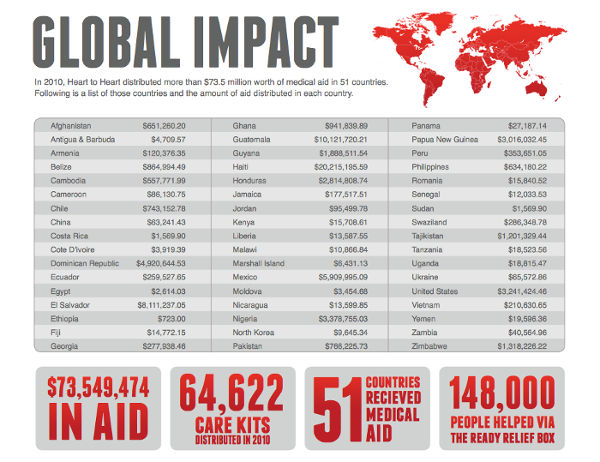
DREAM’s 2016 Annual Report , makes incredible use of statistics too. DREAM starts off its report with simple statistics and vibrant images. Less is more. By including fewer statistics, the organization can dictate what information it wants their readers’ attention to be drawn to.

In the pages that follow, the organization also highlights the stories of multiple children that have had the opportunity to get an education with their help.

Kenny’s story is inspiring and was kept short and sweet. With the help of DREAM, Kenny is on the Eagles sports team. He is now on the right path to becoming a doctor. In contrast, his sister featured on the previous page of the report, found a passion for softball. She wants to become an obstetrician with the support of DREAM’s staff and school tutors.
Storytelling can provide continuity throughout a report. This Annual Report from Crisis does a really good job at storytelling and is worth a look.
3. Subtle Calls-to-Action
Calls-to-action in your year-end report should be subtle. When you’re taking the opportunity to thank donors and share progress, the focus should remain there, but you can also take the opportunity to ask them to keep giving. Here are some creative phrases to encourage donors to keep supporting you:
Credit them: “You have made these kids’ dreams possible and you can continue to in 2020” Thank them: “We are grateful for your continued support” Include them: “Together, we can continue to reforest Brazil”

These aren’t explicit calls-to-action. However, they imply that your organization is hoping for the continued support of donors in the coming years.
Again, DREAM does a great job with this by including and acknowledging their supporters by calling them “team members”. They’re implying that they are achieving something collectively, and that their progress is only as good as every member’s contribution to their common goal.
4. Use Timelines to Highlight Your Milestones
Timelines are a handy visual aid to help communicate monthly and quarterly milestones of your organization. It also encourages designers to keep the information concise. (It’s hard to find a lot of legible text in a timeline.)
Timelines provide continuity to a story or showing a sequence of events. Most organizations have multiple highlights in their year; just writing them out with descriptions can be boring and most readers might not even finish reading the page.
The World Cup Ball Matches website uses a scrolling timeline. This shows which teams hosted and won the FIFA world cup by year.
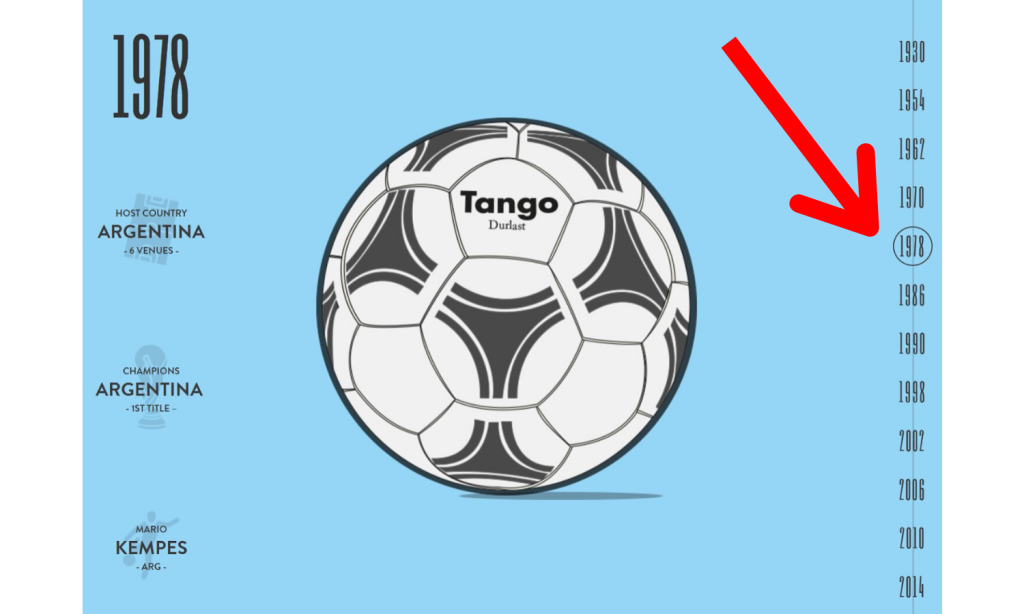
5. White Space Goes a Long Way to Help Eliminate Clutter
Your organization controls what the reader takes away from your Year-End Report. Effective use of white space increases content legibility, promotes interactions between the content and the reader (gets them thinking), and makes your calls-to-action stand out more.
Putting an emphasis on white space will also force you to pick and choose what information to include in your annual report. Too much information will overwhelm your reader and your intended takeaway message might be affected.
The Ronald McDonald House Charities make a great use of white space throughout their 2021 Annual Report . Every couple of pages, they have a quote or statistic that they want to draw the reader’s attention to.
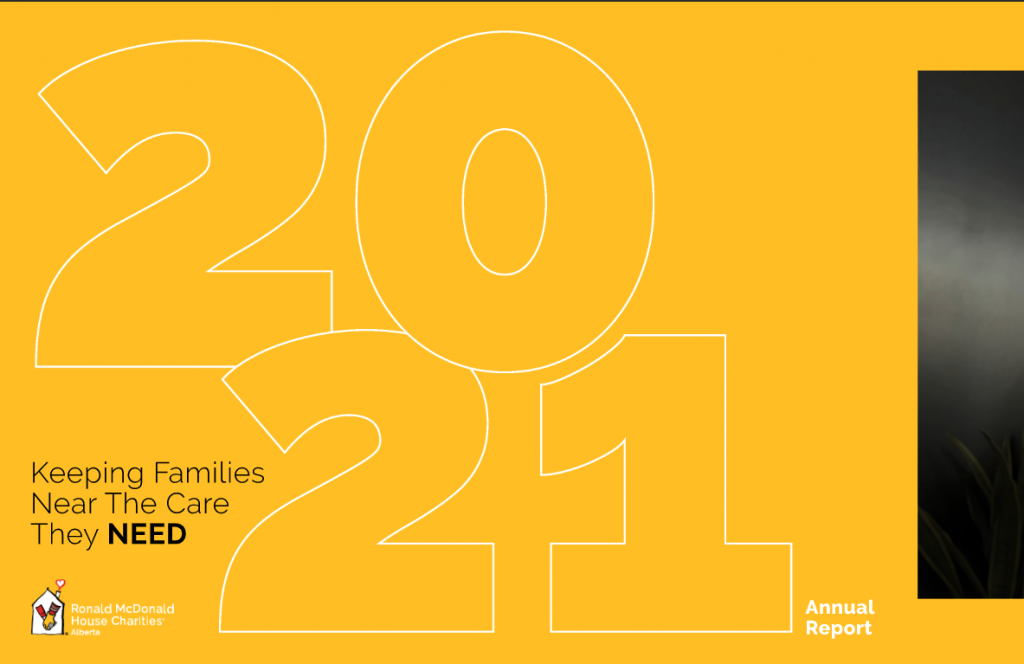
There are a couple of free tools that have thousands of templates if design isn’t your forte. Both Adobe Spark and Canva make it easy to design an annual report that looks professional. Canva includes useful templates that are easy to customize for your organization, and it’s free to use.
6. Use Vibrant, Meaningful Images
In DREAM’s Annual Report, the images focused on the children benefiting from their program, and succeeding. Using powerful images like this allows the reader to see what your organization accomplished in a way that words never could. These types of images personalize the reading experience and cr eate an emotional connection for the reader, and leave a lasting impression.
7. Make it Accessible
The last tip for writing the perfect annual report is making sure it makes it into the hands of donors, because what good is a brilliantly crafted annual report if no one reads it?
While pop-ups can be annoying, they are very interactive and a great way of informing website visitors. If your Annual Report is online or on an interactive landing page, pop-ups are effective vehicles to acknowledge donors. One Tree Planted uses pop-ups in the bottom left of the screen to inform site visitors that someone just planted trees.
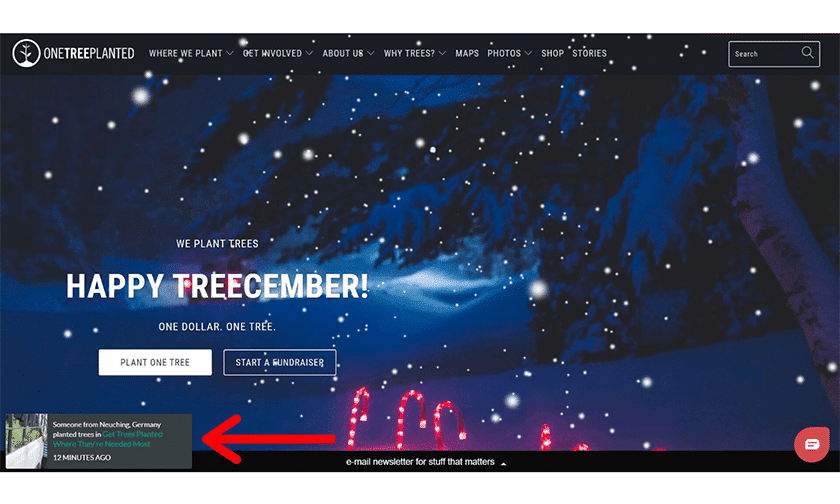
Making a landing page exclusively for your annual report makes it easy to send people there in bulk email, in a backlink on your website, or printed on a postcard. You might ever consider making it your homepage for a few months. A great example is how Girls Who Code embedded their annual report on their website in an interactive way!
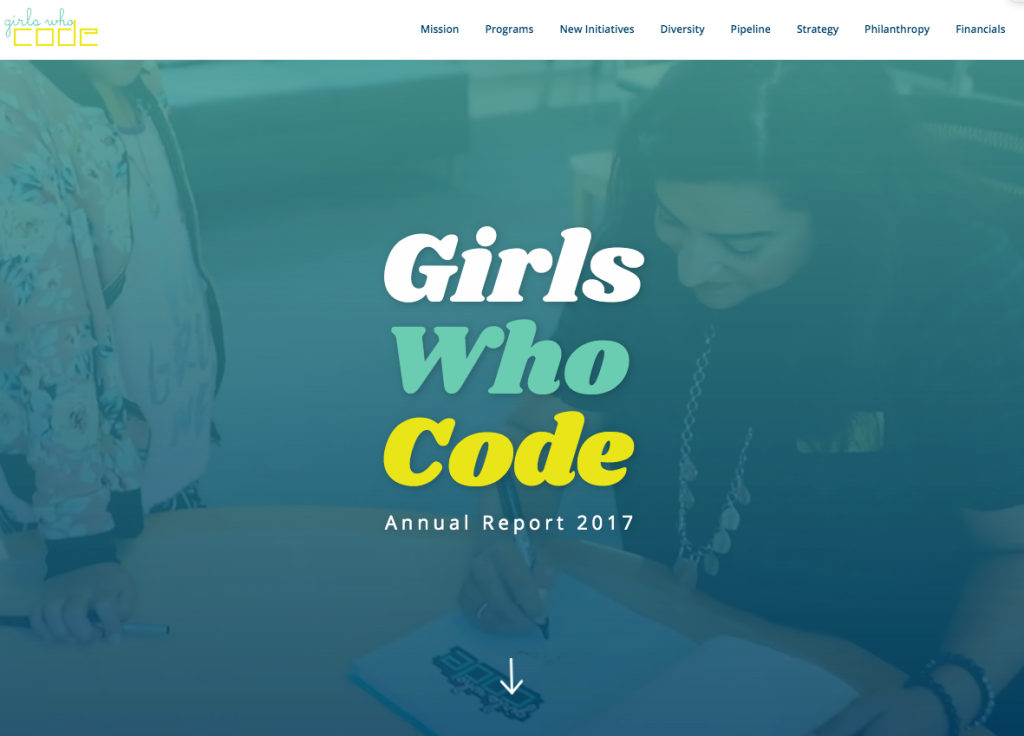
It’s all about how your organization decides to present what you’ve accomplished and what your definition of success is. The last tip of this guide is to define what your organization considers success. What determines success changes from organization to organization, and it’s important your readers know what success means for you, so they know you’ve gotten there and they will continue to support your organization to help you get there again year after year.
About the Author : Sumac is part of the Societ.com family, a company dedicated to providing exceptional software and services to nonprofits. With over 25 years of service, Silent Partner has helped organizations manage over 3 million donors and contacts across the US, Canada, UK, and Europe. Learn more .
Get More Blogs Like This Delivered To Your Inbox!
What does your nonprofit need help with.
Copyright ©2024 Societ
- Privacy Policy
Wait, don't go away empty handed.
Join 50,000 other nonprofits in getting the BEST nonprofit tips, tools, and how-to guides delivered right to your inbox!
Subscribe to our newsletter:
Lorem ipsum dolor sit amet, consectetur adipiscing elit. Ut elit tellus, luctus nec ullamcorper mattis, pulvinar dapibus leo.
- How It Works
- Find accountant
How To Write An Annual Report

An annual report holds immense significance in showcasing the progress, accomplishments, and financial health of a company. The annual report isn't just a mandatory document; it's an opportunity to communicate your business's story to stakeholders, investors, and the public. But how do you write an annual report?
Get Help With Annual Report
What is an annual report?
Annual report is a compilation of financial information that gives insight into your company’s financial position and operational activities from the previous year. A comprehensive annual report gives stakeholders, potential donors, and other interested parties information about the business, which they can use to make decisions. Filing an annual report is crucial to keep a company in good standing and to keep it as a registered entity.
How do you write an annual report?
1. start off with the shareholder's letter.
This vital communication is written by the CEO or manager of the business and its tone sets the mood for the entire report. Care should be taken to remain inspiring and positive and inject a hint of personality into this personal communication.
2. Add a general description of the industry
In this section you want to create a positive an inspiring picture of the industry as a whole . Here, you should include numeric data about your market share as a player in the industry or positive predictions that indicate the upward trend in the growth of customer awareness of your business, positive reviews or regard and your networking among key players in the industry. In this section the aim should be to inspire optimism among major stakeholders.
3. Include audited statements of income
Income and expense reports should always have been through a professional audit before being presented to shareholders, financial institutions, and potential investors. This instills an air of reliability and confidence in the reader. This section should include the annual income of the business, alongside the expense statements . Financial statements can include balance sheets, income or profit and loss statements and a cash flow statement - they sum up the financial position of the business.
4. State your financial position
In this section you can make use of colorful charts and graphs to indicate the true financial position of the business. Stakeholders want to see that the business is generating income, minimizing expenses, turning a profit and planning the next financial year according to accurate financial information.
5. Give details about cash flow
Details about the ready, inflow of cash into the business will be of great importance to those reading your report. This section should relate to the section about income statements and refer to information and graphs noted in this section. While the business may be rich in assets or potential profits, the cash flow is the total of finances being transferred in and out of a company's bank account during the financial year. This affects the liquidity of the business and is a true reflection of business stability.
6. Provide notes to the statements for line items
Your financial statements may not be easy for individuals who are not directly involved in the business to understand. For this reason, all the financial statements need to include additional notes to clarify each or several facts and figures in the statements.
In order to provide accurate details about the financial status of the business, the information used to compile the report must be as accurate as possible . Errors made during the collection process or compilation of the report can substantially affect the viewpoint of shareholders and fuel funding concerns as well as affect management decisions. In this segment we explain how a report is written, how to avoid mistakes during data collection and provide encouragement on how to begin the process.
What should be included in an annual report?
The six basic components of an annual report are:
- The shareholder's letter
- General description of the industry
- Audited Income Statements
- Financial Position
- Explanatory notes
You may include brief additional sections, but it's generally recommended to adhere to these six basic sections. This makes the report easier and less time-consuming to read and easier to understand at a glance. Aim for an inspiring, concise report that paints a positive picture of the status of company's finances.
What to consider when writing an annual report?
1. planning.
The success of every financial report begins in the planning stage . In this stage you consult and involve the planning committee to determine the data you need, who is responsible for collating and compiling income and expenditure reports, data on operations or information on accounting practices and requirements. It is important to include all the relevant information, without making the report too long or tedious to read.
Remember : Shareholders and stakeholders are interested in finding out the results of your yearly operations.
Aim to include relevant information in an inspiring report . To do this you want to include meaningful results, not just long lists of data. Try to use the facts and figures included in the report to tell a story . At this stage you will want to develop a basic framework for the data, graphs, charts, predictions and photographs you want to include in the report.
3. Pitfalls to avoid
When learning how to write an annual report, mistakes are inevitable. As already noted, making the report too long, confusing or tedious to read is a common mistake.
Tip : you want to stick to the shortest possible length, while providing ALL the relevant data. This data should be relevant to the particular stakeholders or potential donors you want to attract. Including too many details and information about daily operations will result in boredom and doesn't get down to the basic results that the parties need to know.
Make sure to answer the following questions:
- Why does the company exist?
- What is the vision or objective of the business?
- What is the strategy to reach this goal?
- How does the company make money?
- Online reports: What is included in the annual report?
The importance of online annual reports
These days many companies share their annual reports online. This is an effective way to reach many stakeholders at once and allow sharing of the document with interested parties in a network. While reports are similar to paper copies, online reports are an excellent way to get immediate feedback on your annual reports. By including an online feedback facility or response form, readers and shareholders can respond personally to the CEO, asking for more information, improved formatting or praising the content and structure of the report. So, don't forget to consider online cloud-based platforms and other online formats.

Do you need help with Annual Report?
Finding the right accountant has never been easier. In just 5 minutes, we'll get to know you and the kind of help you're looking for.

Related articles
Accounting software vs. hiring an accountant: pros and cons, how much does an accountant cost, the ultimate breakdown of the "80-120 rule", get new articles delivered to your inbox., let's find your next accountant..
- Tax Professional
Please briefly describe your needs. A Client Consultant will reach out to confirm the details.
cta_box.sub_headline
Let's get to know each other
- Business Essentials
- Leadership & Management
- Credential of Leadership, Impact, and Management in Business (CLIMB)
- Entrepreneurship & Innovation
- Digital Transformation
- Finance & Accounting
- Business in Society
- For Organizations
- Support Portal
- Media Coverage
- Founding Donors
- Leadership Team

- Harvard Business School →
- HBS Online →
- Business Insights →
Business Insights
Harvard Business School Online's Business Insights Blog provides the career insights you need to achieve your goals and gain confidence in your business skills.
- Career Development
- Communication
- Decision-Making
- Earning Your MBA
- Negotiation
- News & Events
- Productivity
- Staff Spotlight
- Student Profiles
- Work-Life Balance
- AI Essentials for Business
- Alternative Investments
- Business Analytics
- Business Strategy
- Business and Climate Change
- Design Thinking and Innovation
- Digital Marketing Strategy
- Disruptive Strategy
- Economics for Managers
- Entrepreneurship Essentials
- Financial Accounting
- Global Business
- Launching Tech Ventures
- Leadership Principles
- Leadership, Ethics, and Corporate Accountability
- Leading Change and Organizational Renewal
- Leading with Finance
- Management Essentials
- Negotiation Mastery
- Organizational Leadership
- Power and Influence for Positive Impact
- Strategy Execution
- Sustainable Business Strategy
- Sustainable Investing
- Winning with Digital Platforms
How to Quickly & Effectively Read an Annual Report

- 04 Jun 2020
Intelligent investing requires analyzing a vast amount of information about a company to determine its financial health. Armed with this information, an investor can better understand how much risk might be involved with backing a company based on how well it’s performed historically, in recent quarters, and toward its financial targets.
Exactly where this information comes from depends on the specific company that’s being invested in, but typically requires several financial statements, including a balance sheet, cash flow statement, and income statement.
In addition to these documents, most investors look forward to reviewing a company’s annual report—a collection of financial information and analysis that can prove invaluable in evaluating the health of a company.
If you’re not an investor, but an employee working within a corporation, the annual report can impart valuable information pertinent to your career. Understanding how your company is performing and the impact your actions have had on its business objectives can help you advocate for a promotion or other form of career advancement .
If you’re unfamiliar with what goes into an annual report, there’s some good news: You don’t need to be a financial expert to get value out of the document or understand the messaging in it.
Here’s an overview of the different information you’ll find in an annual report and how you can put it to use.
Access your free e-book today.
What Is an Annual Report?
An annual report is a publication that a public corporation is required by law to publish annually. It describes the company’s operations and financial conditions so that current and potential shareholders can make informed decisions about investing in it.
The annual report is often split into two sections, or halves.
The first section typically includes a narrative of the company’s performance over the previous year, as well as forward-looking statements: Letters to shareholders from the chief executive officer, chief financial officer, and other key figures, as well as graphics, photos, and charts.
The second section strips the narrative out of the picture and presents a variety of financial documents and statements.
Unlike other pieces of financial data—and because they include editorial and storytelling—annual reports are typically professionally designed and used as marketing collateral. Annual reports are sent to shareholders every year before an annual shareholder meeting and election of the board of directors, and often accessible to the public via the company’s website.
Annual Report vs. 10-K Report
Annual reports aren’t the only documents public companies are required to publish yearly. The US Securities and Exchange Commission (SEC) requires public firms also to produce a 10-K report , which informs investors of a business’s financial status before they buy or sell shares.
While there’s similar data in both an annual and 10-K report, the two documents are separate.
10-K reports are organized per SEC guidelines and include full descriptions of a company’s fiscal activity, corporate agreements, risks, opportunities, current operations, executive compensation, and market activity. You can also find detailed discussions of operations for the year, as well as a full analysis of the industry and marketplace.
Because of this, 10-K reports are longer and denser than annual reports, and have strict filing requirements—they must be filed with the SEC between 60 to 90 days after the end of a company’s fiscal year.
If you need to review a 10-K report, you can find it on the SEC website .
What Information Is Contained In An Annual Report?
An annual report typically consists of:
- Letters to shareholders: These documents provide a broad overview of the company’s activities and performance over the course of the year, as well as a reflection on its general business environment. An annual report usually includes a shareholder letter from the CEO or president, and may also contain letters from other key figures, such as the CFO.
- Management’s discussion and analysis (MD&A): This is a detailed analysis of the company’s performance, as conducted by its executives.
- Audited financial statements: These are financial documents that detail the company’s financial performance. Commonly included statements include balance sheets, cash flow statements, income statements, and equity statements.
- A summary of financial data: This refers to any notes or discussions that are pertinent to the financial statements listed above.
- Auditor’s report: This report describes whether the company has complied with generally accepted accounting principles (GAAP) in preparing its financial statements.
- Accounting policies: This is an overview of the policies the company’s leadership team relied upon in preparing the annual report and financial statements.
What to Look for in an Annual Report
While all the information found in an annual report can be useful to potential investors, the financial statements are particularly valuable, as they provide data that isn’t obscured by any sort of narrative or opinion. Three of the most important financial statements you should evaluate are the balance sheet, cash flow statement, and income statement.
The balance sheet shows a company’s assets, liabilities, and owners’ equity accounts as of a specific date, illustrating its financial position and health.
The income statement shows a company’s revenue and expense accounts for a set period, allowing you to gauge its financial performance. Using trial balances from any two points in time, a business can create an income statement that tells the financial story of the activities for that period.
Cash flow statements provide a detailed picture of what happened to a business’s cash during an accounting period. A cash flow statement shows the different areas in which a company used or received cash, and reconciles the beginning and ending cash balances. Cash flows are important for valuing a business and managing liquidity, and essential to understanding where actual cash is being generated and used. The statement of cash flows gives more detail about the sources of cash inflows and the uses of cash outflows.
These three documents can help you understand the financial health and status of a company, and they’re all included in the annual report. When you read the annual report—including the editorial information—you can gain a better understanding of the business as a whole.
An annual report can help you learn more details about what type of company you work for and how it operates, including:
- Whether it’s able to pay debts as they come due
- Its profits and/or losses year over year
- If and how it’s grown over time
- What it requires to maintain or expand its business
- Operational expenses compared to generated revenues
All of these insights can help you excel in your role, be privy to conversations surrounding the future of the company, and develop into an effective leader .

Critical Information for Investors and Employees Alike
Being able to analyze annual reports can help you gain a clearer picture of where a company sits within its industry and the broader economy, illuminating opportunities and threats.
The best part about learning to read and understand financial information is that you don’t need to be a certified accountant to do so. Start by analyzing financial documents over a set period. Then, when the annual and 10-K reports are published, you can review and understand what leadership is saying about the operational and financial health of your company.
If you’re an investor, knowing how to read an annual report can give you more information from which to base your decision on whether to invest in a company. If you’re an employee within an organization, learning how to read and apply the information contained in an annual report is an essential financial accounting skill that can help you understand your company’s goals and capabilities and, ultimately, further your career.
Do you want to take your career to the next level? Explore Financial Accounting and our other online finance and accounting courses , which can teach you the key financial topics you need to understand business performance and potential. Download our free course flowchart to determine which best aligns with your goals.

About the Author

How to Create a Standout Nonprofit Annual Report + Template
For nonprofits like yours, a thoughtfully written and well-designed annual report can be an invaluable fundraising tool. It can be used to cultivate new relationships with donors, sponsors, volunteers, and other community members. Plus, it helps recognize and retain those who have helped you make progress toward your goals over the past year.
With so much at stake, it’s critical to take the creation of your annual report seriously and seek guidance on how to make it a useful resource for your organization’s community. To help you get started, this guide will cover all you need to know about nonprofit annual reports, including:
What is a nonprofit annual report?
Nonprofit annual report template & elements to include, choosing a format for your annual report, nonprofit annual report best practices, our favorite nonprofit annual report examples.
These tips and strategies will put you well on your way to creating a digestible, engaging annual report that inspires your audience to continue supporting your organization’s work. Let’s dive in!

An annual report is a document designed to highlight your nonprofit’s major accomplishments, build confidence in your organization, inspire readers to support your mission, and thank the donors and volunteers who make your work possible.
Nonprofits typically compile and release these reports every year, although they aren’t always mandatory. On a national level, the only document you’re required to file to maintain your organization’s 501(c)(3) status is an annual tax return via IRS Form 990 . However, some state governments request a copy of nonprofits’ annual reports to maintain their charitable solicitation registration in that state, so make sure to stay up-to-date on your state’s filing requirements .
Benefits of Creating an Annual Report
Even if your nonprofit isn’t required to file its annual report with your state, there are advantages to compiling one. For most nonprofits, the ultimate goal—and the ultimate benefit—of their annual report is simple: retaining current supporters and acquiring new ones.
To accomplish this goal, your annual report must fulfill several smaller purposes, each of which benefits your organization’s long-term health:
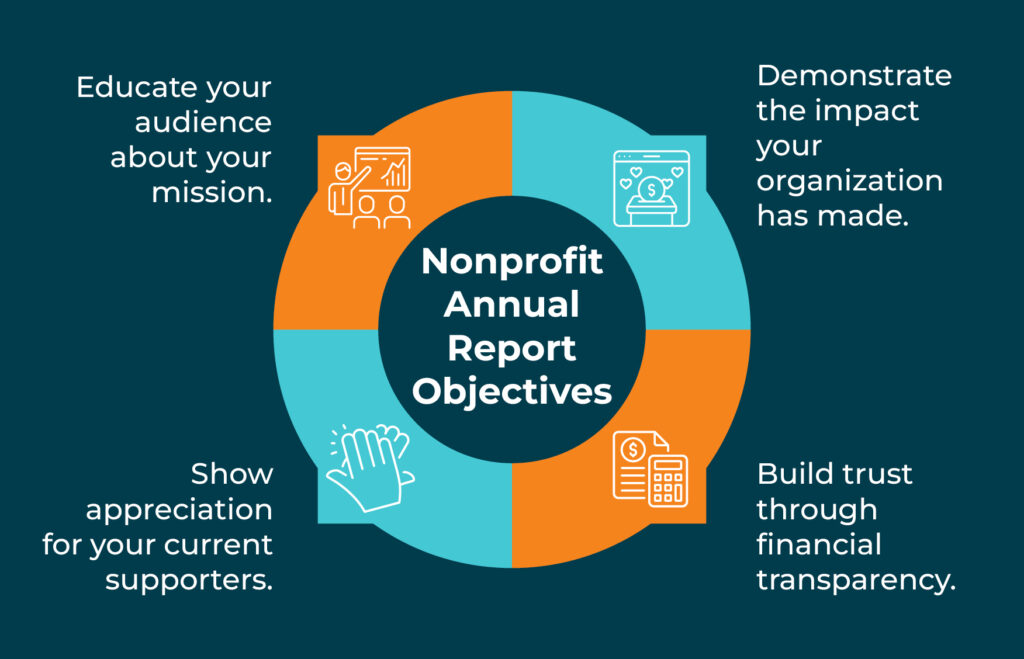
- Educate your audience about your mission.
- Demonstrate the impact your organization has made.
- Build trust through financial transparency.
- Show appreciation for your current supporters.
Additionally, although annual reports reflect on the past year, they can also establish a framework for your nonprofit to move forward and achieve more in the year to come!
Annual Reports & Prospect Research
It’s common for nonprofits to include the names of their major donors and the projects they contributed to somewhere in their annual reports. This information can help feed charitable giving databases that you can use for prospect research. DonorSearch , for example, culls hundreds of annual reports to collect data on major donors’ giving history.
While your annual report can cultivate better relationships with existing donors and encourage others to support your cause, you can also use the information from other nonprofit reports to fuel your prospect research. Prospect research professionals can find a wealth of ideal prospects for your nonprofit just by looking at the annual reports of similar organizations.
Let’s say that your nonprofit works to reduce food insecurity for children in your area. If a local hospital highlighted a major donor in their annual report who contributed to the hospital’s pediatric intensive care unit, your organization might want to target that person as a potential major donor, since you can infer that they’re likely interested in helping children.

If you’re creating your nonprofit’s first-ever annual report or looking to switch up your format, it can be useful to work off of a template. The template below is a representation of a page of your annual report or a shortened digital version you can deliver via email. The use of graphics and images provides a suggestion for how to effectively divide up the space and produce a more visually appealing layout:

This template includes the four most essential elements of a nonprofit annual report, which we’ll discuss in more detail in the following sections.
1. Clear Mission Statement
Dedicated, long-time supporters and individuals who are brand new to your organization’s community will both read your annual report. Each of these groups of readers should be confident in their understanding of your organization’s mission before diving into the data, which is why you should write out your mission statement at the beginning of the report.
Keep your mission statement to one or two sentences to help it stick in readers’ minds, and ensure it includes the most important details about why your organization does what it does every day. One nonprofit that does this particularly well is the American Red Cross , whose mission statement reads, “The American Red Cross prevents and alleviates human suffering in the face of emergencies by mobilizing the power of volunteers and the generosity of donors.”
You can also include your vision statement alongside your mission statement. Your vision statement is a sentence that describes the future state your nonprofit is working toward—i.e., what you hope the world will look like when your mission is accomplished.
2. Major Achievements From the Past Year
The majority of your annual report should focus on the activities and projects your organization completed over the past year, from hosting fundraising events to coordinating volunteer efforts to delivering services in your community. Reflect on your organization’s audience and what would be most interesting to them, but make sure to share your biggest accomplishments!
First, use your fundraising tools to break down your achievements into statistics your readers can easily understand. You might report the total amount your donors gave, the number of hours your volunteers worked, or how many social media followers you gained. Then, format that data using graphs and visualizations to make it easier for readers to understand, and supplement the numbers with photos and true stories about your work to further emphasize your impact.
3. Financial Information
It’s no secret that your donors want to know how your nonprofit is using their money to further your mission. Being honest and transparent about your spending and fundraising builds trust with your existing supporters. Plus, it shows potential donors that your nonprofit can manage funds responsibly and effectively, which can make them more likely to give.
However, some high-impact donors who are very financially literate will want to see detailed records of your nonprofit’s financial status, while others would prefer an easy-to-follow, summarized version of the data. To accommodate both of these preferences, include graphical representations of key financial information in the body of your annual report, then attach detailed financial statements as appendices for donors who want to learn more.
4. List of Major Contributions
In addition to showcasing your nonprofit’s success, your annual report is also about thanking those who helped you achieve those goals. The best way to do this is by listing out and thanking your major donors , board members, and organizational leadership.
Additionally, include a general statement of thanks to your volunteers and donors at all levels. Although you should have a more personalized thank-you cadence for each supporter when they contribute, a general shoutout will make them feel appreciated and seen by your organization!
Once you add each of the elements listed above to your annual report, you’ll need to decide how to present the information to your nonprofit’s community. While most organizations publicize their annual reports on a dedicated page of their websites, how you further publicize it will depend on your audience’s preferences.
A combination of hard-copy and digital annual report materials will generally reach the widest audience. Here are some popular formats in each category to consider:
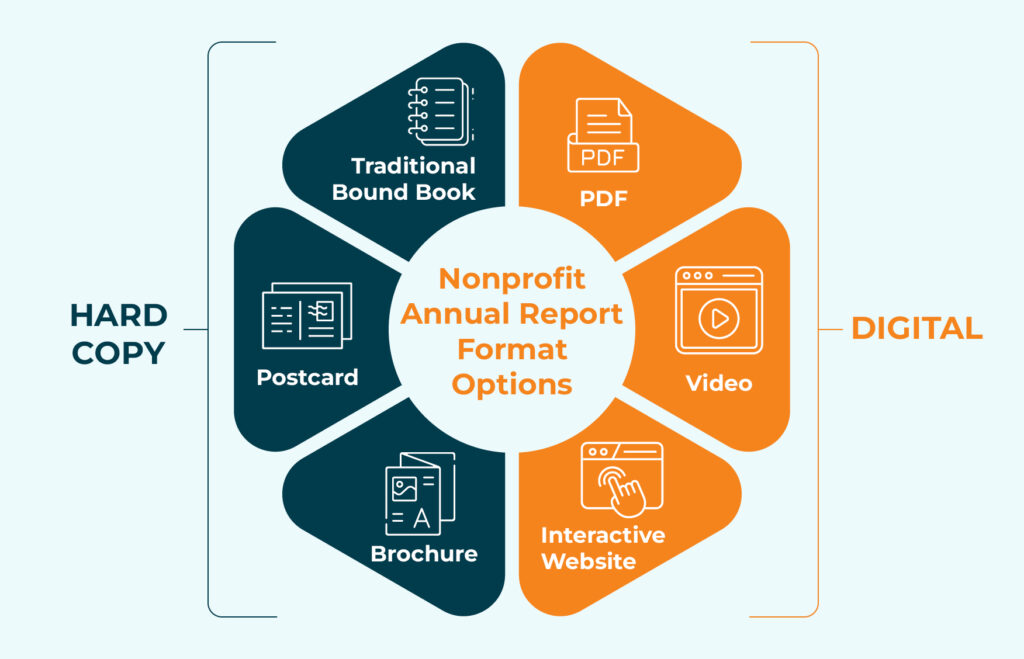
Hard Copy Annual Reports
- Traditional bound book: These can be anywhere from a few to 100 pages long and are great for compiling a large amount of information in a substantial, tangible way. No matter how long your report is, make sure to keep the content engaging and break up the text with plenty of visuals.
- Postcard: If you’d like to maximize digestibility, postcards are a good choice. With well-designed infographics, pictures, and statistics, supporters can very quickly understand how your organization did last year. Because of space limitations, you’ll have to sacrifice some copy, so if you want to tell detailed stories or include a long list of donors, choose a longer-form option.
- Brochure: Still considered a quick read, brochures are a middle ground between a postcard and a book. The folds in a brochure create natural divides to easily section your information and design.
Digital Annual Reports
- PDF: If you want the space that a book offers but don’t want to spend the money or use tons of paper to print it, PDFs are a good solution. You can make them as long or short as you like, embed other digital content like links, videos, and PowerPoint presentations, and easily upload them to your website or attach them to an email.
- Video: Video annual reports show, rather than tell, your audience what your organization has accomplished. Make sure your final video comes across as professional in its editing and production , and recruit outside help if necessary.
- Interactive website: Consider building a webpage or mini-site that houses an interactive version of your annual report. Your audience could click through a photo gallery, expand graphs for a more detailed view, and play multiple short videos, making for an immersive experience.
If you use multiple formats, think about who the primary audience is for each type. Newer, lower-level supporters will likely be happy with condensed versions of your annual report like videos or postcards, while important stakeholders will want to see more comprehensive information in a book or PDF.
Now that you know what to include in your annual report and your options for formatting it, you’re likely ready to dive into creating your own. As you compile the report, keep these six best practices in mind.
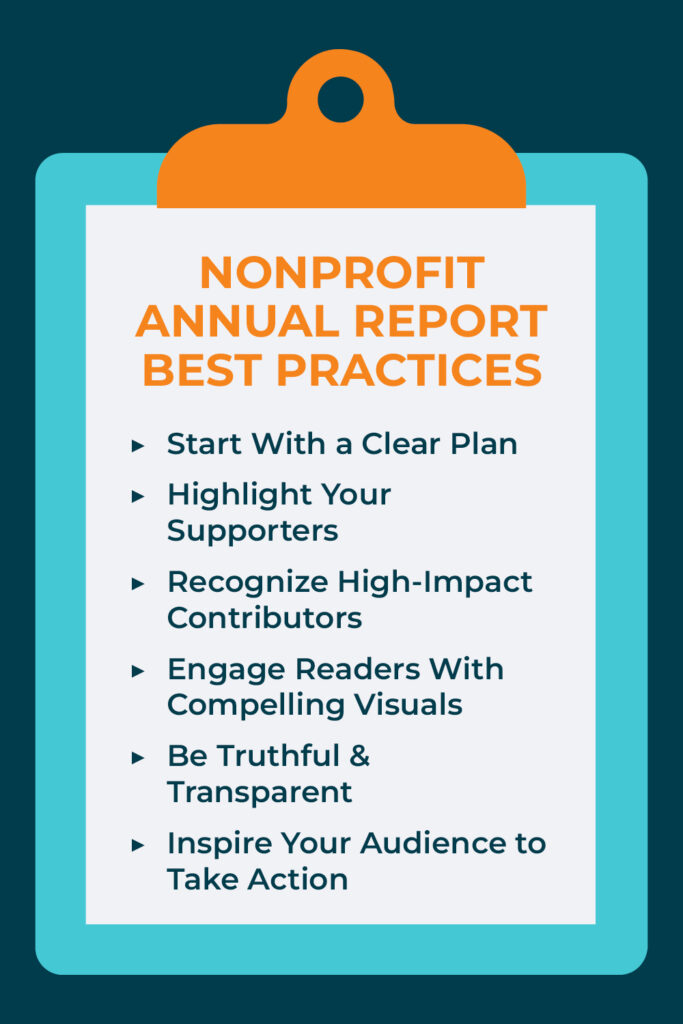
1. Start With a Clear Plan
The first step for every successful project at your nonprofit is creating a plan, and your annual report is no exception. You’ll likely need the help of multiple team members or departments to assemble all of the information, as well as compile and design the document.
First, determine your report’s audience. This will likely include your current supporters as well as prospective donors, corporate sponsors , and grantmaking foundations. If you have to file your annual report with your state government, they’re also part of your audience.
Then, consider your purpose and strategy. At its core, your annual report should persuade your audience to support your cause. However, you might have smaller objectives, such as highlighting a new project or attracting more local sponsors, that align with your nonprofit’s strategic plan. Because it’s difficult to cover everything your organization has done in a year in a single document, focus your report on three to five core themes that point readers back to your objectives.
Finally, turn to the action aspect of your plan. This part of your strategy may include:
- Delegating responsibilities and creating timelines for team members.
- Interviewing supporters, leaders, and beneficiaries.
- Compiling and formatting financial data.
- Collecting key metrics from fundraising campaigns.
When your nonprofit has a clear plan, the process of creating your report will go more smoothly, and the end result will be more impactful.
2. Highlight Your Supporters
As we’ve mentioned before, your annual report is a chance to showcase the good your nonprofit has done. That being said, it’s easy for nonprofits to simply celebrate their accomplishments and forget to mention the support that made them possible.
Rather than focusing solely on your achievements, highlight how different projects and programs were realized because of your supporters’ contributions. Every form of support your organization received was essential to your success, so thank them for their monetary gifts, in-kind donations, volunteer time, event participation, advocacy for your cause, and more.
By showing donors and volunteers that your accomplishments were possible because of their support, they’ll know that you’re aware of everything they do. Plus, it demonstrates to potential donors that your nonprofit is built on the support of passionate people and encourages them to join that community.
3. Recognize High-Impact Contributors
In addition to discussing your supporters’ accomplishments generally, set aside space in your annual report to draw extra attention to the supporters who went above and beyond for your cause. Besides the customary list of major donors and the initiatives they supported, consider including stories about some of these donors or other individuals who have been especially impactful to your cause, such as a loyal volunteer or a long-serving board member.
High-impact supporters like this deserve much more recognition than a simple, generic thank-you message, and your annual report is a great place to publicly show your gratitude. When donors feel appreciated and valued in this way, they’re more likely to continue engaging with your nonprofit long-term.
4. Engage Readers With Compelling Visuals
Compiling all of your efforts and data from the past year and condensing them into a single document provides a lot of information for current and prospective supporters to read! This is where strategically placed visuals come in.
Along with capturing and keeping readers’ attention, annual report visuals have many benefits, such as:
- Breaking up blocks of text to make the report more skimmable.
- Transforming complex data into easy-to-understand graphs.
- Translating your mission statement into a tangible need that your audience can develop a passion for.
Incorporate a combination of graphical data visualizations and relevant photos into your report, and make sure to get subjects’ consent if the pictures include any people. For online reports, make some of your visuals interactive for increased engagement.
5. Be Truthful & Transparent
While your annual report is primarily about highlighting your success, it’s important to be honest about your organization’s progress. Sometimes your projects won’t go as planned—and that’s okay!
By briefly mentioning your missteps and how you plan to correct the issue in the future, you’ll show your audience that you’re proactive in solving problems. Make sure to address:
- The causes of your setbacks (if you know what they are).
- The changes you plan to make in the future based on the information you currently have.
- How you’ll gather and incorporate feedback from your supporters as you address these issues.
Touching on setbacks will paint a full picture of the previous year’s progress and demonstrate to donors that despite your challenges, you were still able to make significant strides in furthering your mission.
6. Inspire Your Audience to Take Action
Once you’ve effectively conveyed your mission and achievements in your annual report, many readers might be wondering, “What’s next?”
Dedicate space in your annual report to let readers know how they can support your cause. At minimum, include a link or QR code to your online donation page depending on what format you choose. You might also direct readers to other ways they can get involved, such as:
- Signing up to volunteer
- Registering for the first fundraising event of the new year
- Taking advantage of corporate philanthropy programs like employer matching gifts or volunteer grants
Additionally, mention other places where readers can learn more. Include your organization’s website URL, phone number, mailing and email addresses, and social media handles so your audience can stay in touch with you.
To show you these strategies in practice, we’ve compiled a list of our top five nonprofit annual reports. If you still aren’t sure where to start with creating your organization’s annual report, these examples might just spark some inspiration!
The Nature Conservancy
The Nature Conservancy (TNC) describes itself as “a global environmental nonprofit working to create a world where people and nature can thrive.” For their 2022 annual report, they chose two eco-friendly formats: an interactive website and a PDF that their international community of readers can download in English, Spanish, or Mandarin.
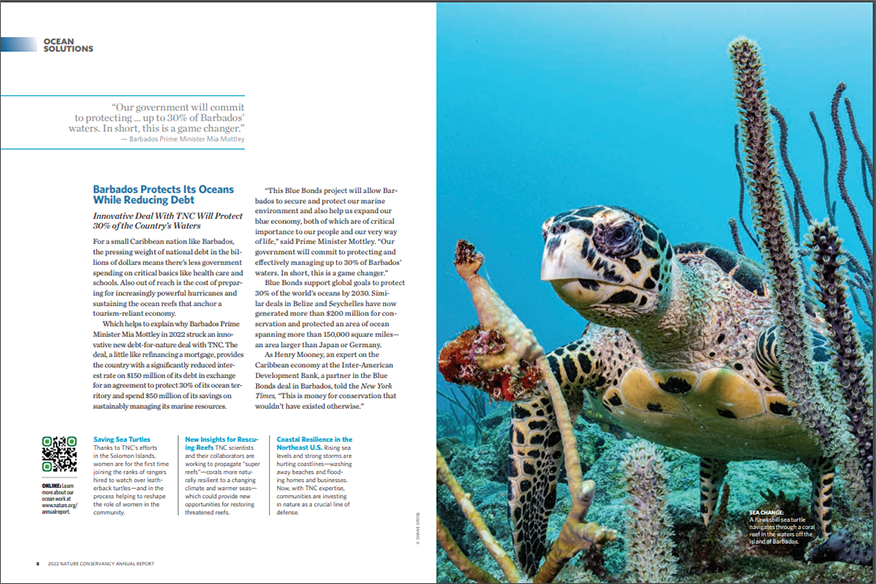
Some highlights of TNC’s report include:
- A concise explanation of their “2030 Goals” strategic plan with accompanying graphics.
- Articles on each of their key projects that highlight their donors and partners, along with relevant photos and opportunities to learn more.
- Multiple formats for their financial data, including a summary bar graph, a letter from the CFO, and a detailed accounting report.
Read The Nature Conservancy’s full annual report .
National FFA Organization
The National FFA Organization (FFA stands for Future Farmers of America) is “the premier youth organization preparing members for leadership and careers in the science, business and technology of agriculture.” FFA compiles a digital annual report that can be viewed as a downloadable PDF or on a dedicated mini-site.
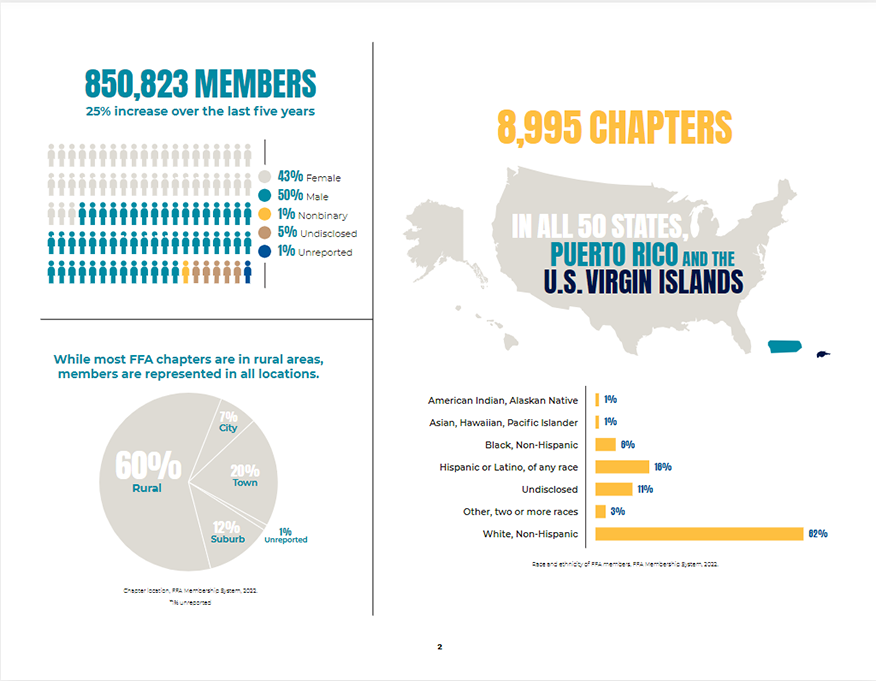
Some highlights of FFA’s 2022 annual report include:
- An organized three-part structure based on the pillars of the nonprofit’s 2022-2025 strategic plan: Evolve, Engage, and Empower.
- A timeline highlighting the most important activity or achievement of each month.
- Branded graphics that compile and summarize statistics about all of the nearly 9,000 local FFA chapters.
Read the National FFA Organization’s full annual report.
World Vision International
World Vision International (WVI) is a faith-based nonprofit organization that works to respond to poverty, provide emergency relief, and promote social justice around the world. Its eye-catching 2022 annual report is available as a downloadable PDF on their website.
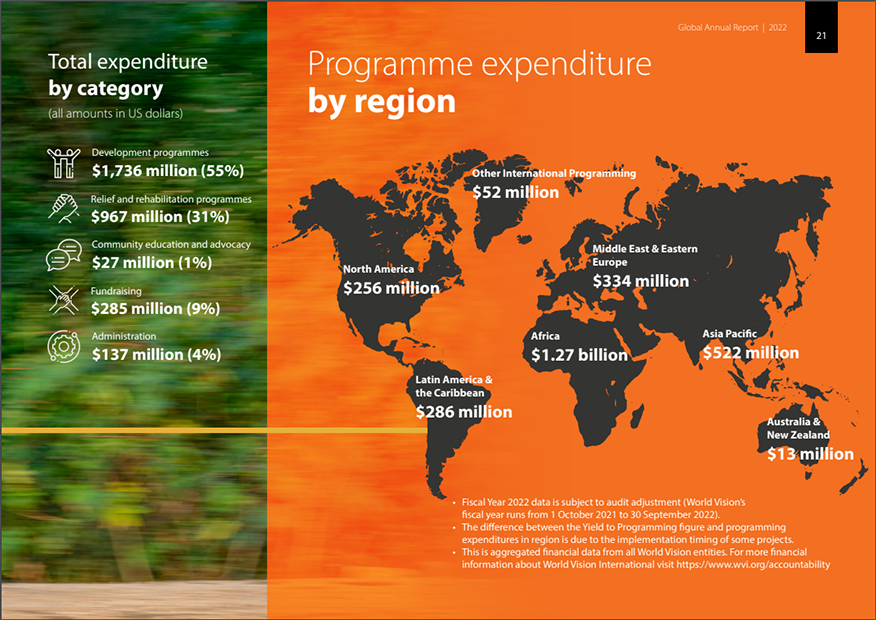
Some highlights of WVI’s annual report include:
- Large photos of smiling beneficiaries—several of which are accompanied by testimonials—to put a face to the impact data featured.
- A strong emphasis on the impact of supporters’ participation in the child sponsorship program.
- Graphs showing the organization’s increase in total revenue over the past six years and a detailed but easily readable summary of annual expenditures.
Read World Vision International’s full annual report .
Smithsonian Institution
The Smithsonian Institution’s mission is to promote “the increase and diffusion of knowledge,” which it does through the 21 museums and one zoo under its control. Because there are so many cultural organizations within this one nonprofit, it produces an extremely comprehensive annual report book each year.
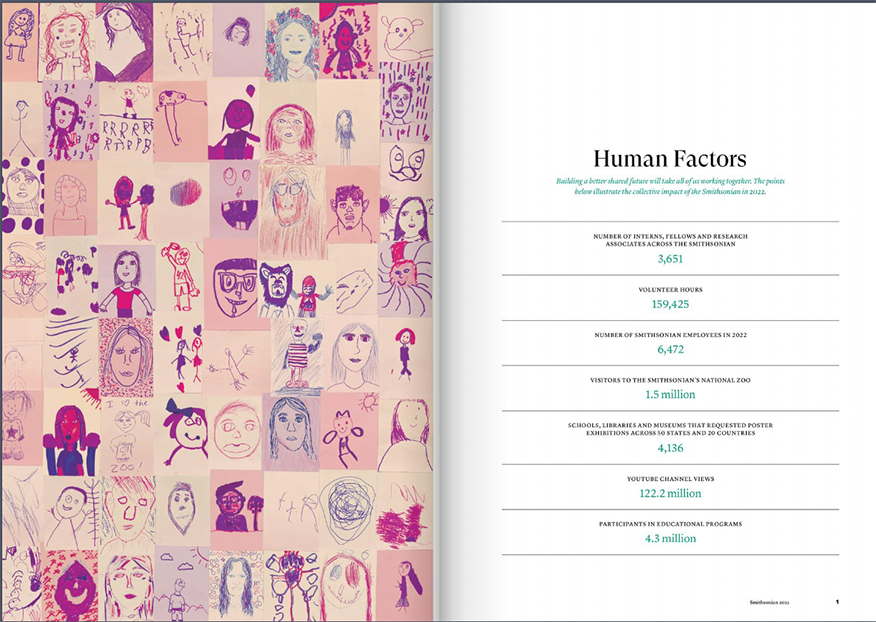
Some highlights of this organization’s 2022 annual report include:
- The statistics in the first spread of the book that highlight the audience’s impact right off the bat.
- First-person perspectives from staff members at many of the Smithsonian’s cultural organizations.
- A thorough and well-organized list of corporate sponsors and major donors.
Read the Smithsonian Institution’s full annual report .
Boston Children’s Hospital
Some large nonprofits, such as higher education or healthcare organizations, may benefit from producing multiple annual reports each year that each focus on one of their areas of work. Boston Children’s Hospital , one of the largest pediatric hospitals in the United States, creates separate reports for each of its individual programs to better highlight the progress and supporters of each one. A few examples include:
- Neighborhood Partnerships
- Family Advisory Council
- Office of Community Health

Not only do all of these reports include high-quality data presentations and storytelling, but their visual design appeals to each program’s audience. For example, the Office of Community Health uses a dark color scheme when discussing serious health data, while the bright colors in the Neighborhood Partnerships report give it a welcoming feel. However, all of the reports still feature the Boston Children’s Hospital logo to unify them.
Final Thoughts
An annual report is an effective tool for closing out your nonprofit’s year. It empowers you to highlight your achievements and recognize everyone who has helped you along the way. With the tips and strategies in this guide, you can create an effective annual report that donors look forward to receiving every year.
Remember that annual reports from other nonprofits also provide value to your work. The information within those reports can offer deeper insights that you can use to identify and build relationships with prospective donors.
To learn more about boosting your nonprofit’s fundraising performance, check out these resources:
- Major Gifts: A Guide to Securing Large Donations . Dive deeper into the process of securing major gifts from the donors you’ll feature in the list of major contributors in your annual report.
- Your Annual Fund: A Definitive Guide to Boost Your Strategy . Your nonprofit’s annual fund provides a financial foundation for all of the initiatives you report each year. Discover the best strategies to fill this fund.
- Fundraising Intelligence: Using AI to Enhance Philanthropy . Explore how to leverage AI-powered tools to fundraise and report on your organization’s activities more intelligently.
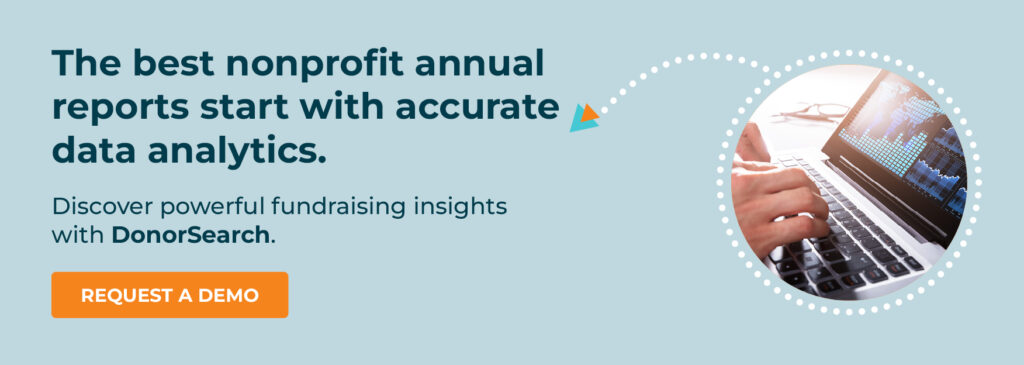
Introducing Enhanced CORE
Introducing Enhanced CORE by DonorSearch — your organization’s gateway to AI. Our AI-powered fundraising platform is the perfect entry point for organizations looking to harness the power of predictive artificial intelligence. Join us in embracing the future of fundraising with confidence.
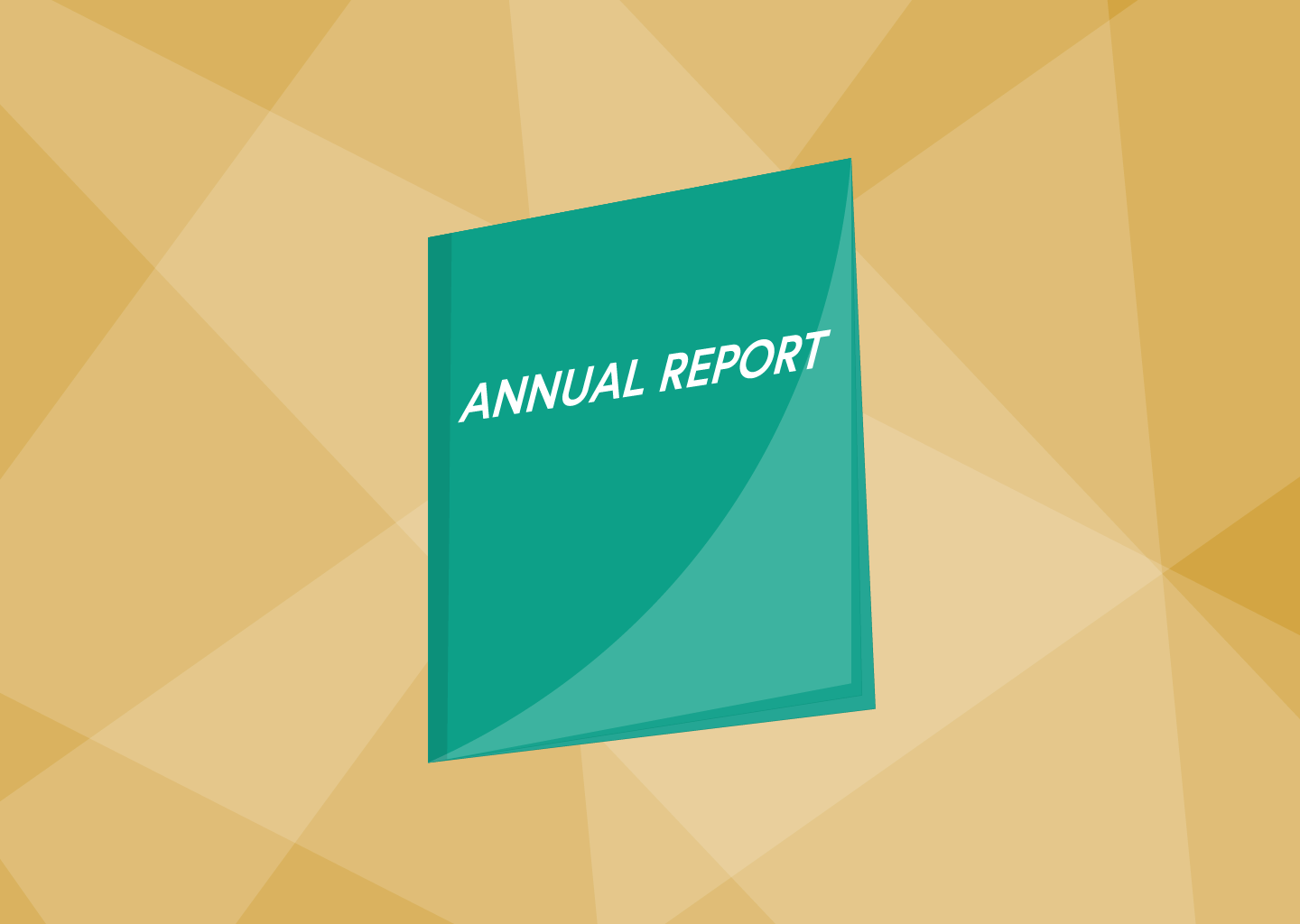
Nonprofit Annual Report: Creating Your Best One Yet! (+ 15 Examples!)
Imagine: it’s the end of the year and you’re celebrating all you’ve accomplished with your team. You sit down at your desk, do a couple of good chair stretches, get ready to write up your nonprofit annual report and… you blank.
So much has happened this past year, so where do you even start? What should you include? What should you leave out? How should you structure the document?
Making a nonprofit annual report can feel like a big undertaking! After all, it highlights all of your organization’s success, celebrates donation impact and lays out all the numbers to promote transparency. Plus, the story an impact report tells is key to promoting donor stewardship.
But don’t panic—we’ve got the answers and the tools to make it simple!
Here’s everything you need to know about writing an annual impact report, complete with a nonprofit annual report template.
What is a Nonprofit Annual Report and What’s its Purpose?
A nonprofit annual report is an end-of-year document that highlights your organization’s achievements from the past year. From celebrating campaign success to sharing benefactor stories to producing financial transparency, your annual report is a snapshot of how you’ve supported your mission.
This document also serves as a great big thank you for donors and volunteers! After all, your successes would not have been possible without them. Highlighting what you’ve achieved together is key to fostering donor stewardship.
A nonprofit annual report is similar to an impact report or donor report, but there are a few key differences:
- Annual reports lay out your accomplishments from the past year. They’re sent a couple of months after the financial year ends and provide a full overview of how you met your goals.
- Impact reports are typically sent out quarterly and are somewhat less common of a practice than annual reports. An impact report example could be highlighting the success of each quarterly campaign, which motivates your donors to support the next one.
- Donor reports are shorter, more frequent and very personalized. A donor impact report highlights—you guessed it!—donation impact and keeps your donors in the loop about what their support is helping you achieve.
Nonprofit annual reports aren’t technically required—an Annual Filing or filling out Form 990 are the only end-of-year documents you need to produce. However, that doesn’t mean annual reports aren’t important!
We won’t deny that making your annual report is a time commitment, which can feel difficult to spare during the rush of the end of year giving season. But with the way these reports build trust, donor stewardship and excitement for the year to come, you’ll feel the impact in both your wallet and your community.

10 Key Elements to Include in Your Nonprofit Annual Report
A year is long, and no doubt you’ve achieved all sorts of wonderful things! Here are some tips on distilling that information into what’s most useful for an annual impact report.
On a broad level, consider:
- Tone. Nonprofits typically benefit from being warm and personable—but they also need an element of authority! Your audience should trust that you know what you’re doing.
- Audience. Consider who you’re talking to. For example, if your demographic of donors are typically younger, they might prefer something more informal.
- Branding. Lay out your report in your organization’s branded fonts and colors. The document is celebrating your nonprofit, so it should wear your nonprofit’s clothes!
Now, the details! Here are 10 key elements to include in your nonprofit annual report:
1. Start with a table of contents
If this list includes 10 elements, you can probably imagine that there’s quite a bit of information your annual donor impact report will include! Make the reading experience smooth by including a table of contents.
Some of your dedicated supporters will want to read through the report front to back. Others might have specific areas of interest. For example, if one reader donated a huge sum to a specific campaign, they might just want to see how it played out.
A table of contents lets your readers know how to find the information that’s most interesting to them personally!
2. Add a letter from the President or Board Chair
Letters or messages from the Executive Director and Chair of the Board are standard fare in an annual report! After all, it’s super important for those leading the organization to sign off on the state of affairs and share their own pride in your accomplishments.
The opening letter can introduce the theme, summarize the content and give a personal touch to the report.
Your introduction should be:
- Short. A few succinct paragraphs will do the job. You don’t have to fill a page.
- Conversational. Don’t be afraid to let some personality shine through! Aim for a professional, but warm and friendly tone.
- Self-aware. If significant events are impacting your audience, organization or cause, briefly acknowledge that they’re there. Even a short nod to difficult circumstances, like, “Losing our building to a fire was incredibly challenging, but we’re still fighting the good fight,” can assure your audience that you’re in touch.
- Candid. It’s okay to acknowledge setbacks and challenges. In fact, it’s not a good idea to say how great the year was if it wasn’t! Your donors and supporters don’t expect perfection, but they do expect transparency.
- Positive. Be honest, but project a hopeful, positive attitude. Hint at a few things you’re excited about for the coming year. Stay upbeat!

Short and sweet gets the job done in this executive message from Sarnia-Lambton Rebound .
3. Put the mission front and center
Your annual report is, above all, an opportunity to showcase your mission.
It might feel redundant to emphasize your mission to people who’ve already supported it, but your supporters spend much less time thinking about the details of your mission than you do! They joined your organization for a reason—remind them what it is.
Include your mission statement in the report so the contents can directly show how your work is actively pursuing it.
The Voluntary Sector Reporting Awards (VSRAs) established Best Practices in Charity Annual Reporting . They recommend:
- Clearly stating the organization’s mission and tying it back to your activities throughout the report.
- Linking performance objectives and targets back to the mission.
- Disclosing your organization’s risks, issues and challenges in the context of the mission.
- Telling the reader how your organization governs itself and how that governance structure reflects your mission.
- Skipping out on individual committee reports in favor of a broad-based report that tells the organization’s story as a whole! The committee reports can be posted to the website if they are considered important disclosures.

Sarnia-Lambton Rebound reminds their supporters of their mission right from the beginning.
4. Highlight your major achievements
Don’t overwhelm your readers with every single detail—instead, choose your absolute highlights to celebrate in your annual impact report!
Gather a committee (or work with your board of directors!) and ask yourselves:
- If we could only tell donors about one thing we accomplished this year, what would it be? Don’t worry, you’ll be able to tell them about more than one! But see where the consensus is about your greatest successes.
- What are our key messages? The accomplishments you choose tell a story. What is it?
- Is there a theme that might be fitting? How do your key messages relate to each other? Is there a theme, like growth, perseverance, hope or family?
- How do these accomplishments relate to our mission? Spell it out, even if it feels very obvious! Again, clarity is key so that your supporters know exactly how you’ve helped support your constituents.

Navos shares their year’s accomplishments with quick facts and engaging graphics.
5. Drive more impact with storytelling
The best way to showcase your accomplishments is through storytelling . A long list of achievements or collection of facts might be exciting to you, but it won’t necessarily capture your donors’ hearts.
Telling a story helps associate emotions to events . Choose which stories best highlight your accomplishments and your overall mission.
A good nonprofit annual donor impact report story:
- Tells the truth. You can simplify a story and change details to protect privacy. However, the bones of the story should be true. After all, you’re using it as proof that you deserve support!
- Focuses on a central character. As I mentioned before, it’s easier to connect with the story of one person than a group. Use one named person as the subject of your story.
- Uses the person’s own words as much as possible to tell the story. Quotes and first-person narratives are most compelling.
- Shows a change as a result of the nonprofit’s action and the donors’ gifts. Use a storytelling structure with a beginning, middle and end to show what changed.
If you created a new program, introduce readers to the problem it solved via one person’s story. A great example is this one from Nuru-International , which focuses on the story of Josphat, a single farmer.

6. Present data in a visually appealing way
Nothing makes peoples’ eyes glaze over like a long block of text! If you want to engage your readers, it’s essential to present your data in a way that’s visually appealing.
Your nonprofit annual report could include:
- Attractive infographics. This will help your readers take in data at a glance! For example, breaking where your fundraising money went into a pie chart lets your readers see their donation impact without needing to dig.
- Compelling photographs. A picture’s worth a thousand words, right? With the right photo, all you need is a simple caption to get your point across.
- Consistent fonts. Don’t make your readers dizzy with a bunch of cluttered fonts! Stick to your branding all the way through to guide their eyes.
- Headings and subheadings. These features keep your impact report accessible and easy to scan. Make it easy for your readers to find what they’re looking for.
While the data itself is super important, how it’s laid out has an equal impact! If you know all the data but aren’t sure how to make it pretty, consult with your marketing or design experts.
7. Be transparent with a financial statement
It’s important to share your financial information in a way that makes sense to your audience. Give them an overview of where the revenue comes from and how it is spent.
You could do this with traditional financial statements, visual charts and graphs or infographics. By using plain English and clear visuals, your readers should understand the meaning behind the numbers in your annual impact report. Most importantly, they should always connect back to your mission, vision and values!

Aurora Cultural Centre promotes accountability, but doesn’t overwhelm their audience with their financial statement.

They also demonstrate what your numbers mean with visual organizers like charts and graphs.
8. Celebrate your donors
Many organizations decide to print the names of the year’s donors and the levels of their gifts in their annual report. This is a way to say thank you and show donors that they’re part of a large community of supporters!
Still—it’s a list of names, which means it’s likely to be skimmed. People look for their own names, but rarely read the entire list. Consider interspersing quotes and photos to get more value out of the pages.
And of course, make sure all spelling, titles and giving levels are correct. Double and triple check!
9. Recap events and milestones
Think of your nonprofit annual report as a celebration of your year’s greatest hits. What were the events you’re still talking about? What campaign moments had your whole team cheering?
Your members, donors and supporters have not had the same inside look into the organization as you. No matter how much they care about your mission, it’s very likely that they missed something during the year!
Brag away, and really lean into the impact these milestones had for your community. If these milestones link back to fundraising, lean into talking about donation impact.
10. Call to action: Keep the party going!
The work doesn’t stop with the annual report—in fact, it’s just beginning! The best impact report should inspire your donors to keep getting involved with your nonprofit.
Give them a next step with a strong call to action, reiterated throughout your report.
For most organizations, this will be an ask for donations, but don’t limit yourself! Inviting people to volunteer, follow your social media or advocate for your cause is just as good of a way to help your organization grow.

SC Thrive closes their report with more ways to get involved.
A Sample Annual Report Table of Contents
Setting up a table of contents is a great way to lay out expectations for readers—and to give you some structure starting out!
Annual reports are structured differently depending on the format and your organization’s goals. A traditional, printed report typically looks something like this:
- Welcome Letter/Introduction
- Summary of Highlights
- Financial Information
- Multiple Stories of Accomplishment
When it comes to your table of contents, you can either keep things simple and straightforward or get creative. Check out this annual impact report example from Feeding America .

This beautifully branded table of contents is attractive while also being super informative! You can easily see how long each section is at a glance.
How To Choose an Annual Report Format
With all of the room here for creativity, you might be wondering how to begin structuring your annual donor impact report.
Should it be printed and mailed? What images should you include? Is it really necessary to have every donor’s name listed?
While the answer to a lot of these questions will depend heavily on your organization, here are a few things to consider throughout the process.
Online Vs. Printed?
Before the age of the internet, annual reports were documents to be printed and mailed.These days, simply going digital is becoming more popular.
This is because posting your annual report online:
- Is more environmentally-friendly
- Saves you admin time
- Makes them easier for prospective members to read
If you have a group of donors who expect to receive a printed piece, feel free to make that option available upon request. It might also help you to conduct an online survey to get an idea of what your audience is looking for. After all, these reports are meant to connect you with your supporters!
What About Visuals?
As we mentioned earlier (and demonstrated in the Feeding America example!), visuals can be incredibly beneficial to your annual report. They keep the report dynamic, accessible and skimmable. Plus, who doesn’t love a good branding opportunity?
Note that digital annual reports also make it possible to use as many full-color images as you like! Another benefit to taking the online route.
15 Nonprofit Annual Report Examples to Get You Started
Want a little inspiration? Here you’ll find examples from charities, membership organizations and chambers of commerce. We’ve included organizations big and small, so there’s something for everyone! These are 15 of our favorite annual impact report examples:
1. Feeding America

What we like (again!):
- This annual impact report example is beautifully designed with a cohesive and engaging motif throughout. Text and easy-to-read visuals alternate.
- Real photos accompany the stories of people who benefit from the organization’s work, with a “special thanks” section which acknowledges the people who made it possible.
- Financials are creatively done with stacked plates.
- Lots of space is used to display the logos of corporate partners—they’re not squeezed onto one page, but spread over 23 pages.
2. NASA Goddard Space Flight Center

What we like:
- This annual impact report example has viewing options for either a pdf or interactive report hosted on issuu.com.
- Striking visuals of scientific accomplishments, complete with comprehensive explanations for supporters who might be less familiar with scientific terminology.
- The financial section is done with engaging, branded visuals and graphs.
- The impact is broken down by the scientific field it is relevant to.
3. Buffalo Niagara Partnership

- This annual report is a slideshow embedded on the organization’s website.
- Sponsors and partners are given priority by placing their gratitude content on the third page of the report. There is also recognition space in the last few pages.
- Lots of photos with brief but descriptive captions, avoiding lengthy blocks of text.
- The webpage where the annual report slideshow is embedded also houses a summary video and yet another list of key sponsors.
4. BC Cancer Foundation

- Instead of making a webpage, The BC Cancer Foundation has created an entirely separate website just for the annual report. Different sections of the report are accessible through links in the header, which stays in place as site visitors scroll through.
- The website is full of moving photos and animations, creating an engaging experience for the visitors.
- A large “Donate” button is always present in the top right corner, inviting people to donate as they read the inspiring stories within the report.
- Each section is collapsed to save scrolling space, but visitors can expand content if they’re interested in reading it in full.
5. Save the Children

- This annual impact report example is done as an interactive online slideshow. Viewers can not only click through slides, but also click to read captions, play video and audio content or click through mini galleries of photos.
- The report is full of moving stories and powerful photos. Because this is a report from 2020, the lead page shows a child with a mask, marking the way COVID shaped the year for the mission.
- Statistics are displayed over photos rather than just as graphics.
- Messages from the organization’s advocates are recorded as audio and can be played by clicking on their photos.
6. Florida Farm Bureau Federation

- This annual report is hosted on issuu.com.
- The annual report is framed with the theme “Rooted in Resilience,” with each section broken down into what that means. For example, being rooted in policy, community, membership, leadership, etc.
- There is a consistent plant-based theme and branding strategy.
- The report ends with photos of people working in grassroots initiatives.
7. American Dance Festival

- This annual report is hosted on issuu.com, with the option to download the slides. The link can be easily accessed from their About page on the main website.
- The numbers and stats are broken down in an attractive and readable graphic.
- Stunning images of the dancers in action are highlighted throughout the report.
- ADF Fund contributors are listed at the end, broken down by their level of giving.
8. It Gets Better Project

- The It Gets Better Project has an attractive branded annual report with optimistic messaging that reflects the organization’s mission, vision and values.
- A media representation timeline shows the full year’s reach and impact in an easy-to-understand visual.
- The financials are broken down into straightforward numbers in a colorful chart, and include a pie chart to further represent what it looks like.
- The report ends with a Year Ahead section which expresses hopes and plans for the future of the organization.
9. Salt Lake Chamber

What we like:
- This annual impact report example is housed on a dedicated page on the organization’s website.
- It starts with a video message from leadership.
- The “Highlights” section contains brief paragraphs, with links to read more.
- The report contains lots of embedded videos from events and award presentations.
- Public policy and membership statistics are clearly represented with engaging graphics.
10. Raising Readers in Story County

- This annual report has a unique infographic format. It’s very concise—only three pages!—but still showcases just as much impact as more lengthy reports.
- It includes achievements from the past year, program highlights, impressive statistics, quotes from parents and list of supporters.
- The design of the report is visually appealing and is representative of the community this organization serves: young children and their parents.
11. Greater Chicago Food Depository

- This annual impact report example is housed on its own website, with a bar on the right hand side to show visitors’ progress through the homepage. Plus, the homepage ends with a call to get involved.
- Many video elements: a welcome video from leadership, a video background on the homepage and video snippets to accompany impactful stats.
- Stories are presented as headlines and brief descriptions, with links to read them in full on other pages of the website.
- Sections like “About Us”, donor lists and financials can be found on other pages of the website through links in the header.
12. The Humane Society

- This annual report includes lots of large, impactful photos.
- Because this report is from 2020, it highlights the impact of the initial COVID-19 outbreak on the mission.
- It contains a spread summarizing the organization’s top achievements from the past year.
- Every story reminds us of both the short- and long-term visions that the story supports.
- There are lots of interesting facts and statistics throughout the report.
- The last page of the report is a brief summary of financials (a more detailed version can be downloaded from the organization’s website).
13. ChildFund

- This annual report is full of impactful stories about donors and people who have benefited from the support.
- It has lots of powerful photos and mini stories in their captions.
- Engaging graphics showcase statistics and impact.
- Colorful fonts reflect the fact that the beneficiaries are children.
14. Jackson Hole Chamber of Commerce
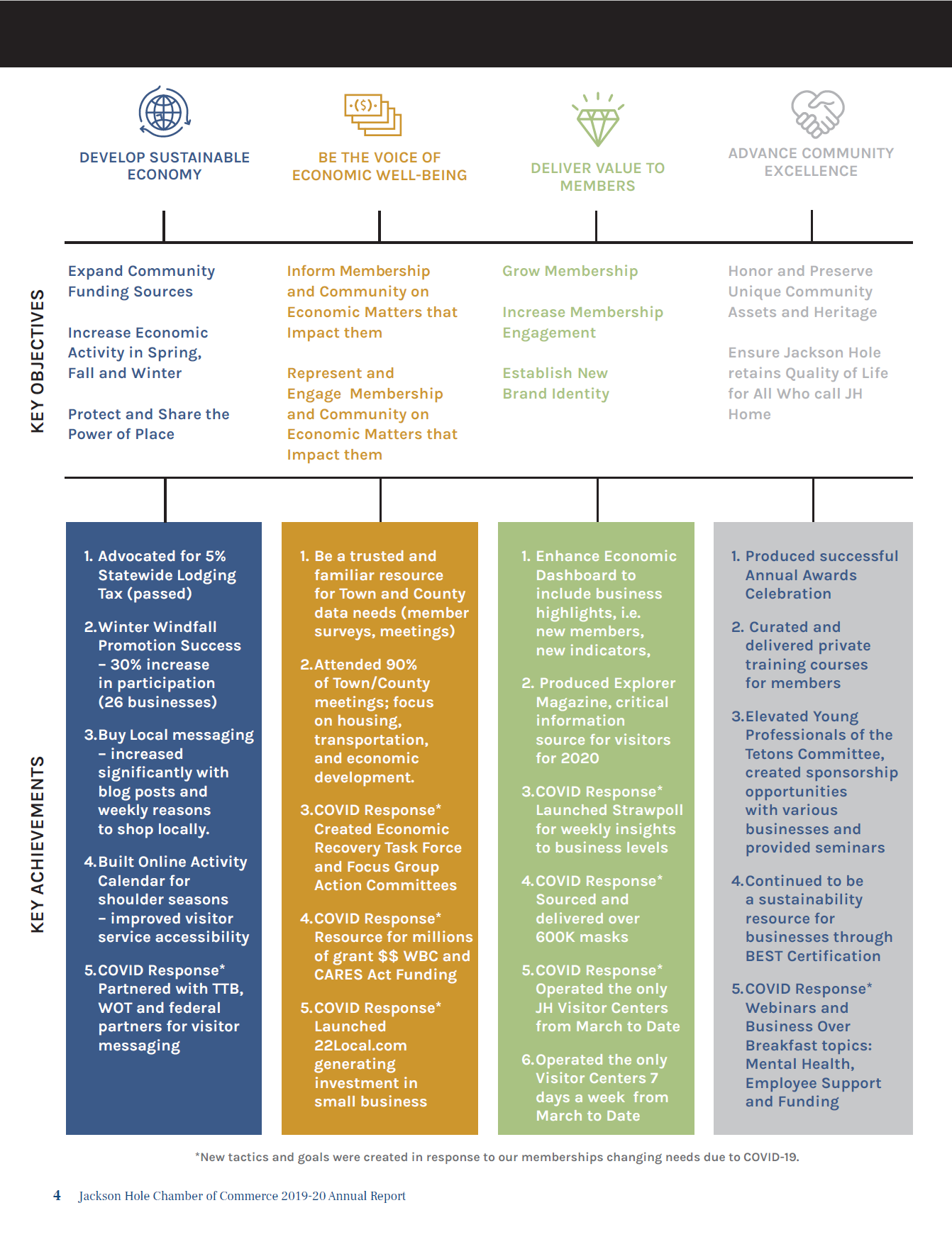
- This nonprofit annual report contains a page with a summary of key objectives and achievements from the past year, as well as how they align with the organization’s mission.
- There are lots of statistics and photos to accompany them.
- The report provides statistics about important areas of the organization such as membership, events, communications, resources, advocacy and partnerships.
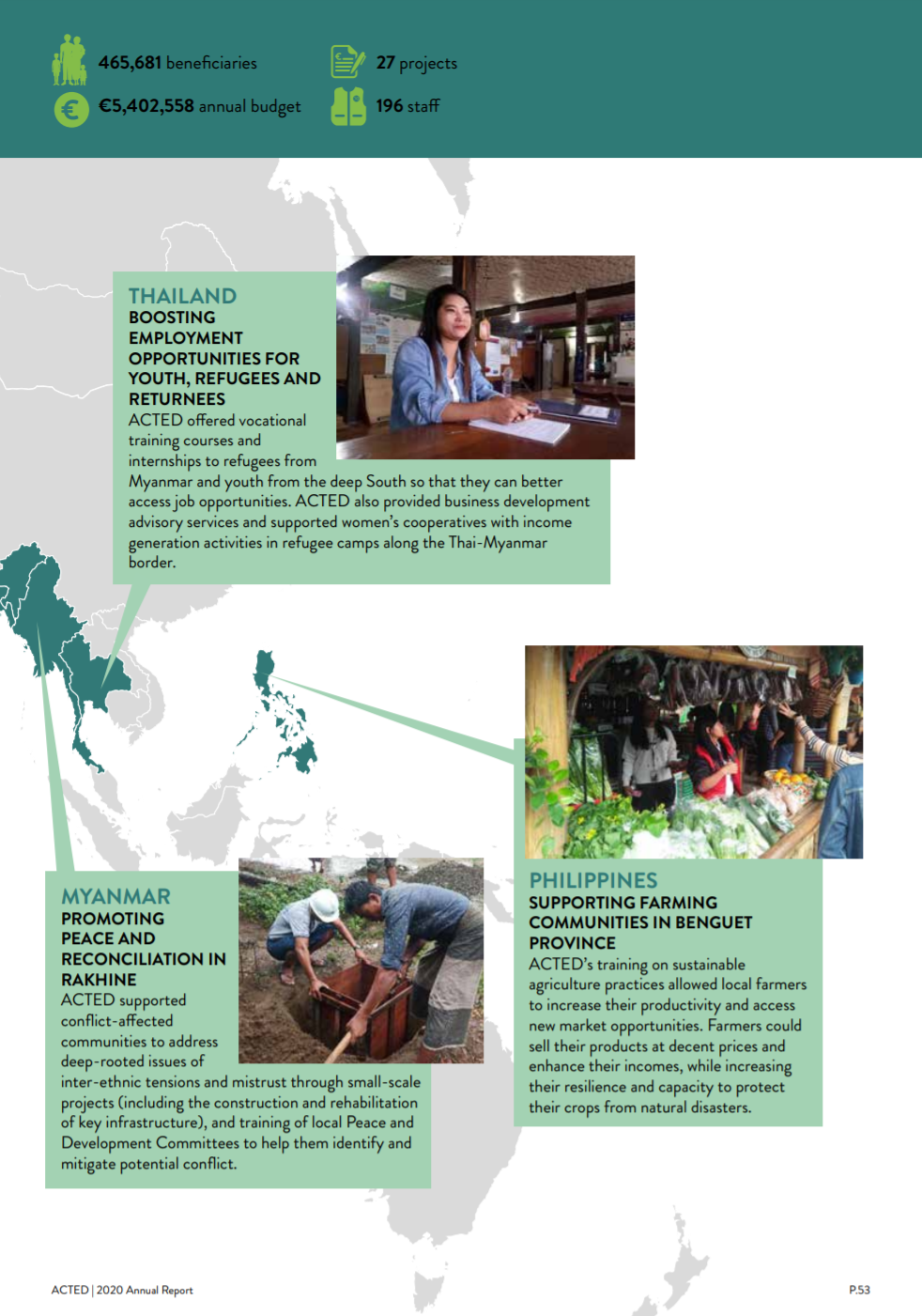
- The report starts with the organization’s reach and scale, their mission and values and their code of conduct and policies.
- Each impact story is accompanied by a few key statistics and a quote from someone who’s seen the organization’s impact first-hand.
- Worldwide impact is shown by visually connecting each country’s story to where it is on the world map.
- Full spread photos divide the report into sections.
Your Annual Report Checklist
Before you get started on your annual report, it can be majorly helpful to create a checklist of everything you need to know to make it happen.
Your checklist should help you determine your:
- Team members: Is there a project leader, committee or board support?
- Objective: Who’s your key audience, and what action do you want your report to inspire them to take?
- Format: Digital, print, video? A bit of everything?
- Outline: What do you want to include, and what will your Table of Contents end up looking like?
- Key messages and themes: Which accomplishments do you want to highlight? What is the story that this report tells?
- Budget: How much do you want to put into expenses like content development, graphic design and distribution?
- Production schedule: What’s your target release date, and what workback schedule do you need to hit it?
For more detail on what you might need, we’ve made an easy-to-follow annual report checklist to take away the guesswork!
Nonprofit Annual Report Template to Get You Started!
Don’t fear your annual report.
Creating an annual report can feel like a big task, but remember that all the information you need is already available! You already know how to tell a good story, communicate impact and show gratitude to donors. All that’s left is to follow a structure and get creative.
(And download our annual report checklist if you want a little extra help!)
Related Marketing Articles

Data Storytelling Do’s and Don’ts for Top-Tier Communication
The Nonprofit’s Guide to Augmented Reality (+12 Examples)

The Complete Guide to Nonprofit Email Marketing

The Membership Growth Report:
Benchmarks & insights for growing revenue and constituents.

- Rivers and Lakes
- Severe Weather
- Fire Weather
- Long Range Forecasts
- Climate Prediction
- Space Weather
- Past Weather
- Heating/Cooling Days
- Monthly Temperatures
- Astronomical Data
- Beach Hazards
- Air Quality
- Safe Boating
- Rip Currents
- Thunderstorms
- Sun (Ultraviolet Radiation)
- Safety Campaigns
- Winter Weather
- Wireless Emergency Alerts
- Weather-Ready Nation
- Cooperative Observers
- Daily Briefing
- Damage/Fatality/Injury Statistics
- Forecast Models
- GIS Data Portal
- NOAA Weather Radio
- Publications
- SKYWARN Storm Spotters
- TsunamiReady
- Service Change Notices
- Be A Force of Nature
- NWS Education Home
- Pubs/Brochures/Booklets
- NWS Media Contacts
NWS All NOAA
- Organization
- Strategic Plan
- Commitment to Diversity
- For NWS Employees
- International
- National Centers
- Social Media
Privacy Policy
National Weather Service
National Headquarters
National Forecast Maps
National forecast chart.
High Resolution Version | Previous Days Weather Maps Animated Forecast Maps | Alaska Maps | Pacific Islands Map Ocean Maps | Legend | About These Maps
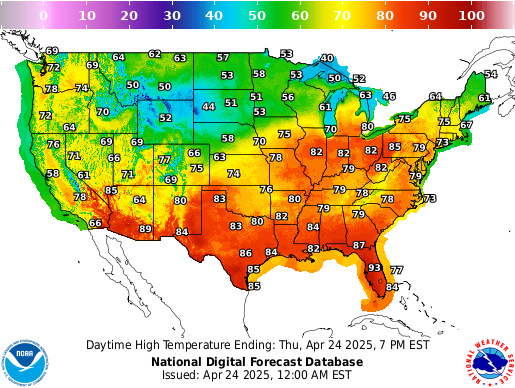
National Temperature
Alaska | Hawaii | Guam | Puerto Rico/Virgin Islands More from the National Digital Forecast Database
Short Range Forecasts
Short range forecast products depicting pressure patterns, circulation centers and fronts, and types and extent of precipitation.
12 Hour | 24 Hour | 36 Hour | 48 Hour
Medium Range Forecasts
Medium range forecast products depicting pressure patterns and circulation centers and fronts
Day 3 | Day 4 | Day 5 | Day 6
Precipitation Amounts
Quantitative precipitation forecasts.
Day 1 | Day 2 | Day 3
Surface Analysis
Highs, lows, fronts, troughs, outflow boundaries, squall lines, drylines for much of North America, the Western Atlantic and Eastern Pacific oceans, and the Gulf of Mexico.
Standard Size | High Resolution

Temperature
Maximum daytime or minimum overnight temperature in degrees Fahrenheit.
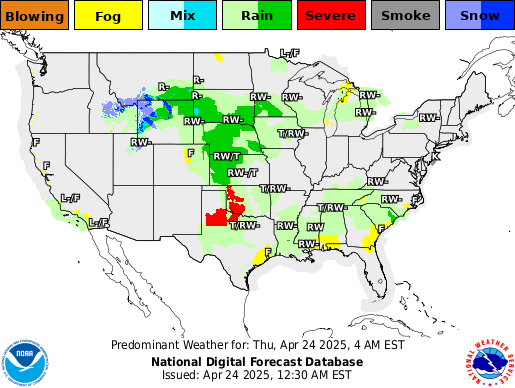
Predominant Weather
Expected weather (precipitating or non-precipitating) valid at the indicated hour. The weather element includes type, probability, and intensity information.

Wind Speed and Direction
Sustained wind speed (in knots) and expected wind direction (using 36 points of a compass) forecasts.
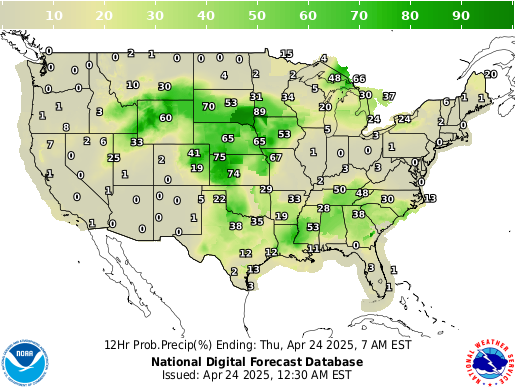
Chance of Precipitation
Likelihood, expressed as a percent, of a measurable precipitation event (1/100th of an inch).
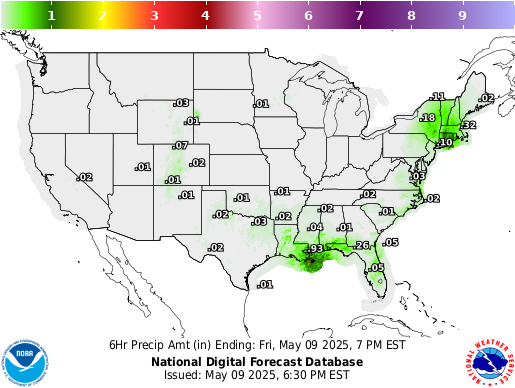
Precipitation Amount
Total amount of expected liquid precipitation.

Expected amount of opaque clouds (in percent) covering the sky.

Alaska Graphical Forecasts
Graphical forecasts from the National Digital Forecast Database for Alaska.

Hawaii Graphical Forecasts
Graphical forecasts from the National Digital Forecast Database for Hawaii.
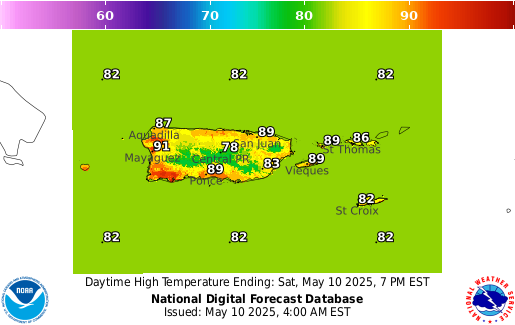
Puerto Rico Graphical Forecasts
Graphical forecasts from the National Digital Forecast Database for Puerto Rico and Virgin Islands.
ACTIVE ALERTS Warnings By State Excessive Rainfall and Winter Weather Forecasts River Flooding Latest Warnings Thunderstorm/Tornado Outlook Hurricanes Fire Weather Outlooks UV Alerts Drought Space Weather NOAA Weather Radio NWS CAP Feeds
PAST WEATHER Climate Monitoring Past Weather Monthly Temps Records Astronomical Data Certified Weather Data
CURRENT CONDITIONS Radar Climate Monitoring River Levels Observed Precipitation Surface Weather Upper Air Marine and Buoy Reports Snow Cover Satellite Space Weather International Observations
FORECAST Local Forecast International Forecasts Severe Weather Current Outlook Maps Drought Fire Weather Fronts/Precipitation Maps Current Graphical Forecast Maps Rivers Marine Offshore and High Seas Hurricanes Aviation Weather Climatic Outlook
INFORMATION CENTER Space Weather Daily Briefing Marine Climate Fire Weather Aviation Forecast Models Water GIS Cooperative Observers Storm Spotters Tsunami Warning System National Water Center International Weather
WEATHER SAFETY NOAA Weather Radio StormReady Heat Lightning Hurricanes Thunderstorms Tornadoes Rip Currents Floods Tsunamis TsunamiReady Winter Weather Ultra Violet Radiation Air Quality Damage/Fatality/Injury Statistics Red Cross Federal Emergency Management Agency (FEMA) Brochures Safe Boating
NEWS Newsroom Events Pubs/Brochures/Booklets
EDUCATION NWS Education Home Be A Force of Nature NOAA Education Resources Glossary JetStream NWS Training Portal NOAA Library For Students, Parents and Teachers Brochures
ABOUT Organization NWS Transformation Strategic Plan For NWS Employees International National Centers Products and Services Careers Glossary Contact Us Social Media
US Dept of Commerce National Oceanic and Atmospheric Administration National Weather Service 1325 East West Highway Silver Spring, MD 20910 Comments? Questions? Please Contact Us.
LATEST OSCARS NEWS
Follow the oscars:.


IMAGES
VIDEO
COMMENTS
2. Generate Key Financial Statements. The purpose of the annual report is to provide data and analysis regarding your company's operations and financial performance. As such, the financial statements it contains are essential. Important financial statements include your company's: Income statement.
Ideally, readers should be able to scan through the document and get the relevant information they need. Here are some pointers for a good annual report design: Use headings and subheadings. Devote space to photographs, infographics, and other compelling visual elements. Keep the text short and simple.
Create the header and table of contents. Introduce your report with a message from the CEO. Highlight year-end achievements. Detail key financial data. Create an overview of your market & industry. Introduce your leadership team. Highlight key projects and say thank you. Share your annual report as a link, monitor & evaluate.
To help kick off your planning, here's a high-level look at the steps you'll need to follow to create the annual report: Work out your timeline and plan content. Establish your structure and make a page plan. Write a list of contributors and gather content. Write and collate. Check the draft and send for review.
1. Plan and Prepare. Before writing, make a list of what you need to include in the report. You can start with the items listed above. Ask a supervisor or send out a survey to your customers and investors on what information they would like to be updated on. 2. Collect Data, Stats, Forms, and Statements.
1. Decide on a Key Message. The most important part of the planning and writing process of your annual report is to decide on a key message. Remember, the first part of the report is a great opportunity to highlight your achievements and the impact those achievements have had on your bottom line.
Evoke an emotional response using real-life photography. 8. World Bank's 2023 Annual Report. Altruism and philanthropy aren't the first words that come to mind when an organization has the word "bank" in its name. But World Bank isn't your average bank, and its 2023 Annual Report makes that very clear.
Despite this, there are specific elements that should be included in all annual reports, and we'll discuss those below. 1. Summarize your yearly goals and strategies. The first section of your annual report should summarize your yearly goals and strategies. This provides your audience with an overview of your annual focus and gives the ...
What to include in your annual report. While annual reports are a hugely flexible format, most reports include many of the following elements. A letter from the CEO or Board Chair. The letter from leadership is a chance to celebrate the year's accomplishments, and chart a course for the year ahead.
Annual Report: An annual report is a publication that public corporations must provide annually to shareholders to describe their operations and financial conditions. The front part of the report ...
Some good examples to follow: Pro tip: Make sure the design of your annual report ppt is in line with your brand and reflects your visual identity. 6. Replace table content with text in shapes. A PowerPoint shape can help make tables look better and easier to edit as you create annual report.
9 Annual Report Examples. 1. Focus on the Family. View Annual Report. Why this nonprofit annual report is great: They clearly communicate their mission. They communicate impact with detailed numbers. They are transparent with their budgeting and resourcing. They use social proof (testimonials of impact).
Distribute your annual report. 1. Brainstorm and create an outline. Before diving in and actually getting to work on writing your organization's annual report, brainstorm and create an outline so that you and your team can organize all of your thoughts and ideas. Annual reports are packed full of information, and you want to ensure that all ...
Interactivity. Many of the annual report examples that follow have a heavy focus on interactive design. Instead of leaning on rigid tables or run-of-the-mill pie charts, data visualizations present information in ways that are fresh and imaginative. Animation and scroll-triggered effects play a huge part in this.
It's also a great way to humanize your brand and let people tell your story. Example: Juvenile Welfare Board's video annual report lets families strengthened by JWB's services share their stories. Tip: If you really want to make an impression, brainstorm alternate presentations.
2. Balance Between Storytelling and Statistics. A balance between storytelling and statistics is a good approach to take when it comes to drafting your annual report. Statistics like the ones used by Heart to Heart International goes a long way to show impact. DREAM's 2016 Annual Report, makes incredible use of statistics too.
Step 1: Form an Annual Report Writing Committee. To ensure your annual report writing project is receiving the necessary attention throughout the year, consider forming an annual report writing committee. This committee would plan and execute/oversee all the activities in the annual report writing process. Make sure that your committee is fully ...
1. Start off with the shareholder's letter. This vital communication is written by the CEO or manager of the business and its tone sets the mood for the entire report. Care should be taken to remain inspiring and positive and inject a hint of personality into this personal communication. 2.
An annual report is a publication that a public corporation is required by law to publish annually. It describes the company's operations and financial conditions so that current and potential shareholders can make informed decisions about investing in it. The annual report is often split into two sections, or halves.
1. Start With a Clear Plan. The first step for every successful project at your nonprofit is creating a plan, and your annual report is no exception. You'll likely need the help of multiple team members or departments to assemble all of the information, as well as compile and design the document.
Here's how: 1. Keep your opening message short. I can't emphasize this enough. Short is a few succinct paragraphs, a half page, 200-300 words. Short is not asking your graphic designer to "make it fit," leaving audiences to squint at six-point font. Assume your reader is scanning. Make it easy to read. Use subheadings and bullet points.
Here are 10 key elements to include in your nonprofit annual report: 1. Start with a table of contents. If this list includes 10 elements, you can probably imagine that there's quite a bit of information your annual donor impact report will include! Make the reading experience smooth by including a table of contents.
Follow these practices to make sure your consulting clients leave the meeting energized and ready to take action. 1. Be Clear and Concise. A clear and concise presentation will allow the audience to understand the report's key points and be more likely to support the recommendations.
By Ollie Cooper, Money team. Estate agent fees are one of the big expenses in selling a house - but rule changes and the rise of private sale websites have made it more common for people to go it ...
National Weather Maps. Surface Analysis. Highs, lows, fronts, troughs, outflow boundaries, squall lines, drylines for much of North America, the Western Atlantic and Eastern Pacific oceans, and the Gulf of Mexico.
Oscars 2024 Presenters: Emily Blunt, America Ferrera, Steven Spielberg and More! By Oscars.com. Feb 29th, 2024. Oscars 2024 Presenters: Dwayne Johnson, Regina King, Jennifer Lawrence and More! By Oscars.com. Feb 28th, 2024. Jimmy Kimmel Back to Host 96th Oscars for the Fourth Time; Molly McNearney Returns as an Executive Producer. By Steve Dove.
Maine Audubon Society Native Plants Sale and Festival. 9 a.m. to 3 p.m., June 8, Gilsland Farm Audubon Center, 20 Gilsland Farm Road, Falmouth, 207-781-2330. maineaudubon.org. More than 75 species ...